| Page 1 |
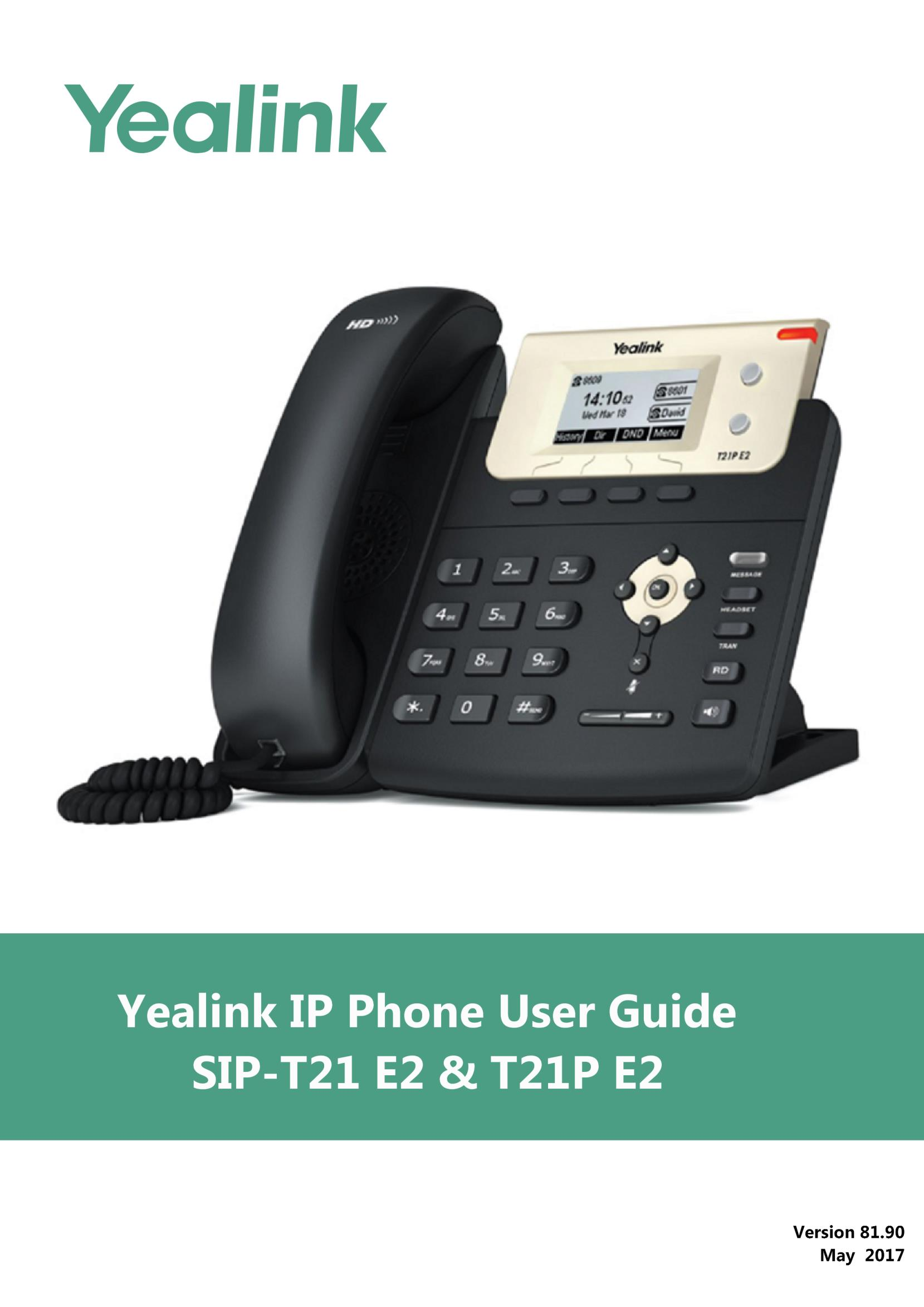
| Page 2 |
Copyright
Copyright © 2017 YEALINK(XIAMEN) NETWORK TECHNOLOGY
Copyright © 2017 Yealink (Xiamen) Network Technology CO., LTD. All rights reserved. No parts of this
publication may be reproduced or transmitted in any form or by any means, electronic or mechanical,
photocopying, recording, or otherwise, for any purpose, without the express written permission of
Yealink (Xiamen) Network Technology CO., LTD. Under the law, reproducing includes translating into
another language or format.
When this publication is made available on media, Yealink (Xiamen) Network Technology CO., LTD. gives
its consent to downloading and printing copies of the content provided in this file only for private use
but not for redistribution. No parts of this publication may be subject to alteration, modification or
commercial use. Yealink (Xiamen) Network Technology CO., LTD. will not be liable for any damages
arising from use of an illegally modified or altered publication.
Trademarks
Yealink®, the logo and the name and marks is trademark of Yealink (Xiamen) Network Technology CO.,
LTD, which are registered legally in China, the United States, EU (European Union) and other countries.
All other trademarks belong to their respective owners. Without Yealink’s express written permission,
recipient shall not reproduce or transmit any portion hereof in any form or by any means, with any
purpose other than personal use.
Warranty
(1) Warranty
THE SPECIFICATIONS AND INFORMATION REGARDING THE PRODUCTS IN THIS GUIDE ARE SUBJECT TO
CHANGE WITHOUT NOTICE. ALL STATEMENTS, INFORMATION, AND RECOMMENDATIONS IN THIS
GUIDE ARE BELIEVED TO BE ACCURATE AND PRESENTED WITHOUT WARRANTY OF ANY KIND, EXPRESS
OR IMPLIED. USERS MUST TAKE FULL RESPONSIBILITY FOR THEIR APPLICATION OF PRODUCTS.
(2) Disclaimer
YEALINK (XIAMEN) NETWORK TECHNOLOGY CO., LTD. MAKES NO WARRANTY OF ANY KIND WITH
REGARD TO THIS GUIDE, INCLUDING, BUT NOT LIMITED TO, THE IMPLIED WARRANTIES OF
MERCHANTABILITY AND FITNESS FOR A PARTICULAR PURPOSE. Yealink (Xiamen) Network Technology
CO., LTD. shall not be liable for errors contained herein nor for incidental or consequential damages in
connection with the furnishing, performance, or use of this guide.
(3) Limitation of Liability
Yealink and/or its respective suppliers are not responsible for the suitability of the information contained
in this document for any reason. The information is provided “as is”, and Yealink does not provide any
warranty and is subject to change without notice. All risks other than the reason of use are borne by the
recipient. In no event, even if Yealink has been suggested the occurrence of damages that are direct,
| Page 3 |
consequential, incidental, special, punitive or whatsoever (Including but not limited to loss of business
profit, business interruption or loss of business information), shall not be liable for these damages.
End User License Agreement
This End User License Agreement ("EULA") is a legal agreement between you and Yealink. By installing,
copying or otherwise using the Products, you: (1) agree to be bounded by the terms of this EULA, (2) you
are the owner or an authorized user of the device, and (3) you represent and warrant that you have the
right, authority and capacity to enter into this agreement and to abide by all its terms and conditions, just
as if you had signed it. The EULA for this product is available on the Yealink Support page for the product.
Patent Information
China, the United States, EU (European Union) and other countries are protecting one or more patents of
accompanying products and/or patents being applied by Yealink.
Customer Feedback
We are striving to improve our documentation quality and we appreciate your feedback. Email your
opinions and comments to DocsFeedback@yealink.com.
Technical Support
Visit Yealink WIKI (http://support.yealink.com/) for the latest firmware, guides, FAQ, Product documents,
and more. For better service, we sincerely recommend you to use Yealink Ticketing system
(https://ticket.yealink.com) to submit all your technical issues.
| Page 4 |
GNU GPL INFORMATION
Yealink SIP-T21(P) E2 IP phone firmware contains third-party software under the GNU General Public License (GPL).
Yealink uses software under the specific terms of the GPL. Please refer to the GPL for the exact terms and conditions of
the license.
The original GPL license, source code of components licensed under GPL and used in Yealink products can be
downloaded online:
http://www.yealink.com/GPLOpenSource.aspx?BaseInfoCateId=293&NewsCateId=293&CateId=293.
| Page 5 |
About This Guide

About This Guide
Thank you for choosing the SIP-T21 E2/SIP-T21P E2 (hereinafter referred to as SIP-T21(P) E2) IP
phone, exquisitely designed to provide business telephony features, such as Call Hold, Call
Transfer, Busy Lamp Field, Multicast Paging and Conference over an IP network. The difference
between the SIP-T21 E2 and SIP-T21P E2 IP phones is that only SIP-T21P E2 supports PoE.
This guide provides everything you need to quickly use your new phone. First, verify with your
system administrator that the IP network is ready for phone configuration. Also be sure to read
the Packaging Contents in this guide before you set up and use the SIP-T21(P) E2 IP phone.
S
ee the
Yeali
nk Products Regulatory Notices guide
for a
ll regulatory and safety guidan
c
e
.
In This Guide
Topics provided in this guide include:
Chapter 1
Overview
Chapter 2
Getting Started
Chapter 3
Customizing Your Phone
Chapter 4
Basic Call Features
Chapter 5
Advanced Phone Features
Summary of Changes
This section describes the changes to this guide for each release and guide version.
Changes for Release 81, Guide Version 81.90
Major updates have occurred to the following section:
Volume
on page
46
Changes for Release 81, Guide Version 81.70
The following section is new:
P
arking a Call/
Retriev
ing
a Parked C
all to the Monitored
U
ser
on page
138
Major updates have occurred to the following sections:
Entering
Data and Editing Fields
on page
32
v
| Page 6 |
User Guide for the SIP
Changes for Release 8
Changes for Release 8
Changes for Release 81, Guide Version 81.1

vi
-T21(P) E2 IP Phone
Configuring an Access URL
on page
61
DSS Keys
on page
69
Auto
Answer
on page
93
Do Not Disturb (DND)
on page
100
Call Forward
on page
105
Call Park
/
Retrieve
on page
120
Configuring
V
isual and
A
udio
A
lert for BLF
P
ickup
on page
132
Receiving RTP Stream
on page
150
BLF Ring Type is moved to Configuring Visual and Audio Alert for BLF Pickup on page 132.
1, Guide Version 81.20
None
1, Guide Version 81.15
The contents in the following section are removed to Frequently Asked Questions on Yealink IP
Phones
:
Troubleshooting
The following sections are new:
Power
Saving
on page
35
BLF ring type
on page
133
Major updates have occurred to the following section:
Incom
ing
I
ntercom
C
alls
on page
144
0
The following section is new:
Key
Tone
on page
49
Major updates have occurred to the following sections:
Basic Network Settings
on page
30
Language
on page
39
Phone
Lock
on page
43
Volume
on page
46
DSS Keys
on page
69
| Page 7 |
Changes for Release 80, Guide Version 80.
5
Changes for Release 80, Guide Version 80.
0

Dial Plan
on page
80
Call Mute
on page
98
Do Not Disturb (DND)
on page
100
Call Transfer
on page
112
Call Park
on page
120
Busy Lamp Field (BLF)
on page
131
Intercom
on page
143
Multicast Paging
on page
147
The following section is new:
Entering
Data and Editing Fields
on page
32
Major updates have occurred to the following sections:
Icon Instructions
on page
15
Optional Accessories
on page
24
Phone
Installation
on page
25
Appendix
on page
181
The following sections are new:
Shared Call Appearance (SCA)
on page
156
Bridge
d
Line Appearance (BLA)
on page
169
Major updates have occurred to the following sections:
Icon Instructions
on page
15
LED Instructions
on page
17
Web User Interface
on page
20
Call Forward
on page
104
9
6
About This Guide
vii
| Page 8 |
User Guide for the SIP-T21(P) E2 IP Phone

viii
| Page 9 |
Table of Contents

Table of Contents
About This Guide
................................
................................
...........
v
In This Guide
................................
................................
................................
................................
..............................
v
Summary of Changes
................................
................................
................................
................................
.............
v
Changes for Release 81, Guide Version 81.90
................................
................................
..........................
v
Changes for Release 81, Guide Version 81.70
................................
................................
..........................
v
Changes for Release 81, Guide Version 81.20
................................
................................
.........................
vi
Changes for Release 81, Guide Version
81.15
................................
................................
.........................
vi
Changes for Release 81, Guide Version 81.10
................................
................................
.........................
vi
Changes for Release 80, Guide Version 80.95
................................
................................
........................
vii
Changes for Release 80, Guide Version 80.60
................................
................................
........................
vii
Table of Contents
................................
................................
..........
ix
Overview
................................
................................
.......................
13
Hardware Component Instructions ............................................................................................................... 13
Icon Instructions
................................
................................
................................
................................
....................
1
5
Feature Status Icons......................................................................................................................................... 15
Line Key Icons
................................
................................
................................
................................
.....................
15
Other Icons
................................
................................
................................
................................
..........................
16
LED Instructions
................................
................................
................................
................................
.....................
17
User Interfaces ....................................................................................................................................................... 19
Phone User Interface
................................
................................
................................
................................
.......
19
Web User Interface........................................................................................................................................... 20
Documentations
................................
................................
................................
................................
....................
22
Getting Started
................................
................................
.............
23
Packaging Contents
................................
................................
................................
................................
.............
23
Optional A
ccessories
................................
................................
................................
................................
.......
24
Phone Installation
................................
................................
................................
................................
.................
25
Phone Initialization
................................
................................
................................
................................
...............
28
Phone St
atus
................................
................................
................................
................................
...........................
28
Basic Network Settings
................................
................................
................................
................................
.......
30
Registration
................................
................................
................................
................................
.............................
31
Idle Screen ............................................................................................................................................................... 32
Entering Data and Editing Fields..................................................................................................................... 32
ix
| Page 10 |
User Guide for the SIP-T21(P) E2 IP Phone

Customizing Your Phone
................................
.............................
35
General Settings .................................................................................................................................................... 35
Power Saving
................................
................................
................................
................................
......................
35
Contrast ................................................................................................................................................................ 38
Backlight
................................
................................
................................
................................
...............................
38
Language.............................................................................................................................................................. 39
Time & Date
................................
................................
................................
................................
........................
40
Administrator Password
................................
................................
................................
................................
.
42
Key As Send ........................................................................................................................................................ 42
Phone Lock
................................
................................
................................
................................
..........................
43
Audio Settings
................................
................................
................................
................................
........................
46
Volume
................................
................................
................................
................................
................................
..
46
Ring Tones
................................
................................
................................
................................
...........................
47
Key Tone
................................
................................
................................
................................
...............................
49
Contact Management ......................................................................................................................................... 49
Directory
................................
................................
................................
................................
...............................
50
Local Directory
................................
................................
................................
................................
...................
51
Blacklist ................................................................................................................................................................. 59
Remote Phone Book
................................
................................
................................
................................
........
61
Call History Management
................................
................................
................................
................................
..
63
Viewing History Records
................................
................................
................................
................................
63
Plac
ing a Call from History Records
................................
................................
................................
..........
63
Adding a Contact to the Local Directory/Blacklist
................................
................................
...............
64
Deleting History Records
................................
................................
................................
...............................
64
Disabling History Record
................................
................................
................................
...............................
65
Search Source List in Dialing ............................................................................................................................ 65
System Customizations....................................................................................................................................... 66
Logo Customization
................................
................................
................................
................................
.........
66
Headset Use
................................
................................
................................
................................
........................
67
DSS Keys
................................
................................
................................
................................
...............................
69
Account Management .................................................................................................................................... 79
Dial Plan
................................
................................
................................
................................
................................
80
Emergency Number
................................
................................
................................
................................
.........
86
Live Dialpad
................................
................................
................................
................................
.........................
87
Hotline
................................
................................
................................
................................
................................
...
87
Basic Call Features
................................
................................
........
89
Placing Calls ............................................................................................................................................................ 89
Answering Call
s
................................
................................
................................
................................
......................
92
Auto Answer ....................................................................................................................................................... 93
Ending Calls
................................
................................
................................
................................
.............................
94
Redialing Numbers
................................
................................
................................
................................
...............
94
x
| Page 11 |
Table of Contents

Recent Call In Dialing .......................................................................................................................................... 94
Auto Redial
................................
................................
................................
................................
..............................
96
Call Completion
................................
................................
................................
................................
.....................
97
ReCall
................................
................................
................................
................................
................................
.........
98
Call Mute .................................................................................................................................................................. 98
Call Hold/Resume
................................
................................
................................
................................
.................
99
Do Not Disturb (DND)
................................
................................
................................
................................
.......
100
Call Forward
................................
................................
................................
................................
..........................
105
Static Forwarding
................................
................................
................................
................................
............
105
Dynamic Fo
rwarding
................................
................................
................................
................................
.....
112
Call Transfer
................................
................................
................................
................................
...........................
112
Blind Transfer
................................
................................
................................
................................
....................
113
Semi
-
attended Transfer
................................
................................
................................
................................
115
Attended Transfer
................................
................................
................................
................................
...........
115
Call Waiting
................................
................................
................................
................................
...........................
116
Conference
................................
................................
................................
................................
............................
117
Local Conference
................................
................................
................................
................................
............
117
Network Co
nference
................................
................................
................................
................................
......
118
Call Park/Retrieve
................................
................................
................................
................................
................
120
FAC Mode
................................
................................
................................
................................
..........................
121
Transfer Mode
................................
................................
................................
................................
..................
123
Call Pickup
................................
................................
................................
................................
.............................
125
Directed Call Pickup
................................
................................
................................
................................
.......
125
Group Call Pickup
................................
................................
................................
................................
...........
127
Anonymous Call
................................
................................
................................
................................
..................
129
Anonymous
Call Rejection
................................
................................
................................
..............................
130
Advanced Phone Features
................................
.........................
131
Busy Lamp Field (BLF)
................................
................................
................................
................................
........
131
Config
uring the BLF Feature on the IP Phone
................................
................................
.....................
131
Using BLF Feature on the Phone
................................
................................
................................
..............
136
BLF List
................................
................................
................................
................................
................................
....
138
Call Recording
................................
................................
................................
................................
......................
140
Configuring
a Record Key
................................
................................
................................
...........................
140
Configuring a URL Record Key
................................
................................
................................
..................
141
Recording a Call
................................
................................
................................
................................
..............
141
Hot Desking
................................
................................
................................
................................
..........................
142
Intercom
................................
................................
................................
................................
................................
.
143
Configuring the Intercom Feature on the IP Phone
................................
................................
..........
144
Using Intercom
................................
................................
................................
................................
................
146
Multicast Paging
................................
................................
................................
................................
..................
147
Sending RT
P Stream
................................
................................
................................
................................
......
147
Receiving RTP Stream
................................
................................
................................
................................
...
150
Using Multicast Paging
................................
................................
................................
................................
.
152
xi
| Page 12 |
User Guide for the SIP-T21(P) E2 IP Phone

Music on Hold (MoH)
................................
................................
................................
................................
........
153
Automati
c Call Distribution (ACD)
................................
................................
................................
...............
154
Shared Call Appearance (SCA)
................................
................................
................................
.......................
156
Configuring SCA Feature on the IP Phone
................................
................................
...........................
156
Using SCA Feature on the IP Phone
................................
................................
................................
........
16
2
Bridged Line Appearance (BLA)
................................
................................
................................
.....................
169
Configurin
g
BLA
Feature
on the IP Phone
................................
................................
............................
169
Using BLA Feature on the IP Phone
................................
................................
................................
.........
172
Messages
................................
................................
................................
................................
................................
174
Short Message Service (SMS)
................................
................................
................................
.....................
174
Voice Mail
................................
................................
................................
................................
..........................
176
Message Waiting Indicator (MWI)
................................
................................
................................
...........
177
Appendix
................................
................................
.....................
181
Appendix A
–
Time Zones
................................
................................
................................
................................
181
Appendix B
–
Menu Structure
................................
................................
................................
........................
183
Index
................................
................................
...........................
185
xii
| Page 13 |
Overview

Overview

This chapter provides the overview of the SIP-T21(P) E2 IP phone. Topics include:
Hardware Component
Instructions
Icon Instructions
LED Instructions
User
Interface
s
Documentation
s
If you require additional information or assistance with your new phone, contact your system
administrator.
Hardware Component Instructions
The main hardware components of the SIP-T21(P) E2 IP phone are the LCD screen and the
keypad.
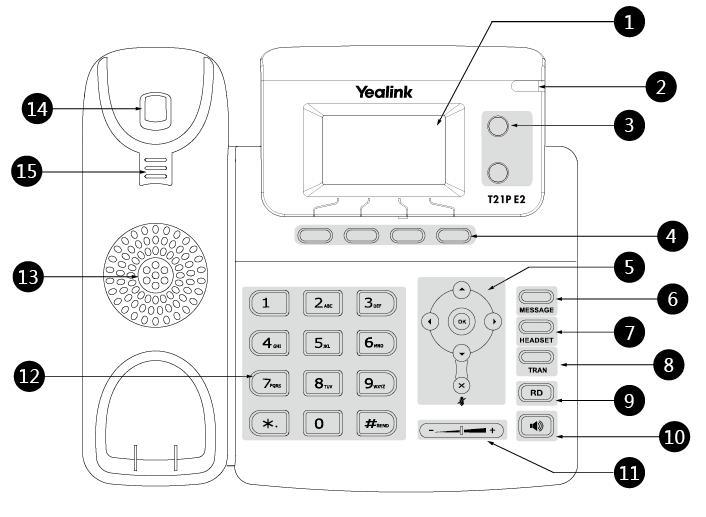
13
| Page 14 |
User Guide for the SIP
Hardware component instructions of the



①


②

③

④

⑤

⑥

⑦

⑧

⑨

⑩
⑪
⑫
⑬
⑭

⑮

14
-T21(P) E2 IP Phone


Item


LCD Screen



Power Indicator LED


Line Keys


Soft Keys




MESSAGE Key

HEADSET Key

TRAN Key

RD Key

Speakerphone Key

Volume Key

Keypad

Speaker

Hookswitch

Reversible Tab
SIP-T21(P) E2 IP phone are:


Description


Shows information about calls, messages, soft keys, time, date


and other relevant data:


• Default account

• Call information—caller ID, call duration

• Icons (for example, )

• Missed call text or second incoming caller information

• Prompt text (for example, "Saving config file!")
• Time and date

Indicates call status, message status and phone’s system

status.

• Receives an incoming call—Fast-flashing
• Receives a voice mail or text message—Slow-flashing

Use these keys to activate up to two accounts and assign

various features.

Label automatically to identify their context-sensitive features.

Scroll through the displayed information.

Confirms actions or answers incoming calls.

Cancels actions, rejects incoming calls, mutes or un-mutes

calls.

Indicates and accesses voice mails.

Toggles the headset mode.

Transfers a call to another party.

Redials a previously dialed number.

Toggles the hands-free (speakerphone) mode.

Adjusts the volume of the handset, headset, speaker or ringer.

Provides the digits, letters and special characters in

context-sensitive applications.

Provides hands-free (speakerphone) audio output.

• Picking up the handset from the handset cradle, the

hookswitch bounces and the phone connects to the line.

• Laying the handset down on the handset cradle, the phone

disconnects from the line.

Secures the handset in the handset cradle when the IP phone

is mounted vertically. For more information on how to adjust

the reversible tab, refer to Yealink Wall Mount Quick
























































































































































Installation Guide for Yealink IP Phones
.
| Page 15 |
Icons appearing on the status bar are described in the following table:
line key label

Icon Instructions
Feature Status Icons

Icons





















Line Key Icons

Icons appearing on the


Overview


Description



Network is unavailable



Hands-free (speakerphone) mode


Handset mode


Headset mode


Voice Mail

Text Message

Auto Answer

Do Not Disturb (DND)

Ringer volume is 0

Phone Lock

Keep Mute

Missed Calls

Call Forward

are described in the following tables:
































































































15
| Page 16 |
associated with line
associated with ACD
when accessing features
associated with call recording
User Guide for the SIP-T21(P) E2 IP Phone

Icon indicator (

Icons










Icon indicator (


Icon



and x




Other Icons


Icons appearing

Icon indicator (

Icons





16
)


)


Description


The private line registers successfully


Register failed


Registering

The shared/bridged line registers successfully

DND is enabled on this line

Call forward is enabled on this line

Description

The ACD state is available

The ACD state is unavailable

The ACD state is Wrap up

Log out of the ACD system

are described in the following tables:

)

Description

Recording box is full

A call cannot be recorded














































































































































Recording starts successfully
| Page 17 |
associated with call history
associated with contact

Icons




Icon indicator (

Icons







Icon indicator (


Icons


LED Instructions

Power Indicator LED


LED Status

Solid red


Fast-flashing red (300ms)

Slow-flashing red (1s)


Off

Line key LED


LED Status

Solid green
Overview


Description



Recording cannot be started



Recording cannot be stopped


)


Description


Received Calls

Placed Calls

Missed Calls

Forwarded Calls

)

Description

The contact icon

Description

The phone is initializing.

The phone is ringing.

The phone receives a voice mail or text message.

The phone is powered off.

The phone is idle.


The phone is busy.


The call is placed on hold or is held.

The call is muted.

Description

The line is seized.
















































































































































































17
| Page 18 |
(configured as a BLF key or BLF List key)
associated with a shared line
ates the phone is involved in a
phone indicates the phone is not involved in the SCA call.
User Guide for the SIP-T21(P) E2 IP Phone

LED Status


Fast-flashing green

Slow-flashing green

Off

Line key LED

LED Status

Solid green

Fast-flashing red (200ms)

Solid red

Slow-flashing red (1s)

Off

Line key LED (

The local SCA phone indic

LED Status


Off

Fast-flashing green

Solid green (for local SCA

phone)

Solid red (for monitoring SCA

phone)

Slow-flashing green (for local

SCA phone)

Slow-flashing red (for

monitoring SCA phone)

Slow-flashing green (for local

SCA phone)

Solid red (for monitoring SCA

phone)



18


Description



The line is in conversation.



The line receives an incoming call.


The call is placed on hold.


The line is inactive.



Description

The monitored user is idle.

The monitored user receives an incoming call.

The monitored user is busy.

The monitored user’s conversation is placed on hold

(This LED status requires server support).

The call is parked against the monitored user’s phone

number.

The monitored user does not exist.

)

SCA call, while the monitoring SCA


Description

The shared line is idle.

The shared line receives an incoming call.

The shared line is in conversation.

The shared line is dialing.

The shared line is seized.

The shared line conversation is barged in by the other

shared line party.

The shared line conversation is placed on public hold.

The shared line conversation is placed on private hold.

For a multi-party call, all the shared line parties

participating in this call place the shared line


conversation on hold.

























































































































| Page 19 |
Overview

Line key LED (associated with a bridged line)
The local BLA phone indicates the phone is involved in a BLA call, while the monitoring BLA
phone indicates the phone is not involved in the BLA call.


LED Status
Description



Off
The bridged line is idle.


Fast-flashing green
The bridged line receives an incoming call.



Solid green
phone)
(for local
BLA
The bridge
d
line is in conversation.


Solid red (for monitoring BLA
The bridged line is dialing.


phone)
The bridged line is seized.



Slow-flashing green (for local

BLA
Slow
phone)
-
f
lashing
red
(for
The bridge
d
line conversation is placed on hold.

monitoring BLA phone)

Note
The above introduces the default LED status. The statuses of the power indicator LED and BLF key

LED are configurable via web user interface. You can also customize the BLF key LED status and

BLF key behavior. For more information, contact your system administrator.

User Interfaces

Two ways to customize configurations of your SIP-T21(P) E2 IP phone:

T
he
u
ser
i
nterface on the IP phone.

T
he
u
ser
i
nterface in a
web
browser
on
your PC.

The hardware components keypad and LCD screen constitute the phone user interface, which

allows the user to execute all call operation tasks and basic configuration changes directly on

the phone. In addition, you can use the web user interface to access all configuration settings. In

many cases, either the phone user interface and/or the web user interface interchangeably.

However, in some cases, it is only possible to use one or the other interface to operate the

phone and change settings.

Phone User Interface

You can customize your phone by pressing the Menu soft key to access the phone user

interface. The Advanced Settings option is only accessible to the administrator, and the default

administrator password is “admin” (case-sensitive). For more information on customizing your

phone with the available options from the phone user interface, refer to Customizing Your

Phone on page 35.

Note
For a better understanding of the menu structure, please refer to Appendix B – Menu Structure

on page 183.

























19
| Page 20 |
User Guide for the SIP-T21(P) E2 IP Phone

Web User Interface
In addition to the phone user interface, you can also customize your phone via web user
interface. In order to access the web user interface, you need to know the IP address of your
new phone. To obtain the IP address, press the OK key on the phone when the phone is idle.
Enter the IP address (e.g., http://192.168.0.10 or 192.168.0.10 for IPv4;
http://[2005:1:1:1:215:65ff:fe64:6e0a] or [2005:1:1:1:215:65ff:fe64:6e0a] for IPv6) in the address
bar of a web browser on your PC. The default administrator user name and password are both
“admin” (case-sensitive).
Note
The access to the Advanced settings of the Account or Network via web user interface may be

blocked by the web browser (e.g., Chrome, Firebox) if you have installed “Adblock Plus plugin”.

The options you can use to customize the IP phone via phone user interface and/or via web user

interface are listed in the following table:


Options
Phone User Interface
Web User Interface



Status



--IPv4



--MAC


--Firmware
√
√


--Network



--Phone


--Accounts


Basic Phone Settings


--Power Saving
x

--Contrast
√

--Backlight
√

--Language
√

--Time & Date
√

--Administrator Password
√

--Key As Send
√

--
--
Phone Lock
Audio Settings
√
√

--Ring Tones
√

--Key Tone
√

--Contact Management

--Directory
x

--Local Directory
√

--Blacklist
√

--Remote Phone Book
x

--Call History Management
√




















































































































































































































































20
| Page 21 |

Options


--Search Source List in Dialing


--Logo Customization


--Headset Use

--DSS Keys

--Account Management

--Dial Plan

--Emergency Number

--Live Dialpad

--Hotline

Basic Call Features

--Recent Call In Dialing

--Auto Answer

--Auto Redial

--Call Completion

--ReCall

-- Do Not Disturb (DND)

--Call Forward

--Call Transfer

--Call Waiting

--Conference

--Call Park

--Call Pickup

--Anonymous Call

--Anonymous Call Rejection

Advanced Phone Features

--Busy Lamp Field (BLF)

--BLF List

--Call Recording

--Hot Desking

--Intercom

--Multicast Paging

--Music on Hold

--Automatic Call Distribution (ACD)

--Shared Call Appearance (SCA)

--Bridged Line Appearance (BLA)

--Messages

SIP Account

--User Options

--Activation

--Label

--Display Name
Overview


Phone User Interface
Web User Interface



x


x


√


√



√

x

x


x

√


x

√

√

√

√

√

√
√

√

√

x

√

√

√

√


√

x

√

√

√
√
√

x

x

x

x

√



√
√

√

√





































































































































































































































































































































































21
| Page 22 |
User Guide for the SIP
evant
Documentation
T21(P) E2
http://support.yealink.com/documentFront/forwardToDocumentDetailPage?documentId=77

Note
Note
22
-T21(P) E2 IP Phone


Options
Phone User Interface


--Register Name
√


--User Name
√



--Password
√

--
Server Option
--
SIP
Server
s
1/2
√

--Register Port
x

--Outbound Status
√

--Outbound Proxy1/2
√

--Proxy Fallback Interval
√

--NAT Status
√

The table above lists most of the feature options. Please refer to the rel

information.

s

The following table shows documentations available for the SIP-

Name
Contents
Where found

Quick Start
Basic call features
In the package

Guide
and phone
customizations
On the website

Phone/Web user

interface settings

User Guide
Basic call features
On the website

and advanced

phone features

You can also download the latest documentations online:


Web User Interface



sections for more



IP phone.


Language



English

English/Chinese

English/Chinese



























































































































































































.
| Page 23 |
Getting Started
If you require additional information or assistance with your new phone, contact your system

Getting Started
This chapter provides basic installation instructions and information for obtaining the best
performance with the SIP-T21(P) E2 IP phone. Topics include:
Pack
ag
ing
Contents
Phone
Installation
Phone Initialization
Phone Status
Basic Network Settings
Registration
Idle Screen
Entering
Data
and
Editing
Fields
administrator.
Packaging Contents
The following components are included in your SIP-T21(P) E2 IP phone package:
SIP
-
T21(P) E2
IP
P
hone
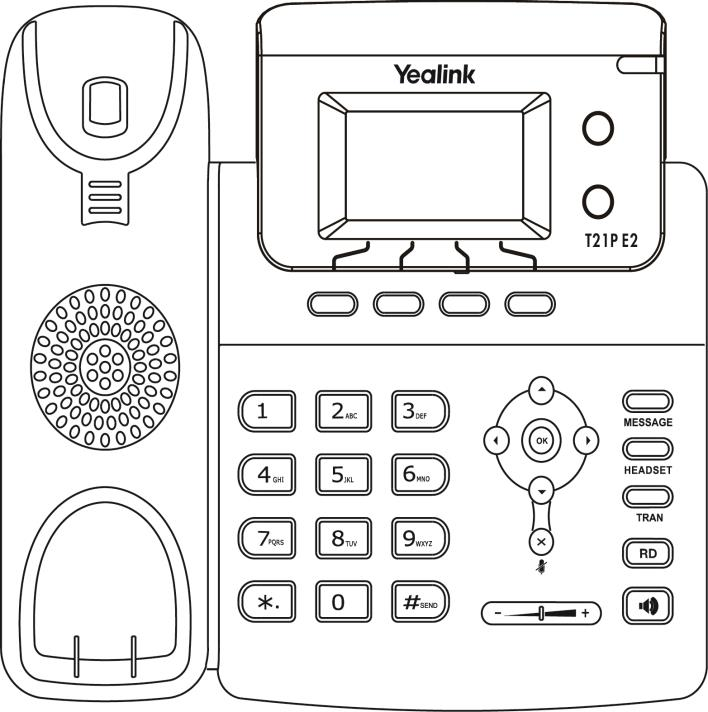

23
| Page 24 |
User Guide for the SIP-T21(P) E2 IP Phone

Phone Stand

Handset & Handset Cord

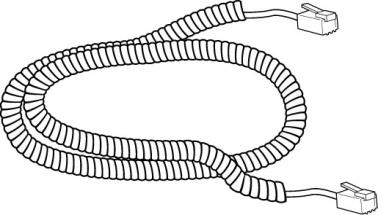
Ethernet Cable
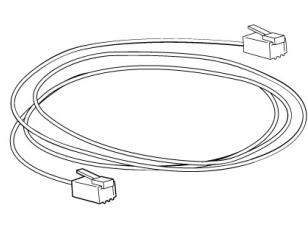
Quick Start Guide

Check the list before installation. If you find anything missing, contact your system
administrator.
Optional Accessories
The following items are optional accessories for your SIP-T21(P) E2 IP phone. You need to
purchase them separately if required.
24
| Page 25 |
Getting Started
. The use of
Phone

Note
Power Adapter
(5.5mm DC plug)
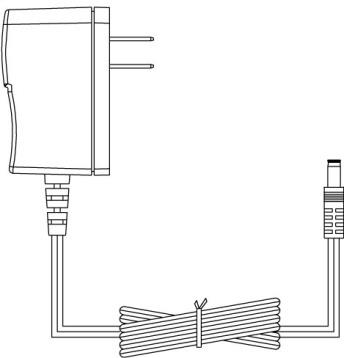
Headset
YHS32/YHS33
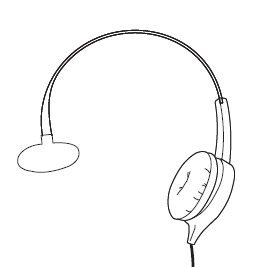
We recommend that you use the accessories provided or approved by Yealink

unapproved third-party accessories may result in reduced performance.

Installation
If your phone is already installed, proceed to Phone Initialization on page 28.
This section introduces how to install the phone:
1) Attach the stand
2) Connect the handset and optional headset
3) Connect the network and power
25
| Page 26 |
User Guide for the SIP-T21(P) E2 IP Phone

1)
Attach the stand
Note
The reversible tab has a lip which allows the handset to stay on-hook when the IP phone is
mounted vertically.
2)
Connect the handset and optional headset
26




| Page 27 |
Note
Note

Getting Started
3)
Connect the network and power
You have two options for power and network connections. Your system administrator will advise
you which one to use.
AC power
Power over Ethernet (PoE)
PoE is not applicable to the SIP-T21 E2 IP phone.


AC Power
To connect the AC power:
1.
Connect the DC plug on the power adapter to the DC5V port on the phone and connect
the other end of the power adapter into an electrical power outlet.
2.
Connect the included or a standard Ethernet cable between the Internet port on the phone
and the one on the wall or switch/hub device port.
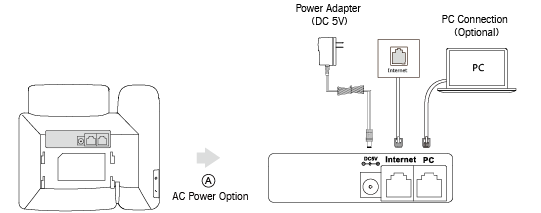
The IP phone should be used with Yealink original power adapter (5V/600mA) only. The use of

the third-party power adapter may cause the damage to the phone.

Power over Ethernet

With the included or a regular Ethernet cable, the SIP-T21P E2 IP phone can be powered from a
PoE-compliant switch or hub.
27
| Page 28 |
User Guide for the SIP
Phone Initialization
Phone Status

Note
Note
28
-T21(P) E2 IP Phone
To connect the PoE for the SIP-T21P E2 IP phone:
1.
Connect the Ethernet cable between the Internet port on the phone and an available port
on the in-line power switch/hub.
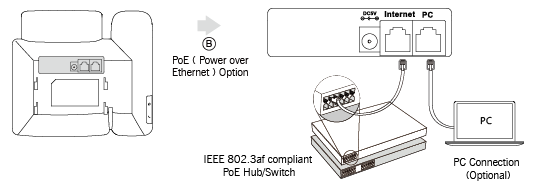
If in-line power is provided, you don’t need to connect the phone to the power adapter. Make

sure the switch/hub is PoE-compliant.
The phone can also share the network with another network device such as a PC (personal
computer). This is an optional connection. We recommend that you use the Ethernet cable
provided by Yealink. The PC port may be disabled, contact your system administrator for more
information.
Important! Do not remove power from the phone while it is updating firmware and
configurations.

After your phone is powered on, the system boots up and performs the following steps:
Automatic Phone Initialization
The phone finishes the initialization by loading the saved configuration. The LCD screen displays
“Welcome Initializing…please wait” during this process.
DHCP (Dynamic Host Configuration Protocol)
The phone attempts to contact a DHCP server in your network to obtain valid IPv4 network
settings (e.g., IP address, subnet mask, default gateway address and DNS address) by default.

If your network does not use DHCP, proceed to Basic Network Settings on page 30.

You can view phone status via phone user interface or web user interface.
Available information of phone status includes:
| Page 29 |
Getting Started
product ID, MAC address
To v
To v

1.
2.
1.
2.
3.
4.
Network status (IPv4 status or IPv6 status, IP mode and MAC address).
-
IPv4 uses a 32-bit address.
-
IPv6 is an updated version of the current Internet Protocol to meet the increased
demands for unique IP addresses, using a 128-bit address.
Phone status (product name, hardware version, firmware version,
and device certificate status).
Account status (register status of SIP accounts).
iew the phone status via phone user interface:

Press , or press Menu->Status.

Press or to scroll through the list and view the specific information.



iew the phone status via web user interface:
Open a web browser of your computer.
Enter the IP address in the browser’s address bar, and then press Enter key.
(e.g., “http://192.168.0.10” for IPv4 or “http://[2005:1:1:1:215:65ff:fe64:6e0a]” for IPv6).
Enter the user name (admin) and password (admin) in the login page.
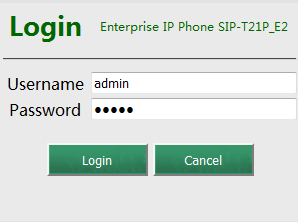

Click Login to login.
29
| Page 30 |
User Guide for the SIP
Basic Network Settings

Note
30
-T21(P) E2 IP Phone
The phone status is displayed on the first page of the web user interface.
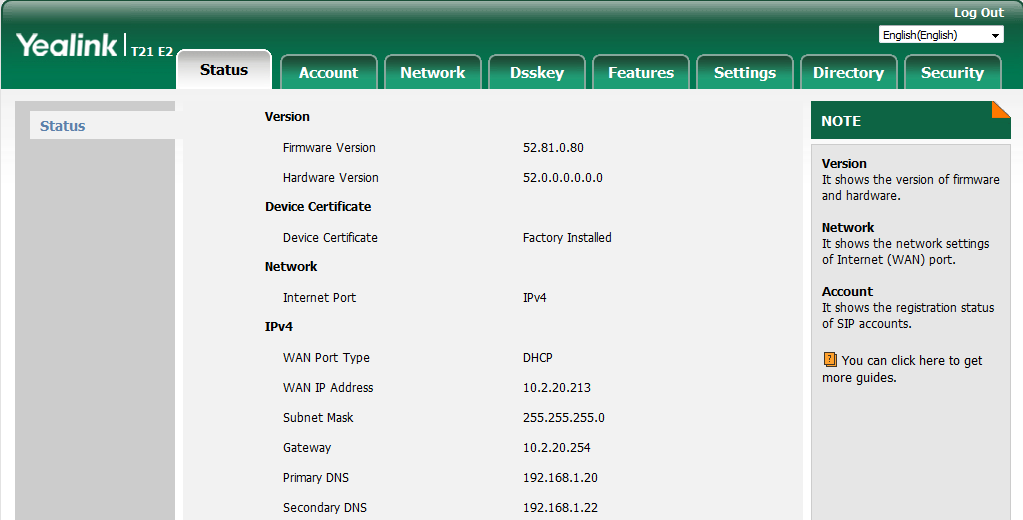

If IP mode of the phone is configured as IPv4 & IPv6, you can enter either of them in the

browser’s address bar to view the phone status. IPv6 is not available on all servers. Contact your
system administrator for more information.


If your phone cannot contact a DHCP server for any reason, you need to configure network
settings manually. The IP phone can support either or both IPv4 and IPv6 addresses.
To configure the IP mode via phone user interface:
1. Press Menu->Settings->Advanced Settings (default password: admin)
->Network->WAN Port.

2. Press or to select IPv4, IPv6 or IPv4 & IPv6 from the IP Mode field.



3. Press the Save soft key to accept the change or the Back soft key to cancel.
You can configure a static IPv4 address for the IP phone. Before configuring it, make sure that
the IP mode is configured as IPv4 or IPv4 & IPv6.
To configure a static IPv4 address via phone user interface:
1.
Press Menu->Settings->Advanced Settings (default password: admin)
->Network->WAN Port.
| Page 31 |
Getting Started

2.
Press to select the IPv4 and then press the Enter soft key.

3.
Press to select Static IPv4 Client and then press the Enter soft key.

4.
Enter the desired value in the IP Address, Subnet Mask, Default Gateway, Pri.DNS and
Sec.DNS field respectively.


5.
Press the Save soft key to accept the change or the Back soft key to cancel.
You can configure a static IPv6 address for the IP phone. Before configuring it, make sure that
the IP mode is configured as IPv6 or IPv4 & IPv6.
To configure a static IPv6 address via phone user interface:
1.
Press Menu->Settings->Advanced Settings (default password: admin)
->Network->WAN Port.

2.
Press to select IPv6 and then press the Enter soft key.

3.
Press to select Static IPv6 Client and then press the Enter soft key.
4.
Enter the desired value in the IP Address, IPv6 IP Prefix, Default Gateway, Pri.DNS and
Sec.DNS field respectively.


5.
Press the Save soft key to accept the change or the Back soft key to cancel.
Note
The wrong network settings may result in inaccessibility of your phone and may also have an

impact on your network performance. For more information on these parameters, contact your
system administrator.

Registration
Generally, your phone will be deployed with multiple other phones. In this case, your system
administrator will configure the phone parameters beforehand, so that after you start up your
phone, the phone will be registered and ready for use. The SIP-T21(P) E2 IP phone supports up
to 2 accounts. If your phone is not registered, you may have to register it. For more information
on how to register your phone, refer to Account Management on page 79.
31
| Page 32 |
User Guide for the SIP
Idle Screen
Entering

Note
32
-T21(P) E2 IP Phone
If the phone has successfully started up, the idle LCD screen will be displayed as below.


The idle screen displays the label of default account, time and date, and four soft keys.
You can configure the phone not to display the label of default account, contact your system

administrator for more information.

Data and Editing Fields

You can enter data and edit fields using the phone keypad.
Keypad on the phone provides different characters (or numbers) when using the 2aB, abc, Abc,
ABC or 123 input mode. You can change the following input modes to enter data and edit fields
on your phone. When your phone keypad matches the input mode, you can press the keypad
repeatedly to view the character (or number) options and stop to select. When the character (or
number) you want to enter displays in the field, wait for one second, and enter the next
character (or number).
The following table lists the input modes and character (or number) options for the keypad:

Input Mode
Abc



Keypad
2aB
abc
(initials in
ABC
123



capitals)





1
1





2abcABC
abc2äæåàá
âãç
a
bc2äæåàá
âãç
ABC2ÄÆÅ
ÀÁÂÃÇ
2




3defDEF
def3èéêëð
def3èéêëð
DEF3ÈÉÊËÐ
3



4ghiGHI
ghi4ìíîï
ghi4ìíîï
GHI4ÌÍÎÏ
4



5jklJKL
jkl5£
jkl5£
JKL5£
5










































































































































































6mnoMNO
mno6öøòó
mno6öøòó
MNO6ÖØ
6
| Page 33 |
Getting Started

Input Mode
Abc



Keypad
2aB
abc
(initials in
ABC
123



capitals)





ôõñ
ôõñ
ÒÓÔÕÑ





7pqrsPQRS
pqrs7ßЅ
pqrs7ßЅ
PQRS7Ѕ
7




8tuvTUV
tuv8ùúûü
t
uv8ùúûü
TUV8ÙÚÛ
Ü
8



9wxyzWXY
Z
wxyz9ýÞ
w
xyz9ýÞ
WXYZ9ÝÞ
9



0
space
space
space
0



*.,'?!\-()@/:
*.,'?!\-()@/:
*.,'?!\-()@/:
*.,'?!\-()@/:



_;+&%=<>
$¥¤[]{}~
£
_;+&%=<>
$¥¤[]{}~
£
_;+&%=<>
$¥¤[]{}~
£
_;+&%=
$¥¤[]{}~
£
<>
.*:/@[]



^¡¿§#"|
^¡¿§#"|
^¡¿§#"|
^¡¿§#"|



#
#
#
#
#


To enter or edit data:



Do one of the following:

If you want to
Then you can

Press a keypad key one or more times (depending

on what input mode you’re in) to enter the

characters that is displayed on the keypad key.

You can press the abc soft key one or more times

to switch among uppercase (ABC soft key),

Enter only digits (1),
numeric (123 soft key), alphanumeric (2aB soft

uppercase (A) characters,
key), uppercase and lowercase (Abc soft key) and

lowercase (a) characters, or
lowercase (abc soft key) input modes.

alphanumeric (2aB)
For example, if the input mode is ABC:

characters.
-
To enter “A”, press once.

-
To enter “B”, press twice quickly.

-
To enter “C”, press three times quickly.

-
To enter “2ÄÆÅÀÁÂÃÇ”, press more

than three times quickly.

Note: When you are in the uppercase (ABC soft






























































































































































































33
| Page 34 |
User Guide for the SIP-T21(P) E2 IP Phone

If you want to
Then you can


key), uppercase and lowercase (Abc soft key) or


lowercase (abc soft key) input mode,


is not available.


Press the keypad key or , or


press .


For Key:

-
If it is in the uppercase (ABC soft key),

uppercase and lowercase (Abc soft key) or

lowercase (abc soft key) input mode, it will

provide the space character.

-
If it is in the numeric (123 soft key) or

alphanumeric (2aB soft key) input mode, it

will only provide the digit 0.

-
If it is in the numeric (123 soft key) or

alphanumeric (2aB soft key) input mode, it


will provide the special character + by long

Enter special characters.
pressing about 2 seconds on the

dialing/pre-dialing screen.

For key:

-
It only provides the pound character #.

For key:

-
If it is in the uppercase (ABC soft key),

lowercase (abc soft key), uppercase and


lowercase (Abc soft key) or alphanumeric


(2aB soft key) input mode, it will provide the


following special characters:
*.,'?!\-()@/:_;+&%=<>£$¥¤[]{}~^¡¿§#"|.
-
If it is in the numeric (123 soft key) input
mode, it will provide the following special
characters: .*:/@[].

Press or to position the cursor to the

Delete text you entered.
right of the text you want to delete, and then press
the
Delete
soft key to delete one character at a

time.

















34
| Page 35 |
Customizing Your Phone

Customizing Your Phone

You can customize your SIP-T21(P) E2 IP phone by personally configuring certain settings, for
example, contrast, language and time & date. You can add contacts to the phone’s local
directory manually or from call history. You can also personalize different ring tones for different
callers.
This chapter provides basic operating instructions for customizing your phone. Topics include:
General Settings
Audio Settings
Contact Management
Call History Management
Search
Source
List
in
Dialing
System
Customizations
If you require additional information or assistance with your new phone, contact your system
administrator.
General Settings
Power Saving
The power saving feature is used to turn off the backlight to conserve energy. The IP phone
enters power-saving mode after it has been idle for a certain period of time.
The IP phone will exit power-saving mode if one of the following phone events occurs:
Press any key.
Pick up
/hang up
the handset.
There is an incoming call.
A new prompt (e.g., missed call, new voice mail or forwarded call).
The status of BLF key changes.
You can configure the following power-saving settings:
Office Hour
35
| Page 36 |
User Guide for the SIP-T21(P) E2 IP Phone

Idle Timeout (minutes)
The office hour and idle timeout (minutes) settings work only if the power saving feature is
enabled.
Note
Power saving is configurable via web user interface only.


Enabling the Power Saving
The office hour and idle timeout (minutes) settings work only if the power saving feature is
enabled.
To enable the power saving feature via web user interface:
1.
Click on Settings->Power Saving.
2.
Select Enabled from the pull-down list of Power Saving.
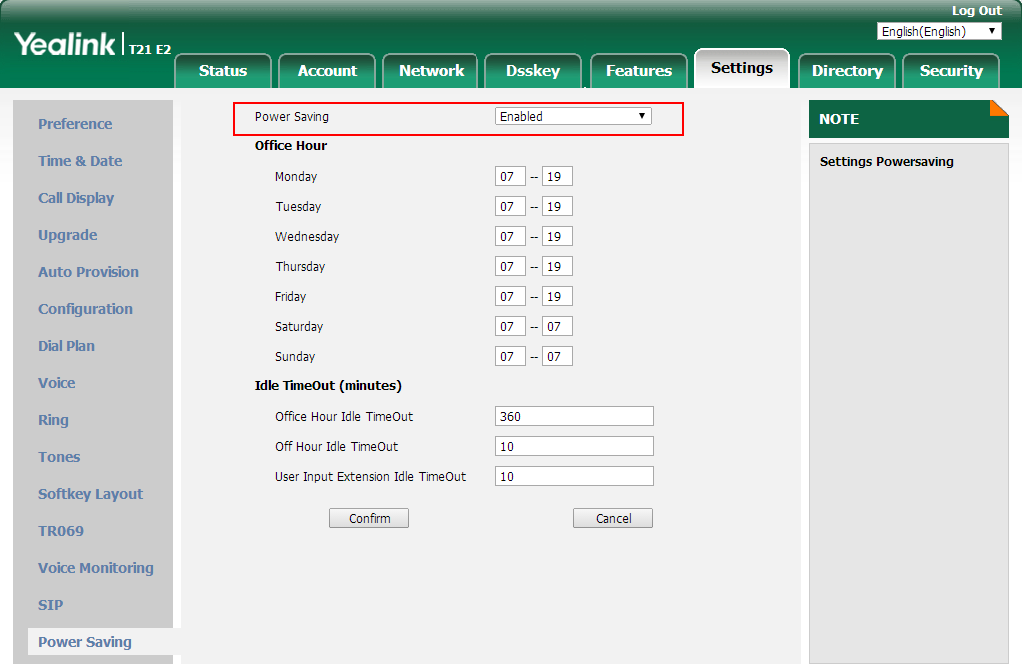

3.
Click Confirm to accept the change.
Configuring the Office Hour
Office Hour specifies the starting time and ending time in the office each day.
To configure the office hour via web user interface:
1.
Click on Settings->Power Saving.
36
| Page 37 |
Customizing Your Phone

2.
Enter the starting time and ending time respectively in the desired day field.
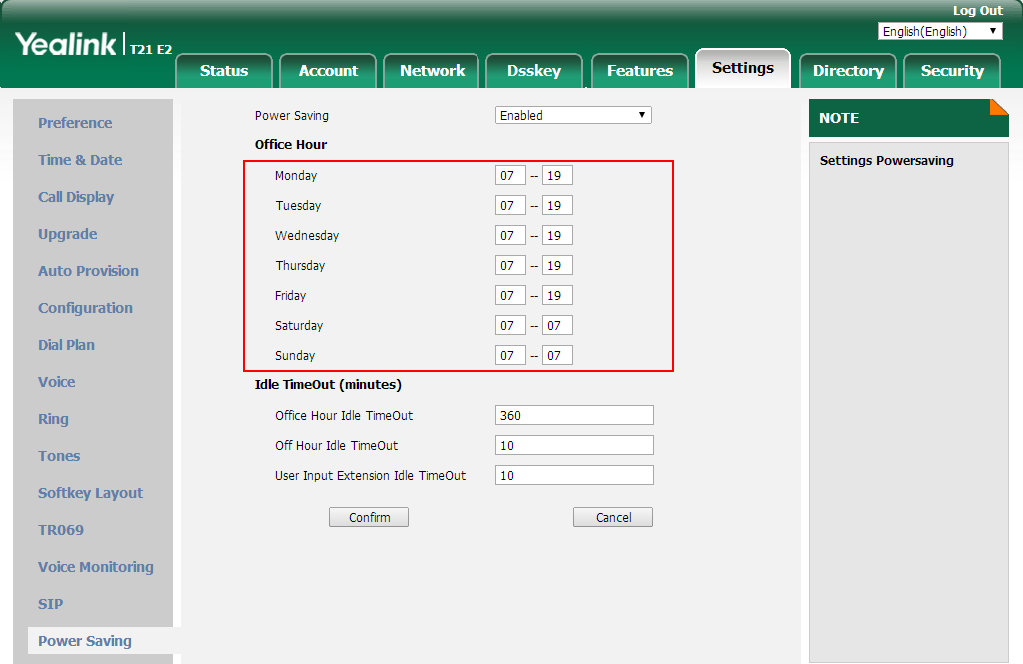

3.
Click Confirm to accept the change.
Configuring the Idle Timeout
Idle Timeout specifies the period of time before the IP phone enters power-saving mode. The
following three types of idle timeout you can configure:
Office Hours Idle TimeOut
: Configures the idle timeout for office hours.
Off Hours Idle TimeOut
: Configures the idle timeout for non
-
office hours.
User Input Extension Idle TimeOut
: Configures
idle timeout that applies after you use
the IP phone (for example, press a key on the phone or pick up/hang up the handset).
By default, the Office Hours Idle TimeOut is much longer than the Off Hours Idle TimeOut. If you
use the IP phone, the idle timeout that applies (User Input Extension Idle TimeOut or Office
Hours/Off Hours Idle TimeOut) is the timeout with the highest value. If the phone has an
incoming call or new message, the User Input Extension Idle TimeOut is ignored.
To configure the idle timeout via web user interface:
1.
Click on Settings->Power Saving.
2.
Enter the desired value in the Office Hours Idle TimeOut field.
The default value is 960, you can set to 1-960.
3.
Enter the desired value in the Off Hours Idle TimeOut field.
The default value is 10, you can set to 1-10.
4.
Enter the desired value in the User Input Extension Idle TimeOut field.
37
| Page 38 |
User Guide for the SIP-T21(P) E2 IP Phone

The default value is 10, you can set to 1-30.
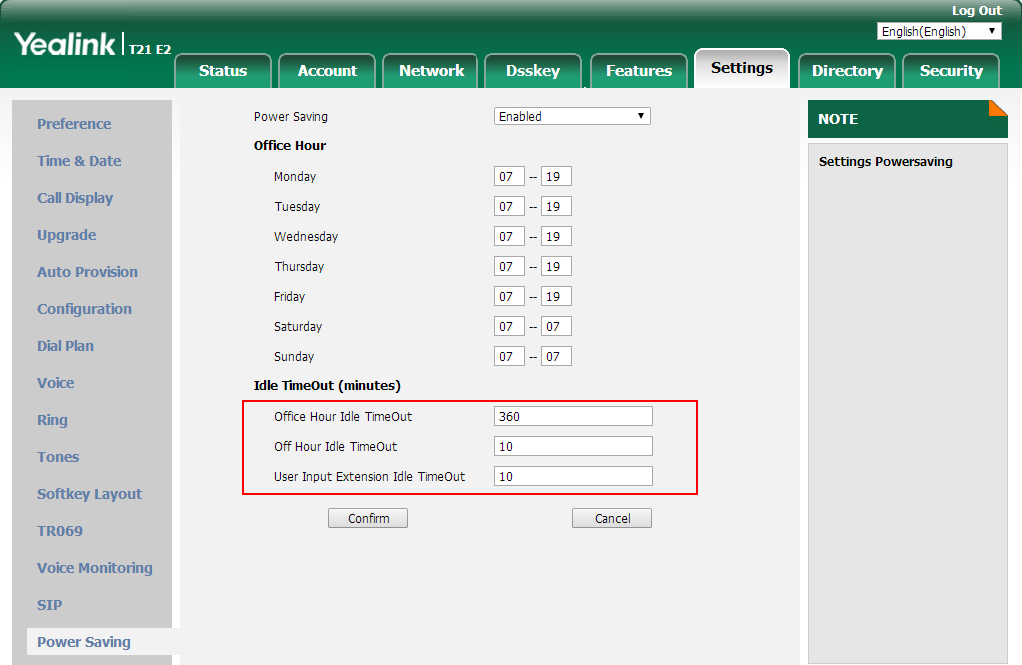

5.
Click Confirm to accept the change.
Contrast
You can configure the LCD screen contrast of SIP-T21(P) E2 to a comfortable level. The intensity
of contrast ranges from 1 to 10 and the highest intensity is 10.
To configure the contrast via phone user interface:
1.
Press Menu->Settings->Basic Settings->Display->Contrast.

2.
Press or , or the Switch soft key to increase or decrease the intensity of contrast.

The default contrast level is “6”.


3.
Press the Save soft key to accept the change or the Back soft key to cancel.
Contrast is configurable via web user interface at the path Settings->Preference.
Backlight
You can configure the backlight to adjust the brightness of the LCD screen. Backlight status on
38
| Page 39 |
Customizing Your Phone

the LCD screen can be configured from the following options:
Always On
:
Backlight is on permanently.
Always Off
:
Backlight is off permanently.
15s
,
30s
,
1min
,
2
min
,
5min
,
10min
or
30min
:
Backlight is turned off when the phone is
inactive after the designated time (in seconds).
To configure the backlight via phone user interface:
1. Press Menu->Settings->Basic Settings->Display->Backlight.

2. Press or , or the Switch soft key to select the desired time from the Backlight

Time field.


3. Press the Save soft key to accept the change or the Back soft key to cancel.
Backlight is configurable via web user interface at the path Settings->Preference.
Language
The default language of the phone user interface is English. If the language of your web browser
is not supported by the phone, the web user interface will use English by default. You can
change the language for the phone user interface and the web user interface respectively.
To change the language for the phone user interface:
1. Press Menu->Settings->Basic Settings->Language.

2. Press or to select the desired language.



3. Press the Save soft key to accept the change.
Text displayed on the phone user interface will change to the selected language.
39
| Page 40 |
User Guide for the SIP
Time
40

-T21(P) E2 IP Phone
To change the language for the web user interface:
1.
Select the desired language from the pull-down list at the top-right corner of web user
interface.


Text displayed on the web user interface will change to the selected language.
& Date
The time and date are displayed on the LCD screen when the phone is idle. You can configure
the phone to obtain the time and date from the SNTP server automatically, or configure the
time and date manually. If the phone cannot obtain the time and date from the Simple Network
Time Protocol (SNTP) server, contact your system administrator for more information.
To configure the SNTP settings via phone user interface:
1.
Press Menu->Settings->Basic Settings->Time & Date->SNTP Settings.

2.
Press or , or the Switch soft key to select the time zone that applies to your area

from the Time Zone field.
The default time zone is “+8”.


3.
Enter the domain name or IP address of SNTP server in the NTP Server1 and NTP Server2
field respectively.


4.
Press or , or the Switch soft key to select the desired value from the Daylight
Saving field.

5.
Press or , or the Switch soft key to select the desired time zone name from the

Location field.
This field appears only if Daylight Saving field is selected to Automatic.
The default time zone name is “China(Beijing)”.
| Page 41 |
Customizing Your Phone

6.
Press the Save soft key to accept the change or the Back soft key to cancel.
Note
Please refer to Appendix A – Time Zones for the list of available time zones on the IP phone.


To configure the time and date manually via phone user interface:
1.
Press Menu->Settings->Basic Settings->Time & Date->Manual Settings.
2.
Enter the specific date in the Date(YMD) field.
3.
Enter the specific time in the Time(HMS) field.


4.
Press the Save soft key to accept the change.
The date and time displayed on the LCD screen will change accordingly.
To configure the time and date format via phone user interface:
1.
Press Menu->Settings->Basic Settings->Time & Date->Time & Date Format.

2.
Press or , or the Switch soft key to select the desired time format (12 Hour or 24

Hour) from the Time Format field.


3.
Press or , or the Switch soft key to select the desired date format from the Date

Format field.

4.
Press the Save soft key to accept the change or the Back soft key to cancel.
There are 7 available date formats. For example, for the date format “WWW DD MMM”, “WWW”
represents the abbreviation of the weekday, “DD” represents the two-digit day, and “MMM”
represents the first three letters of the month.
The date formats available:

Date Format
Example (2016-09-02)


WWW MMM DD
Fri, Sep 02


DD-MMM-YY
02-Sep-16




































41
| Page 42 |
User Guide for the SIP
Administrator Password
A

Note
Key
42
-T21(P) E2 IP Phone

Date Format
Example (2016-09-02)


YYYY-MM-DD
2016-09-02


DD/MM/YYYY
02/09/2016



MM/DD/YY
09/02/16


DD MMM YYYY
02 Sep, 2016


WWW DD MMM
Fri, 02 Sep



Time and date are configurable via web user interface at the path Settings->Time & Date.

You can also customize the date format. Contact your system administrator for more information.


The Advanced Settings option is only accessible to the administrator. The default administrator

password is “admin”. For security reasons, you should change the default administrator

password as soon as possible.

To change the administrator password via phone user interface:

1. Press Menu->Settings->Advanced Settings (default password: admin) ->Change

Password.

2. Enter the current password in the Old PWD field.


3. Enter the new password in the New PWD field.

4. Re-enter the new password in the Confirm PWD field.

5. Press the Save soft key to accept the change or the Back soft key to cancel.

Administrator password is configurable via web user interface at the path Security->Password.

s Send

You can set the “#” key or “*” key to perform as a send key while dialing.

To configure key as send via phone user interface:








































1.
Press Menu->Features->Key As Send.
| Page 43 |
Customizing Your Phone

2.
Press or , or the Switch soft key to select # or * from the Key As Send field, or

select Disabled to disable this feature.



3.
Press the Save soft key to accept the change or the Back soft key to cancel.
Key as send is configurable via web user interface at the path Features->General Information.
Phone Lock
You can lock your phone temporarily when you are not using it. This feature helps to protect
your phone from unauthorized use.
Phone lock consists of the following:
Menu Key: The Menu soft key is locked. You cannot access the menu of the phone
until unlocked.
Function Keys: The function keys are locked. You cannot use the MESSAGE, RD, TRAN,
OK, X, navigation keys and soft keys until unlocked.
All Keys: All keys are locked except the Volume key, digit keys, # key, * key,
HEADSET key and Speakerphone key. You are only allowed to dial
emergency numbers, reject incoming calls by pressing the X key or the
Reject soft key, answer incoming calls by lifting the handset, pressing
the Speakerphone key, the HEADSET key, the OK key, or the Answer
soft key, mute an active call by pressing the X key, and end the call by
hanging up the handset, pressing the Speakerphone key or the
EndCall soft key.
Note
The emergency number setting, if desired, must be set before lock activation. For more

information, refer to Emergency Number on page 86.

To activate the phone lock via phone user interface:
1.
Press Menu->Settings->Basic Settings->Phone Lock.
2.
Enter the desired PIN (default PIN: 123) in the Unlock PIN field, and then press the OK soft
key.
43
| Page 44 |
User Guide for the SIP
44

-T21(P) E2 IP Phone


3.
Press or , or the Switch soft key to select Enabled from the Lock Enable field.


4.
Press or , or the Switch soft key to select the desired type from the Lock Type

field.



5.
(Optional.) Enter the desired interval of automatic phone lock in the Auto Lock field.
The default timeout is 0. It means the phone will not be automatically locked. You need to

long press to lock it immediately when the phone is idle.
If it is set to other values except 0 (e.g., 5), the phone will be locked when the phone is
inactive in idle screen for the designated time (in seconds).
6.
Press the Save soft key to accept the change.
When the phone is locked, the LCD screen prompts “Phone locked.” and displays the

icon .


To change the phone unlock PIN via phone user interface:
1. Press Menu->Settings->Basic Settings->Change PIN.
2. Enter the desired value in the Old PIN, New PIN and Confirm PIN field respectively.


| Page 45 |
Customizing Your Phone

3. Press the Save soft key to accept the change or the Back soft key to cancel.
Note
The unlock PIN length must be within 15 digits.


To unlock the phone via phone user interface:
1. Press any locked key, enter the “Phone Lock” screen.


2. Enter the desired PIN in the Unlock PIN field.
3. Press the OK soft key to unlock the phone.

The icon disappears from the LCD screen.

You can long press or wait for a period of time (if configured) to lock the phone
again.
Note
You can also unlock the phone by administrator password. When you enter the administrator

password to unlock the phone, the phone will turn to the Change PIN screen.

To deactivate the phone lock via phone user interface:
1.
Press Menu->Settings->Basic Settings->Phone Lock.
2.
Enter the desired PIN (default PIN: 123) in the Unlock PIN field, and then press the OK soft
key.

3.
Press or , or the Switch soft key to select Disabled from the Lock Enable field.



4.
Press the Save soft key to accept the change.
Phone lock is configurable via web user interface at the path Features->Phone Lock.
45
| Page 46 |
User Guide for the SIP-T21(P) E2 IP Phone

Audio Settings
Volume
You can press the Volume key to adjust the ringer volume when the phone is idle or ringing.
You can also press the Volume key to adjust the receiver volume of currently engaged audio
devices (handset, speakerphone or headset) when the phone is in use.
Note
Your system administrator can disable you to adjust the ringer volume. Contact your system

administrator for more information.

To adjust the ringer volume when the phone is idle:
1.
Press to adjust the ringer volume.



To adjust the ringer volume when the phone is ringing:
1.
Press to adjust the ringer volume.



You can also press to adjust the ringer volume when selecting a ring tone. For

more information, refer to Ring Tones on page 47.
Note
If ringer volume is adjusted to minimum, the icon will appear on the LCD screen.



46
| Page 47 |
Customizing Your Phone

To adjust the volume when the phone is during a call:
1.
Press to adjust the volume of currently engaged audio device (handset,

speakerphone or headset).


Ring Tones
Ring tones are used to indicate incoming calls. You can select different ring tones to distinguish
different accounts registered on your phone, or to distinguish your phone from your neighbor’s.
The ring tone format must meet the following:


Format
Single File Size
Note



.wav
<=100KB
5K
phone
B
of space should be
reserved for
the



To select a ring tone for the phone via phone user interface:



1.
Press Menu->Settings->Basic Settings->Sound->Ring Tones->Common.


2.
Press or to select the desired ring tone.





3.
(Optional.) Press to adjust the ringer volume.


4.
Press the Save soft key to accept the change or the Back soft key to cancel.


A ring tone for the phone is configurable via web user interface at the path


Settings->Preference->Ring Type.

To select a ring tone for the account via phone user interface:

1.
Press Menu->Settings->Basic Settings->Sound->Ring Tones.



























47
| Page 48 |
User Guide for the SIP-T21(P) E2 IP Phone

2.
Press or to select the desired account and then press the Enter soft key.




3.
Press or to select the desired ring tone.

If Common is selected, this account will use the ring tone selected for the phone.



4.
(Optional.) Press to adjust the ringer volume.

5.
Press the Save soft key to accept the change or the Back soft key to cancel.
A ring tone for the account is configurable via web user interface at the path
Account->Basic->Ring Type.
To upload a custom ring tone for your phone via web user interface:
1. Click on Settings->Preference.
2. In the Upload Ringtone field, click Browse to locate a ring tone (the file format must be
*.wav) file from your local system.
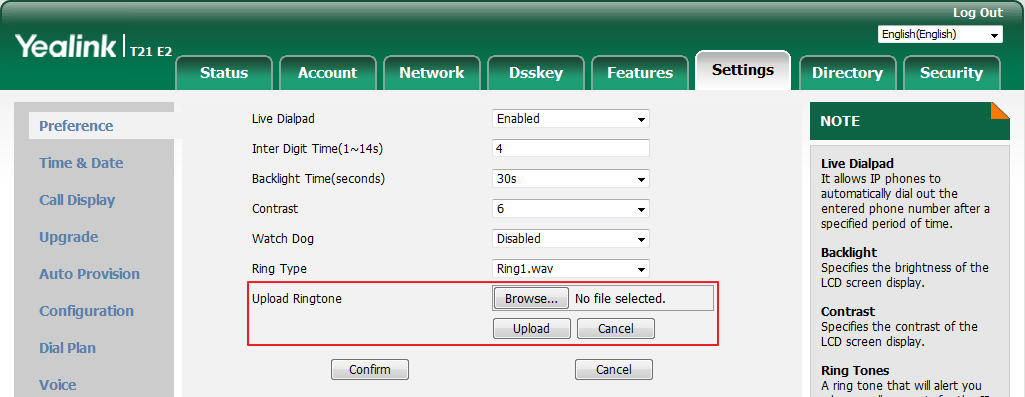

3. Click Upload to upload the file.
The custom ring tone appears in the pull-down list of Ring Type.
48
| Page 49 |
Note
Key
Tone
Contact Management

Customizing Your Phone
You can only delete the custom ring tone by clicking Del when selecting the desired custom
ring tone in the Ring Type field.
The priority of ring tone for an incoming call on the phone is as follows:

Contact ring tone (refer to Adding Contacts) >Group ring tone (refer to Adding
Groups) >Account ring tone >Phone ring tone.
Uploading custom ring tones for your phone is configurable via web user interface only.

If you enable key tone, the phone will produce a sound when you press the keypad.
To configure key tone via phone user interface:
1.
Press Menu->Settings->Basic Settings->Sound->Key Tone.

2.
Press or , or the Switch soft key to select Enabled or Disabled from the Key

Tone field.


3.
Press the Save soft key to accept the change or the Back soft key to cancel.
Key tone is configurable via web user interface at the path Features->Audio.
This section provides the operating instructions for managing contacts. Topics include:
Directory
Local Directory
Blacklist
Remote Phone
B
ook
49
| Page 50 |
User Guide for the SIP
Directory
be accessed

Note
Note
50
-T21(P) E2 IP Phone
Directory provides an easy access to the frequently used lists. The lists may contain Local
Directory, History, Remote Phone Book and LDAP. You can configure the list(s) to
for the Dir soft key.
LDAP is disabled by default. For more information, contact your system administrator.
To configure the list(s) to access for the Dir soft key via web user interface:
1. Click on Directory->Setting.
2. In the Directory block, select the desired list from the Disabled column and then
click .

The selected list appears in the Enabled column.
3. Repeat the step 2 to add more lists to the Enabled column.
4. To remove a list from the Enabled column, select the desired list and then click .

5. To adjust the display order of enabled lists, select the desired list and then click or

The LCD screen displays the list(s) in the adjusted order.
6. Click Confirm to accept the change.
The list(s) to access for the Dir soft key is configurable via web user interface only.
To view the directory list(s) via phone user interface:
1. Press the Dir soft key when the phone is idle.


.
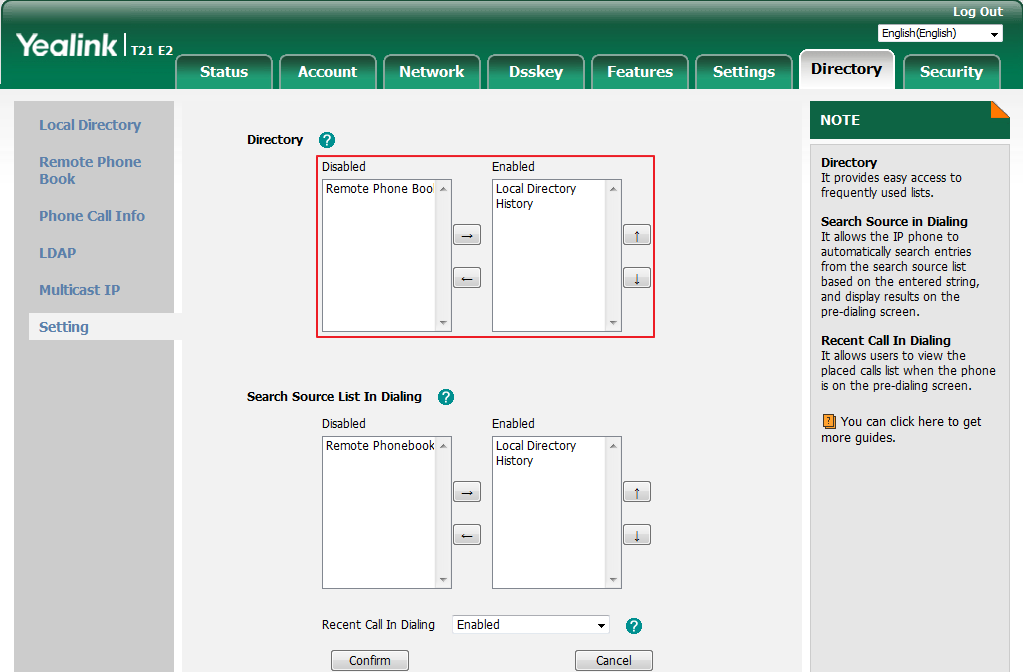





| Page 51 |
Local Directory
Adding Groups

Note
Note
Customizing Your Phone
The LCD screen displays the enabled list(s) in the directory.


If there is only one list in the directory, press the Dir soft key to enter this list directly.
If the remote phone book and LDAP are not configured in advance, you cannot see remote

phone book and LDAP lists on the phone user interface. For more information on remote phone
book, refer to Remote Phone Book on page 61. For more information on LDAP, contact your
system administrator.

The built-in phone directory can store the names and phone numbers of your contacts. You can
store up to 1000 contacts and 48 groups in your phone's local directory. You can add new
groups and contacts, edit, delete or search for a contact, or simply dial a contact number from
the local directory.
Local directory can be backed up to the provisioning server. For more information, contact your

system administrator.

To add a group to the local directory:
1. Press the Dir soft key.
The IP phone enters the local directory directly as there is only Local Directory enabled in
the directory by default.


If Local Directory is removed from the directory (refer to Directory on page 50), press
Menu->Directory->Local Directory to enter the local directory.
2. Press the AddGr soft key.
51
| Page 52 |
User Guide for the SIP
Editing Groups

52
-T21(P) E2 IP Phone
3. Enter the desired group name in the Name field.


4. Press or , or the Switch soft key to select the desired group ring tone from the

Ring field.

If Auto is selected, this group will use the ring tone according to the priority: Contact ring
tone (refer to Adding Contacts) >Account ring tone (refer to Ring Tones) >Phone ring tone
(refer to Ring Tones). If a specific ring tone is selected, this group will use the ring tone
according to the priority: Contact ring tone (refer to Adding Contacts) >Group ring tone.
5. Press the Add soft key to accept the change or the Back soft key to cancel.
To edit a group in the local directory:
1. Press the Dir soft key.
The IP phone enters the local directory directly as there is only Local Directory enabled in
the directory by default.


If Local Directory is removed from the directory (refer to Directory on page 50), press
Menu->Directory->Local Directory to enter the local directory.
2. Select the desired group.
3. Press the Option soft key, and then select Detail.


| Page 53 |
Customizing Your Phone

4. Press or to scroll through the group information and then edit.




5. Press the Save soft key to accept change or the Back soft key to cancel.
Deleting Groups
To delete a group from the local directory:
1. Press the Dir soft key.
The IP phone enters the local directory directly as there is only Local Directory enabled in
the directory by default.
If Local Directory is removed from the directory (refer to Directory on page 50), press
Menu->Directory->Local Directory to enter the local directory.
2. Select the desired group.
3. Press the Option soft key, and then select Delete.
The LCD screen prompts the following warning:


4. Press the OK soft key to confirm the deletion or the Cancel soft key to cancel.
You can also delete all groups by pressing the Option soft key and then select Delete All.
Adding Contacts
You can add contacts to the local directory in the following ways:
Manually
From call history
From
a
remote phone
book
Adding Contacts Manually
To add a contact to the local directory manually:
1.
Press the Dir soft key.
53
| Page 54 |
User Guide for the SIP-T21(P) E2 IP Phone

The IP phone enters the local directory directly as there is only Local Directory enabled in
the directory by default.


If Local Directory is removed from the directory (refer to Directory on page 50), press
Menu->Directory->Local Directory to enter the local directory.
2.
Select the desired contact group and then press the Enter soft key.
If the contact you want to add doesn’t belong to any group, select All Contacts and then
press the Enter soft key.
3.
Press the Add soft key.
4.
Enter the name and the office, mobile or other numbers in the corresponding fields.


5.
Press or , or the Switch soft key to select the desired account from the Account


field.
If Auto is selected, the phone will use the default account when placing calls to the contact
from the local directory.

6.
Press or , or the Switch soft key to select the desired ring tone from the Ring

field.
If Auto is selected, this contact will use the ring tone according to the priority: Group ring
tone (refer to Adding Groups) >Account ring tone (refer to Ring Tones) >Phone ring tone
(refer to Ring Tones).

7.
Press or , or the Switch soft key to select the desired group from the Group

field.
8.
Press the Add soft key to accept the change or the Back soft key to cancel.
Note
If the contact has existed in the directory, the LCD screen will prompt “Contact name existed!”.


Adding Contacts from Call History
To add a contact to the local directory from the call history:
1.
Press the History soft key.
54
| Page 55 |
Customizing Your Phone

2.
Press or to highlight the desired entry.


3.
Press the Option soft key, and then select Add to Contact.


4.
Press the OK soft key, and then edit the contact name.
5.
Press the Save soft key to accept the change.
The entry is successfully saved to the local directory.
Adding Contacts from Remote Phone Book
To add a contact to the local directory from remote phone book:
1. Press Menu->Directory->Remote Phone Book.
If Remote Phone Book is added to the directory (refer to Directory on page 50), press
Dir->Remote Phone Book to enter the remote phone book.
2. Select the desired remote group and then press the Enter soft key.

3. Press or to highlight the desired entry.

4. Press the Option soft key, and then select Add to Contact.
5. Press the Save soft key to save the contact in the local directory.
If the contact has already existed in the local directory, the LCD screen will prompt
“Overwrite the original contact?”. Press the OK soft key to overwrite the original contact in
local directory or the Cancel soft key to cancel.
For more information on remote phone book operating, refer to Remote Phone Book on page
61.
Editing Contacts
To edit a contact in the local directory:
1.
Press the Dir soft key.
The IP phone enters the local directory directly as there is only Local Directory enabled in
the directory by default.


55
| Page 56 |
User Guide for the SIP-T21(P) E2 IP Phone

If Local Directory is removed from the directory (refer to Directory on page 50), press
Menu->Directory->Local Directory to enter the local directory.
2.
Select the desired contact group and then press the Enter soft key.
If the contact is not in any group, select All Contacts and then press the Enter soft key.

3.
Press or to highlight the desired contact.

4.
Press the Option soft key, and then select Detail.


5.
Press or to highlight the contact information and then edit.


6.
Press the Save soft key to accept change or the Back soft key to cancel.
Deleting Contacts
To delete a contact from the local directory:
1.
Press the Dir soft key.
The IP phone enters the local directory directly as there is only Local Directory enabled in
the directory by default.
If Local Directory is removed from the directory (refer to Directory on page 50), press
Menu->Directory->Local Directory to enter the local directory.
2.
Select the desired contact group and then press the Enter soft key.
If the contact is not in any group, select All Contacts and then press the Enter soft key.


3.
Press or to highlight the desired contact.
4.
Press the Option soft key, and then select Delete.
The LCD screen prompts the following warning:


5.
Press the OK soft key to confirm the deletion or the Cancel soft key to cancel.
You can also delete all contacts by pressing the Option soft key, and then select Delete All.
56
| Page 57 |
Customizing Your Phone

Placing Calls to Contacts
To place a call to a contact from the local directory:
1.
Press the Dir soft key.
The IP phone enters the local directory directly as there is only Local Directory enabled in
the directory by default.


If Local Directory is removed from the directory (refer to Directory on page 50), press
Menu->Directory->Local Directory to enter the local directory.
2.
Select the desired contact group and then press the Enter soft key.
If the contact is not in any group, select All Contacts and then press the Enter soft key.

3.
Press or to highlight the desired contact.

4.
Do one of the following:
-
If only one number of the contact is stored in the local directory, press the
Send
soft
key to dial out the number.
-
If multiple numbers of the contact are stored in the local directory, press the
Send
soft
key to display a list of numbers.

Press or to highlight the desired number.

Press the Send soft key to dial out the number.
Searching for Contacts
To search for a contact in the local directory:
1.
Press the Dir soft key.
The IP phone enters the local directory directly as there is only Local Directory enabled in
the directory by default.


If Local Directory is removed from the directory (refer to Directory on page 50), press
Menu->Directory->Local Directory to enter the local directory.
2.
Press the Search soft key.
57
| Page 58 |
User Guide for the SIP
appear on
Importing/Exporting Contact
But

58
-T21(P) E2 IP Phone
3.
Enter a few continuous characters of the contact name or continuous numbers of the
contact number (office, mobile or other number) using the keypad.


The contacts whose name or phone number matches the characters entered will
the LCD screen. You can dial from the result list.
Lists
You can manage your phone’s local directory via phone user interface or web user interface.
you can only import or export the contact list via web user interface.
To import an XML file of contact list via web user interface:
1.
Click on Directory->Local Directory.
2.
Click Browse to locate a contact list file (the file format must be *.xml) from your local
system.
3.
Click Import XML to import the contact list.
The web user interface prompts “The original contact will be covered, continue?”.
4.
Click OK to complete importing the contact list.
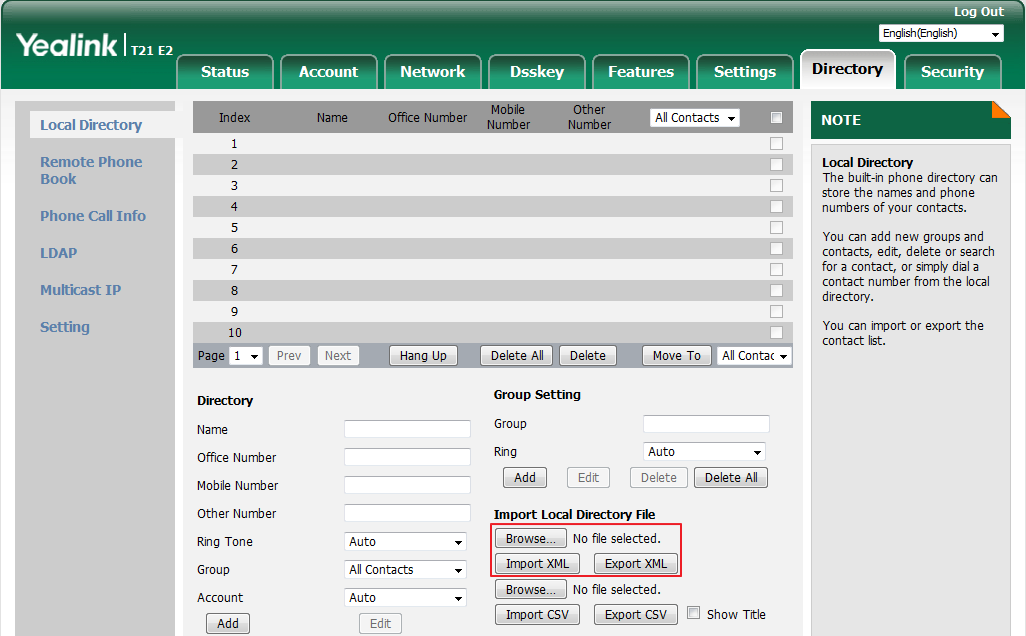

| Page 59 |
Customizing Your Phone

To import a CSV file of contact list via web user interface:
1.
Click on Directory->Local Directory.
2.
Click Browse to locate a contact list file (file format must be *.csv) from your local system.
3.
(Optional.) Check the Show Title checkbox.
It will prevent importing the title of the contact information which is located in the first line
of the CSV file.
4.
Click Import CSV to import the contact list.
5.
(Optional.) Mark the On radio box in the Del Old contact field.
It will delete all existing contacts while importing the contact list.
6.
Select the contact information you want to import into the local directory from the
pull-down list of Index.
At least one item should be selected to be imported into the local directory.
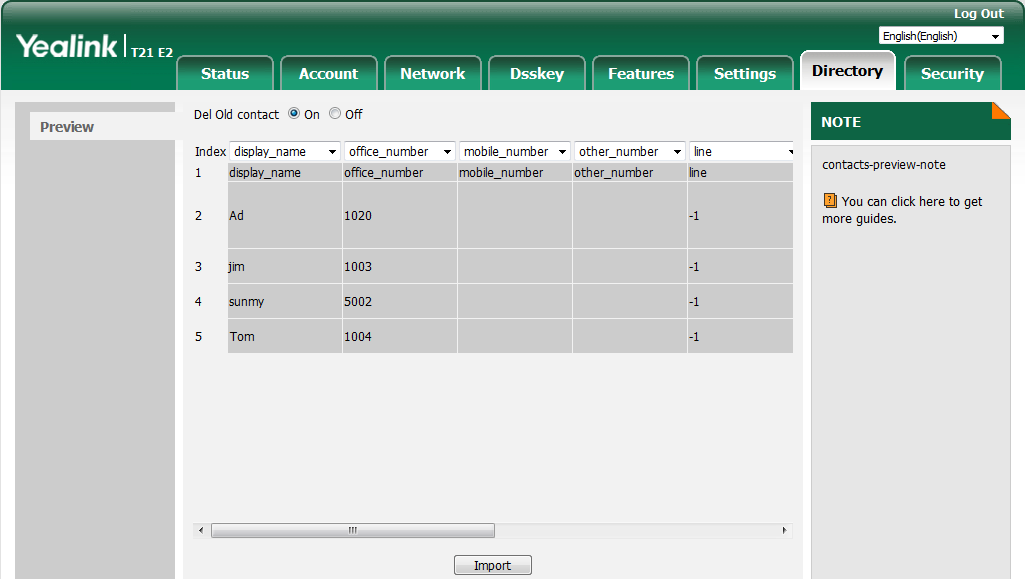

7.
Click Import to complete importing the contact list.
To export a contact list via web user interface:
1.
Click on Directory->Local Directory.
2.
Click Export XML (or Export CSV).
3.
Click Save to save the contact list to your local system.
Note
Importing/exporting contact lists is available via web user interface only.


Blacklist
The built-in phone directory can store names and phone numbers for a blacklist. You can store
up to 30 contacts, add, edit, delete or search for a contact in the blacklist directory, and even call
a contact from the blacklist directory. Incoming calls from blacklist directory contacts will be
59
| Page 60 |
User Guide for the SIP-T21(P) E2 IP Phone

rejected automatically.
To add a contact to the blacklist directory manually:
1. Press Menu->Directory->Blacklist.
2. Press the Add soft key.
3. Enter the name and the office, mobile or other numbers in the corresponding fields.


4. Press or , or the Switch soft key to select the desired account from the Account


field.
If Auto is selected, the phone will use the default account when placing calls to the contact
from the blacklist directory.
5. Press the Add soft key to accept the change or the Back soft key to cancel.
To add a contact to the blacklist directory from the local directory:
1. Press the Dir soft key.
The IP phone enters the local directory directly as there is only Local Directory enabled in
the directory by default.


If Local Directory is removed from the directory (refer to Directory on page 50), press
Menu->Directory->Local Directory to enter the local directory.
2. Select the desired contact group and then press the Enter soft key.
If the contact is not in any group, select All Contacts and then press the Enter soft key.

3. Press or to highlight the desired contact.

4. Press the Option soft key and then select Add to Blacklist.
60
| Page 61 |
Customizing Your Phone

The LCD screen prompts the following warning:


5. Press the OK soft key to accept the change.
For operating instructions on editing, deleting, placing calls to and/or searching for contacts in
the blacklist directory, refer to the operating instructions of Editing Contacts on page 55,
Deleting Contacts on page 56, Placing Calls to Contacts on page 57 and/or Searching for
Contacts on page 57.
Remote Phone Book
You can add new contacts to the local directory, search for a contact, or simply dial a contact
number from the remote phone book.
You can configure your new phone to access up to 5 remote phone books. For the access URL of
the remote phone book, contact your system administrator.
For operating instructions on placing calls to and/or searching for contacts in the remote phone
book, refer to the operating instructions of Placing Calls to Contacts on page 57 and/or
Searching for Contacts on page 57.
Configuring an Access URL
To configure an access URL for a remote phone book via web user interface:
1.
Click on Directory->Remote Phone Book.
2.
Enter the access URL in the Remote URL field.
3.
Enter the name in the Display Name field.
4.
Enter the desired refresh period in the Update Time Interval(Seconds) field.
The default value is 21600.
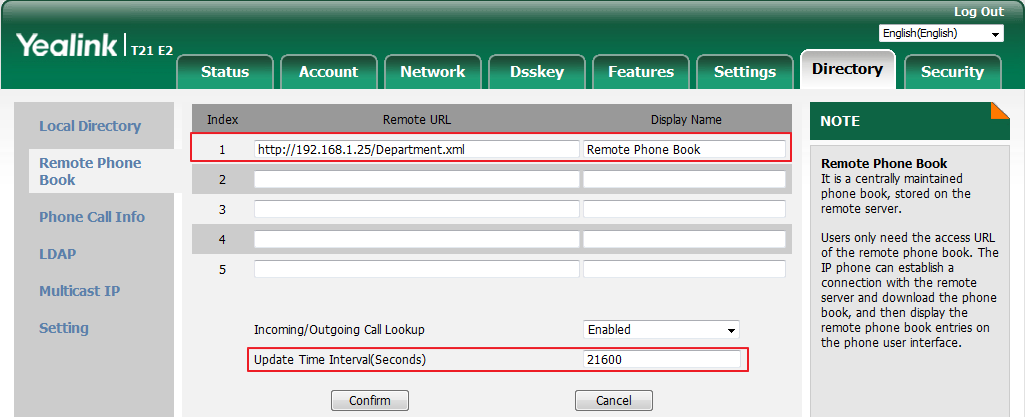

61
| Page 62 |
User Guide for the SIP
Accessing the Remote Phone Book
Incoming/Outgoing Call Lookup

Note
Note
62
-T21(P) E2 IP Phone
5.
Click Confirm to accept the change.
An access URL for a remote phone book is configurable via web user interface only.

The size of a remote phone book file should be less than750K. We recommend you to download
less than 3000 remote contacts from the remote server.

To access your remote phone book via phone user interface:
1. Press Menu->Directory->Remote Phone Book.
If Remote Phone Book is added to the directory (refer to Directory on page 50), press
Dir->Remote Phone Book to enter the remote phone book.

2. Press or to select the desired remote group, and then press the Enter soft key.

The phone then connects to the remote phone book and proceeds to load it. The contacts
in the remote phone book are displayed on the LCD screen.


3. Press the Back soft key to back to the previous screen.

An access URL for a remote phone book is configurable via web user interface only.

You can enable the phone to present the caller/callee identity stored in the remote phone book
when receiving/placing a call.
To configure incoming/outgoing call lookup and update time interval via web user
interface:
1.
Click on Directory->Remote Phone Book.
| Page 63 |
Customizing Your Phone

2.
Select Enabled from the pull-down list of Incoming/Outgoing Call Lookup.
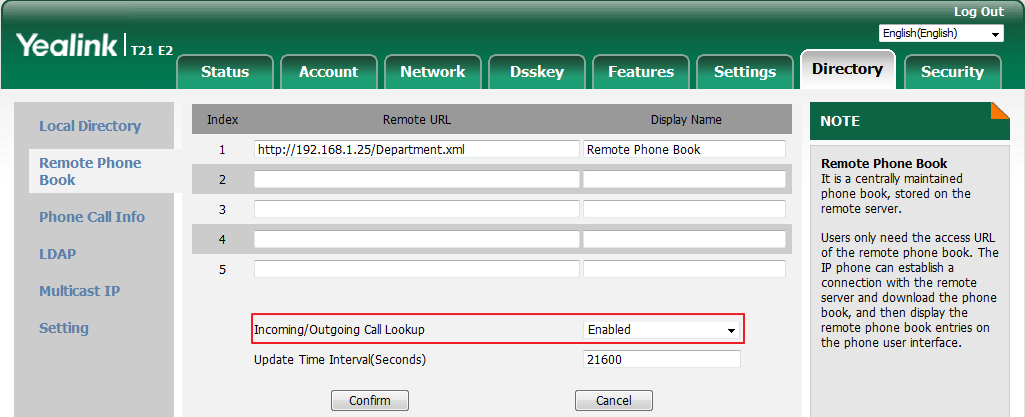

3.
Click Confirm to accept the change.
Call History Management
The SIP-T21(P) E2 IP phone maintains call history lists of Placed Calls, Received Calls, Missed
Calls and Forwarded Calls. Each call history list supports up to 100 entries. You can view call
history, place a call, add a contact or delete an entry from the call history list.
History record feature is enabled by default. If you don’t want to save the call history, you can
disable the feature.
Viewing History Records
To view the call history:
1.
Press the History soft key.
The LCD screen displays all call records.

2.
Press or to switch among All Calls, Missed Calls, Placed Calls, Received Calls

and Forwarded Calls.


3.
Press or to select the desired entry.
4.
Press the Option soft key, and then select Detail.
The detailed information of the entry appears on the LCD screen.
Placing a Call from History Records
To place a call from the call history list:
1.
Press the History soft key.

2.
Press or to switch among All Calls, Missed Calls, Placed Calls, Received Calls

and Forwarded Calls.


3.
Press or to select the desired entry.
63
| Page 64 |
User Guide for the SIP-T21(P) E2 IP Phone

4.
Press the Send soft key.
Adding a Contact to the Local Directory/Blacklist
To add a contact to the local directory (or blacklist directory) from the call history list:
1.
Press the History soft key.

2.
Press or to switch among All Calls, Missed Calls, Placed Calls, Received Calls

and Forwarded Calls.

3.
Press or to select the desired entry.

4.
Press the Option soft key, and then select Add to Contact (or Add to Blacklist).
5.
Enter the desired values in the corresponding fields.
6.
Press the Save soft key.
For more information on local directory and/or blacklist, refer to Local Directory on page 59
and/or Blacklist on page 59.
Deleting History Records
To delete an entry from the call history list:
1.
Press the History soft key.

2.
Press or to switch among All Calls, Missed Calls, Placed Calls, Received Calls

and Forwarded Calls.

3.
Press or to select the desired entry.

4.
Press the Delete soft key.
To delete all entries from the call history list:
1.
Press the History soft key.

2.
Press or to switch among All Calls, Missed Calls, Placed Calls, Received Calls

and Forwarded Calls.
3.
Press the Option soft key, and then select Delete All.
4.
Press the OK soft key.
The LCD screen prompts “Delete all the call records?”.


5.
Press the OK soft key to confirm the deletion or the Cancel soft key to cancel.
64
| Page 65 |
Disabling History Record
Search Source List in Dialing

Note
Customizing Your Phone
To disable history record via phone user interface:
1. Press Menu->Features->History Setting.

2. Press or , or the Switch soft key to select Disabled from the History Record

field.


3. Press the Save soft key to accept the change or the Back soft key to cancel.
You can search for a contact from the desired lists when the phone is on the dialing screen. The
lists can be Local Directory, History, Remote Phone Book and LDAP.
LDAP is disabled by default. For more information, contact your system administrator.


To configure search source list in dialing via web user interface:

1. Click on Directory->Setting.
2. In the Search Source List In Dialing block, select the desired list from the Disabled column
and then click .

The selected list appears in the Enabled column.
3. Repeat the step 2 to add more lists to the Enabled column.

4. To remove a list from the Enabled column, select the desired list and then click .

5. To adjust the display order of search results, select the desired list and then click
or .

65
| Page 66 |
User Guide for the SIP-T21(P) E2 IP Phone

The LCD screen will display search results in the adjusted order.
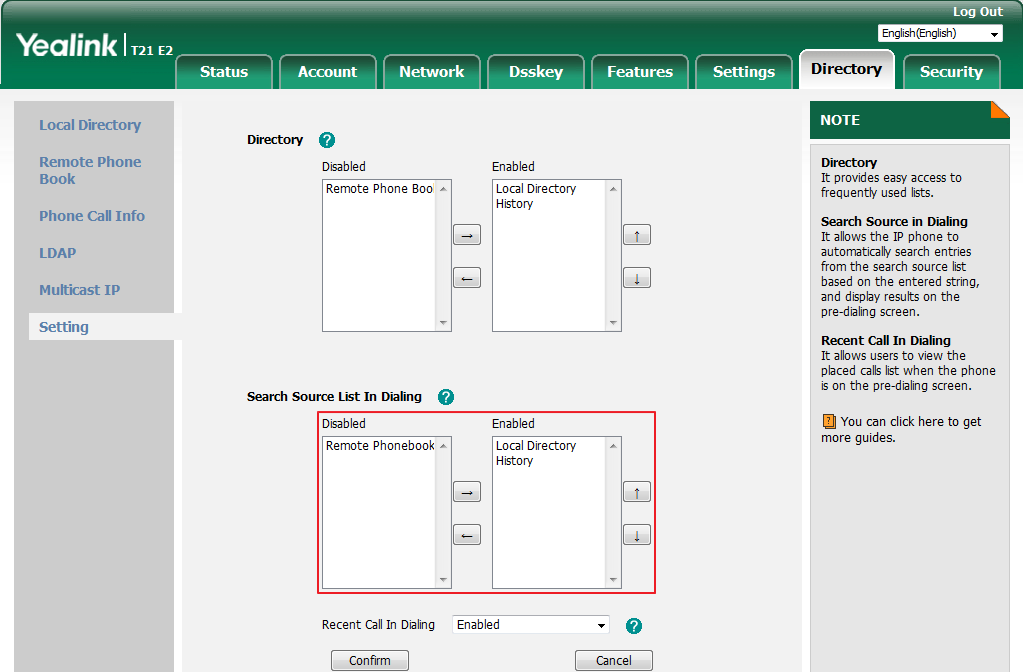

6. Click Confirm to accept the change.
Note
Search source list in dialing is configurable via web user interface only.


To search for a contact in the enabled search source lists:
1. Pick up the handset, press the Speakerphone key or press the line key.
2. Enter a few continuous characters of the entry’s name or continuous numbers of the entry’s
phone number (office, mobile or other number) using the keypad.
The entries in the enabled search source lists whose name or phone number matches the

characters entered will appear on the LCD screen. You can press or to scroll to

the desired entry, and then place a call to the entry.


System Customizations
Logo Customization
You can upload your custom logo which will be shown on the idle screen.
66
| Page 67 |
Headset Use
Headset

Note
Note
Customizing Your Phone
To upload a custom logo via web user interface:
1.
Click on Features->General Information.
2.
Select Custom logo from the pull-down list of Use Logo.
3.
Click Browse to locate the logo file from your local system.
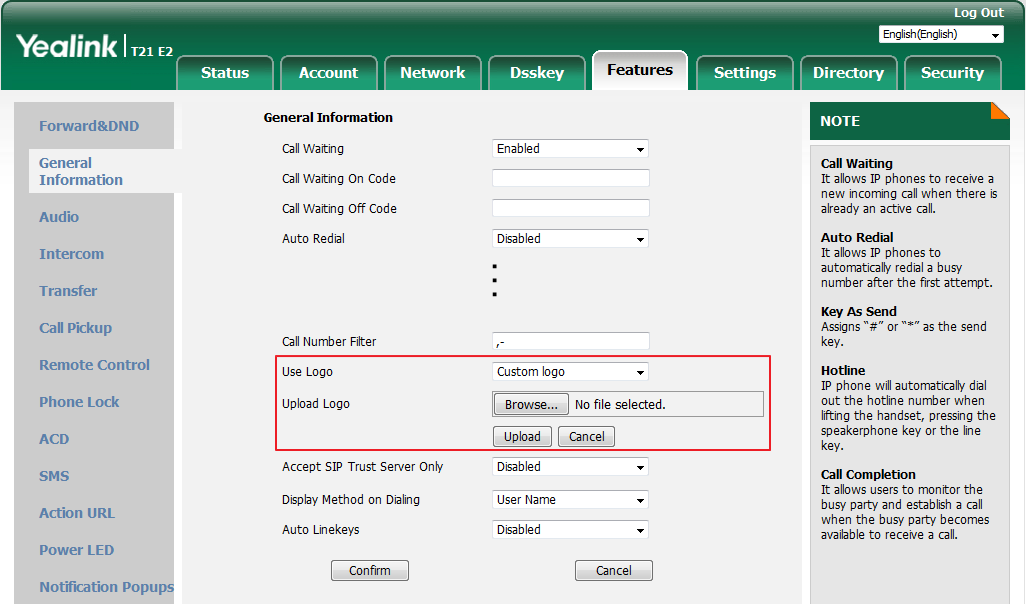

4.
Click Upload to upload the file.
Delete item will appear after you upload a custom logo, you can click Delete to delete the

custom logo.
The logo file format must be *.dob, contact your system administrator for more information.
A custom logo can be uploaded via web user interface only.

If you want to use a headset, physically connect your headset and activate the headset mode for
use. For more information on physically connecting a headset, refer to Phone Installation on
page 25.
To use headset, make sure the headset mode is enabled. Contact your system administrator

for more information.

Mode Activation/Deactivation

To activate the headset mode:
1.
Press on the phone.

The headset icon appears on the idle screen.

Press the line key or the Answer soft key to answer an incoming call. The call will be
67
| Page 68 |
User Guide for the SIP
Headset Prior
Note

68
-T21(P) E2 IP Phone
connected to your headset automatically.
Enter the desired number and then press the Send soft key, the phone will then place a call
using the headset automatically. For more information on using the headset to place a call,
refer to Placing Calls on page 89.
To deactivate the headset mode:

1.
Press again on the phone.

The headset icon disappears from the idle screen.
You can use headset in priority when headset prior feature is enabled. This feature is especially
useful for permanent or full-time headset users.
To enable headset prior via web user interface:
1.
Click on Features->General Information.
2.
Select Enabled from the pull-down list of Headset Prior.
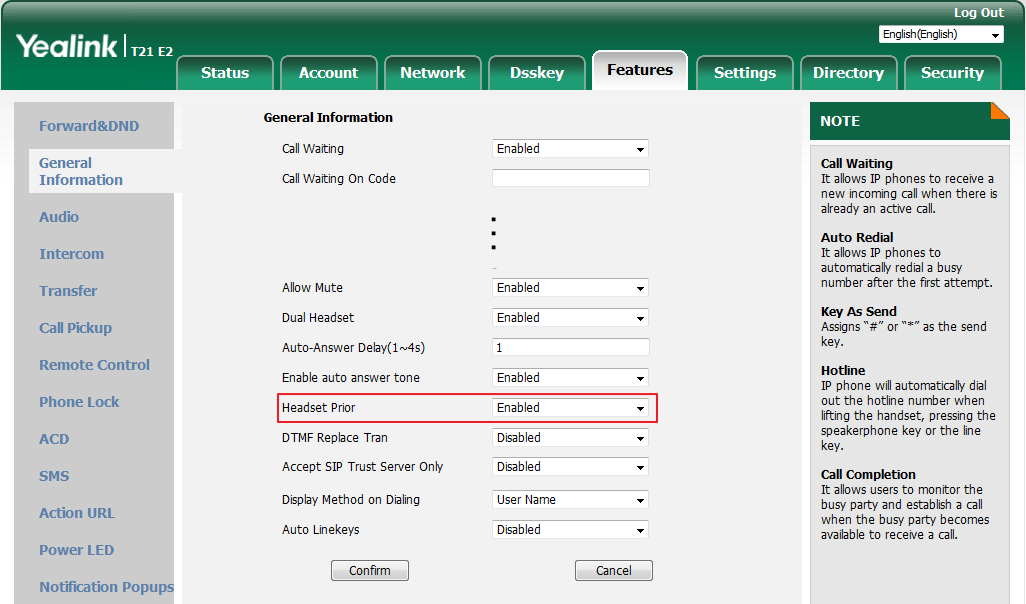

3.
Click Confirm to accept the change.
To use headset prior feature, you should activate the headset mode in advance:
1.
Physically connect the headset.

2.
Press to activate the headset mode.
If headset prior is enabled, the headset mode will not be deactivated until you press the

HEADSET key again.
If headset prior is disabled, the headset mode can be deactivated by pressing the Speakerphone
key or the HEADSET key.

Headset prior is configurable via web user interface only.
| Page 69 |
Customizing Your Phone

Dual Headset
You can use two headsets when enabling dual headset. To use this feature, you must physically
connect headsets to the headset jack and handset jack respectively. Once the phone connects to
a call, the headset connected to the headset jack will have full-duplex capabilities, while the one
connected to the handset jack will only be able to listen.
To enable dual headset via web user interface:
1.
Click on Features->General Information.
2.
Select Enabled from the pull-down list of Dual Headset.
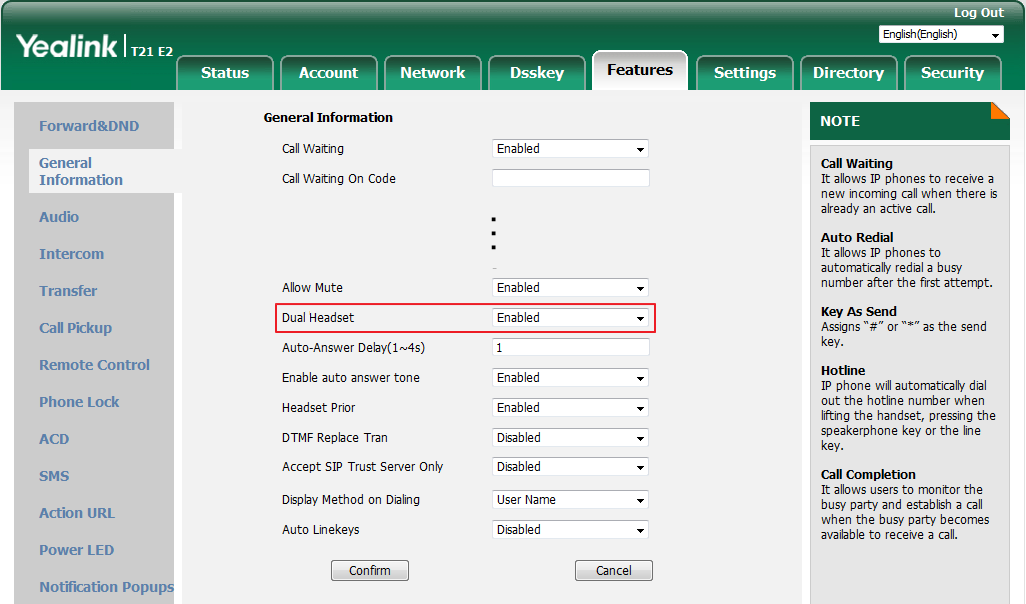

3.
Click Confirm to accept the change.
Note
Dual headset is configurable via web user interface only.


DSS Keys

There are two types of DSS keys: Line Keys and Programable Keys. The details will be
introduced in the following. The SIP-T21(P) E2 IP phone supports 2 line keys and 11
programable keys.
Line Keys
You can assign predefined functionalities to line keys. You can also define a label for a line key
feature which will appear on the LCD screen. Line keys allow you to quickly access features such
as recall and voice mail. The line key LEDs will indicate the monitored status when the line keys
are assigned with particular features, such as BLF. The default key type of each line key is Line.
69
| Page 70 |
Label
soft key to cancel
Key
When the phone is idle, you can also long press the line key to configure it directly on the phone.
User Guide for the SIP-T21(P) E2 IP Phone

To assign functionality to a line key via phone user interface:
1.
Press Menu->Features->DSS Keys.
2.
Select the desired DSS key, and then press the Enter soft key.
3.
Select the desired key type from the Type field.
4.
(Optional.) Select the desired key event type from the Key Type field.
5.
(Optional.) Select the desired line from the Account ID field.
6.
(Optional.) Enter the string that will appear on the LCD screen in the
7.
(Optional.) Enter the corresponding value in the Value field.
8.
(Optional.) Enter the corresponding value in the Extension field.
9.
Press the Save soft key to accept the change or the Back
Line key is configurable via web user interface at the path Dsskey->Line
Note
Line key features are explained in the following subchapters in detail:
Line
Speed Dia
l
Voice Mail
D
irect
Pickup
G
roup
Pickup
DTMF
Prefix
Local Group
XML Group
XML Brow
s
er
LDAP
Conf
erence
Forward
Tran
sfer
Hold
DND
SMS
Group Listening
Zero
T
ouch
URL
70
field.
.
.


| Page 71 |
Customizing Your Phone

Phone
Lock
Directory
For the features not listed above, refer to Basic Call Features on page 89 and Advanced Phone
Features on page 131. For more information, contact your system administrator.
Line
You can use this key feature to accept incoming calls, place active calls on hold or resume a
held call. It performs in the same way as a hard line key.
Dependencies:
Type
(
Line
)
Account ID
(the account this f
eature
will be applied to)
Label
(key label displayed on the LCD screen)
Usage: When the phone receives an incoming call, the Line key LED flashes green:
1. Press the Line key to accept the incoming call.
2. Press the Line key to place a new call and the active call is placed on hold.
3. Press the Line key again to resume the held call.
Speed Dial
You can use this key feature to speed up dialing the numbers frequently used or hard to
remember.
Dependencies:
Type
(
S
peed
Dial
)
Account ID
(the account this f
eature
will be applied to)
Label
(key label displayed on the LCD screen)
Value
(the number you want to dial out)
Usage: Press the Speed Dial key to dial out the number specified in the Value field, using the
account selected from the Account ID field.
Voice Mail
You can use this key feature to quickly connect voice mail. For more information, refer to Voice
Mail on page 176.
Dependencies:
Type
(
Key Event
)
Key Type
(
Voice Mail
)
Account ID
(the account this f
eature
will be applied to)
Label
(key label displayed on the LCD screen)
Value
(the voice mail access code)
Usage: Press the Voice Mail key to dial out the voice mail access code. Then follow the voice
prompt to listen to the voice mails.
71
| Page 72 |
User Guide for the SIP-T21(P) E2 IP Phone

Direct Pickup
You can use this key feature to answer someone else’s incoming call on the phone.
Dependencies:
Type
(
Key Event
)
Key Type
(
Pick
U
p
)
Account ID
(the account this f
eature
will be applied to)
Label
(key label displayed on the LCD screen)
Value
(
the
directed
call
pickup code followed by the target phone number
)
Usage: Press the Direct Pickup key on your phone when the target phone number receives an
incoming call. The call is then answered on your phone.
Group Pickup
You can use this key feature to answer incoming calls in a group that is associated with their
own group.
Dependencies:
Type
(
Key Event
)
Key Type
(
G
roup
Pick
U
p
)
Account ID
(the account this f
eature
will be applied to)
Label
(key label displayed on the LCD screen)
Value
(the group call pickup
code)
Usage: Press the Group Pickup key on your phone when a phone number in the group receives
an incoming call. The call is answered on your phone.
DTMF
You can use this key feature to send the specification of arbitrary key sequences via DTMF.
Dependencies:
Type
(
Key Event
)
Key Type
(
DTMF
)
Label
(key label displayed on the LCD screen)
Value
(
DTMF
sequence
)
Usage: Press the DTMF key during an active call to send the key sequence specified in the
Value field.
Note
DTMF sequence can only contain “0-9”, “*”, “#” and ”A-E”.


Prefix
You can use this key feature to add a specified prefix number before the dialed number.
Dependencies:
Type
(
Key Event
)
Key Type
(
Prefix
)
Label
(key label displayed on the LCD screen)
Value
(
the
prefix number)
72
| Page 73 |
Customizing Your Phone

Usage: Press the Prefix key when the phone is idle, the phone will then enter the dialing screen
and display the prefix number that you specified in the Value field. You can enter the remaining
digits and then dial out.
Local Group
You can use this key feature to quickly access a contact group in the local directory. For more
information, refer to Local Directory on page 51.
Dependencies:
Type
(
Key Event
)
Key Type
(
Local Group
)
Local Group
(
t
he
contact group
name you want to access
)
Label
(key label displayed on the LCD screen)
Usage: Press the Local Group key to access the contact group specified in the Local Group
field.
XML Group
You can use this key feature to quickly access a remote group in your remote phone book. You
should configure remote phone book in advance. For more information, refer to Remote Phone
Book on page 61.
Dependencies:
Type
(
Key Event
)
Key Type
(
XML Group
)
PhoneBook
Name
(the
remote group
name you want to access if remote
phone book is configured)
Label
(key label displayed on the LCD screen)
Usage: Press the XML Group key to access the remote group specified in the PhoneBook
Name field.
XML Browser
You can use this key feature to quickly access an XML browser. The XML browser allows you to
create custom services which meet your functional requirements on the server. You can
customize practical applications, such as weather report, stock information, Google search, etc.
Dependencies:
Type
(
Key Event
)
Key Type
(
XML
Browser
)
Label
(key label displayed on the LCD screen)
Value
(the access URL for
XML
browser)
Usage: Press the XML Browser key to access the XML browser specified in the Value field.
LDAP
You can use this key feature to quickly access a LDAP search screen.
Dependencies:
Type
(
Key Event
)
Key Type
(
LDAP
)
Label
(key
label displayed on the LCD screen)
73
| Page 74 |
User Guide for the SIP
Note
Note
Note

74
-T21(P) E2 IP Phone
Usage:
1. Press the LDAP key to access the LDAP search screen.
2. Enter a few continuous characters of the contact name or continuous numbers of the
contact number using the keypad.
The contacts whose name or phone number matches the characters entered will appear on
the LCD screen.
LDAP is disabled by default. For more information, contact your system administrator.


Conference

You can use this key feature to set up a conference call. For more information, refer to
Conference on page 117.
Dependencies:
Type
(
Key Event
)
Key Type
(
C
onf
)
Label
(key label displayed on the LCD screen)
Value
(
the
number
you want to add to the conference
)
Usage: Press the Conference key during an active call to set up a conference with the number
specified in the Value field.
If the Value field is left blank, the Conference key performs the same as the Conf soft key during

a call.

Forward

You can use this key feature to forward an incoming call to someone else. For more information,
refer to Call Forward on page 104.
Dependencies:
Type
(
Key Event
)
Key Type
(
F
WD
)
Label
(key label displayed
on the LCD screen)
Value
(
the
number
you want to forward to
)
Usage: Press the Forward key to forward an incoming call to the number specified in the
Value field.
If the Value field is left blank, the Forward key performs the same as the FWD soft key when

receiving an incoming call.

Transfer

When there is an active call on the phone, you can use this key feature to handle the call
differently depending on the transfer mode assigned to the DSS key.
| Page 75 |
Customizing Your Phone

Dependencies:
Type
(
Key Event
)
Key Type
(
Tran
s
)
Label
(key label displayed on the LCD screen)
Value
(
the
number
you want to
transfer
to
)
Usage:
When the transfer mode on DSS key is
Blind Transfer
, p
ress the
Transfer
key to
complete
the blind transfer to the number specified in the Value field.
When the transfer mode on DSS key is
Attended Transfer
, p
ress the
Transfer
key
to dial
out the number specified in the Value field, and then perform the attended or
semi-attended transfer.
When the transfer mode on DSS key is
New Call
, press the
Transfer
k
ey
to place a new call
to the number specified in the Value field.
Note
Transfer mode via DSS key is configurable via web user interface at the path

Features->Transfer->Transfer Mode Via Dsskey.
If the Value field is left blank, the Transfer key performs the same as the TRANSFER key or the
Trans soft key during a call. For more information, refer to Call Transfer on page 112.

Hold

You can use this key feature to place an active call on hold or retrieve a held call.
Dependencies:
Type
(
Key Event
)
Key Type
(
Hold
)
Label
(key label displayed on
the LCD screen)
Usage:
1.
Press the Hold key during an active call to place the call on hold.
2.
Press the Hold key again to retrieve the held call.
DND
You can use this key feature to activate or deactivate DND. You can also use this key feature to
access the custom DND screen. For more information, refer to Do Not Disturb (DND) on page
100.
Dependencies:
Type
(
Key Event
)
Key Type
(
D
ND
)
Label
(key label displayed on the LCD screen)
Usage:
When DND is in phone mode:
1.
Press the DND key to activate DND.
2.
Press the DND key again to deactivate DND.
When DND is in custom mode:
75
| Page 76 |
User Guide for the SIP-T21(P) E2 IP Phone

1. Press the DND key to access the custom DND screen. You can activate or deactivate DND
for one or all accounts.
Note
When DND is activated, the DND key LED will illuminate solid green, and the incoming calls will

be rejected automatically.

SMS

You can use this key feature to quickly access text message. For more information, refer to Short
Message Service (SMS) on page 174.
Dependencies:
Type
(
Key Event
)
Key Type
(
SMS
)
Label
(key label displayed on the LCD
screen)
Usage: Press the SMS key when the phone is idle to access text message.
Group Listening
You can use this key feature to activate the Speakerphone and Handset/Headset mode at the
same time. It is suitable for the group conversations which have more than one person present
at one end. You are able to speak and listen through the handset/headset, while the others
nearby can only listen through the speaker.
Dependencies:
Type
(
Key Event
)
Key Type
(
Group Listening
)
Label
(key label displayed on the
LCD screen)
Usage:
1. During a call, press the Group Listening key to activate the group listening mode.
You can then speak and listen through the handset/headset, while other people at your
side can only listen through the speaker at the same time.
2. Press the Group Listening key again to deactivate the group listening mode.
Zero Touch
You can use this key feature to quickly configure auto provision and network parameters.
Dependencies:
Type
(
Key Event
)
Key Type
(
Zero
T
ouch
)
Label
(key lab
el displayed on the
LCD screen)
Usage:
1. Press the Zero Touch key to access the zero touch screen.
2. Press the OK soft key within a few seconds.
3. Configure the network parameters in the corresponding fields.
4. Press the Next soft key.
5. Configure the auto provision parameters in the corresponding fields.
76
| Page 77 |
Customizing Your Phone

6. Press the OK soft key.
The phone will reboot to update configurations.
URL
You can use this key feature to trigger the phone to send an HTTP GET request containing a
specific URL.
Dependencies:
Type
(
URL
)
Label
(key label displayed on
the LCD screen)
Value
(
the URL contained in the HTTP GET request
)
Usage: Press the URL key to trigger the phone to send an HTTP GET request containing the
URL specified in the Value field.
Phone Lock
You can use this key feature to immediately lock your phone instead of long pressing . For

more information, refer to Phone Lock on page 43.
Dependencies:
Type
(
Key Event
)
Key Type
(
Phone Lock
)
Label
(key label displayed on the LCD screen)
Usage: When the phone lock feature is enabled, press the Phone Lock key to immediately lock

your phone instead of long pressing .
Directory
You can use this key feature to easily access frequently used lists. For more information, refer to
Directory on page 50.
Dependencies:
Type
(
Key Event
)
Key Type
(
Dir
)
Label
(key label displayed on the LCD
screen)
Usage: Press the Directory key to immediately access frequently used lists.
Note
The Directory key performs the same function as the Dir soft key when the phone is idle.


Programable Keys

You can customize the soft keys, navigation keys and function keys.
To customize soft keys via phone user interface:
1.
Press Menu->Settings->Advanced Settings (default password: admin) ->Softkey Label.
2.
Select the desired soft key, and then press the Enter soft key.
77
| Page 78 |
User Guide for the SIP
Note

78
-T21(P) E2 IP Phone
3.
Select the desired key type from the Type field.


4.
(Optional.) Select the desired line from the Account ID field.
5.
(Optional.) Enter the string that will appear on the LCD screen in the Label field.
6.
(Optional.) Enter the corresponding value in the Value field.
7.
Press the Save soft key to accept the change or the Back soft key to cancel.
To customize the programable keys via web user interface:
1.
Click on Dsskey->Programable Key.
2.
Customize specific features for these keys.
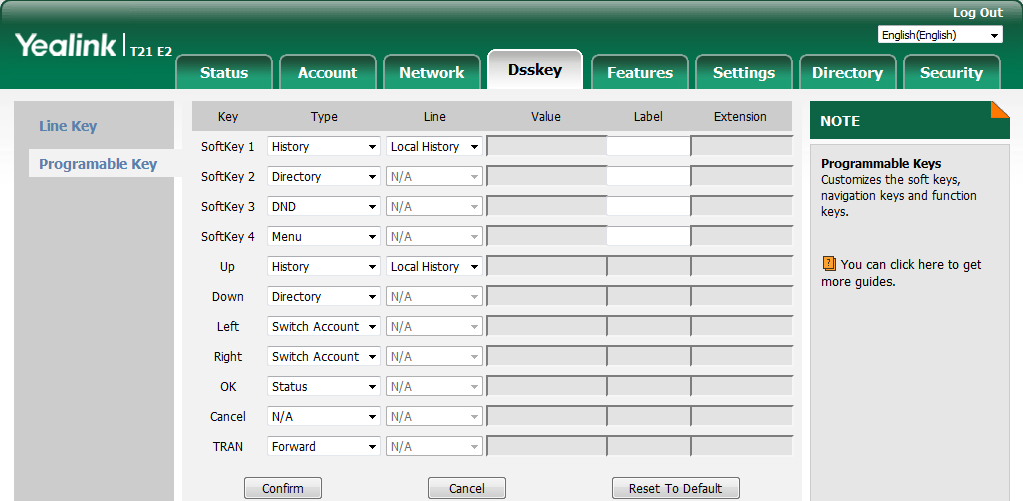

3. (Optional.) Enter the string that will appear on the LCD screen in the Label field.
Label is configurable only when customizing SoftKey (1-4).
4.
Click Confirm to accept the change.
Navigation keys and function keys are configurable via web user interface only.

The X key can be used as a Cancel key or mute key. It cannot be customized when keep
mute feature is enabled. For more information, contact your system administrator.

You can click Reset To Default to reset custom settings to defaults.
Then you can press the keys on the phone to perform the features you configured.
For example:
| Page 79 |
Customizing Your Phone

Switch Account Up
You can use this key feature to change the default account.
Dependencies:
Type
(
Switch Account Up
)
Usage: Press the Switch Account Up key to scroll up the account list to select the desired
default account.
Switch Account Down
You can use this key feature to change the default account.
Dependencies:
Type
(
Switch Account Down
)
Usage: Press the Switch Account Down key to scroll down the account list to select the desired
default account.
Account Management
You can register one or multiple accounts on the SIP-T21(P) E2 IP phone. You can also
configure each line key to associate with an account or configure multiple line keys to associate
with an account.
Account Registration
To register an account via phone user interface:
1.
Press Menu->Settings->Advanced Settings (default password: admin) ->Accounts.
2.
Select the desired account and then press the Enter soft key.
3.
Select Enabled from the Activation field.


4.
Enter the desired value in Label, Display Name, Register Name, User Name, Password
and SIP Server1/2 field respectively. Contact your system administrator for more
information.
5.
If you use the outbound proxy servers, do the following:


1) Press or , or the Switch soft key to select Enabled from the Outbound Status
field.
2) Enter the desired value in the Outbound Proxy1/2 and Proxy Fallback Interval field
respectively. Contact your system administrator for more information.
6.
Press the Save soft key to accept the change or the Back soft key to cancel.
79
| Page 80 |
User Guide for the SIP
Multiple Line Keys per Account
Dial Plan

Note
80
-T21(P) E2 IP Phone
You can repeat steps 2 to 6 to register more accounts.
To disable an account via phone user interface:
1.
Press Menu->Settings->Advanced Settings (default password: admin) ->Accounts.
2.
Select the desired account and then press the Enter soft key.
3.
Select Disabled from the Activation field.
4.
Press the Save soft key to accept the change or the Back soft key to cancel.
Account registration is configurable via web user interface at the path Account->Register.


Default account can be set by pressing or on the idle screen. It has priority when


placing a call. The phone’s default account cannot be changed after reboot.



You can configure multiple line keys to associate with an account. This enhances call
visualization and simplifies call handling.


If this is the case, the LCD screen will resemble the following figure:


Incoming calls to this account will be distributed evenly among the available line keys. Outgoing
calls will be distributed similarly.
Your phone can be configured to have a combination of accounts with a single line key and
accounts with multiple line keys.
Dial plan is a string of characters that governs the way your SIP-T21(P) E2 IP phone processes
the inputs received from your phone keypad.
The SIP-T21(P) E2 IP phone supports the following dial plan features:
Replace Rule
| Page 81 |
Customizing Your Phone

Dial
N
ow
Area Code
Block Out
The basic expression syntax you need to know:

The dot "." can be used as a placeholder or multiple placeholders for any

.
character. Example:

"12." would match "123", "1234", "12345", "12abc", etc.

x
An
"
12x
"
x
"
"
would match
can be used as a placeholder for any character.
"
12
1
"
,
"
12
2
"
,
"
12
3
"
,
"12
a
",
etc.
Example:

-
Numeric ranges are allowed within the brackets: Digit “-” Digit. Example:

“[5-7]” would match the number”5”, ”6”or ”7”.

The square brackets "[]" can be used as a placeholder for a single character

[]
which matches any of a set of characters. Example:

"91[5-7]1234" would match "9151234", "9161234", "9171234".

The parentheses "( )" can be used to group together patterns, for instance, to

()
logically combine two or more patterns. Example:

"([1-9])([2-7])3" would match "923", "153", "773", etc.

The “$” should be followed by the sequence number of a parenthesis. The “$”

plus the sequence number means the whole character or characters placed in

the parenthesis. The number directs to the right parenthesis when there are

$
more than one. Example:
A replace rule configuration, Prefix: "001(xxx)45(xx)", Replace: "9001$145$2".

When you dial out "0012354599" on your phone, the IP phone will replace the

number with "90012354599". “$1” means 3 digits in the first parenthesis, that

is, “235”. “$2” means 2 digits in the second parenthesis, that is, “99”.

Note
The IP phone supports a new dial plan mechanism – digit map. Digit maps are defined by a single

string or a list of strings. If a number you dial matches any string of a digit map, the call is

automatically placed.

Note that if digit map feature is enabled, the old dial plan rules (described in this chapter) will be

ignored. For more information, contact your system administrator.

Replace Rule

You can configure one or more replace rules (up to 100) to remove the specified string and

replace it with another string. You can configure a pattern with wildcards (refer to the expression

syntax in the table above), so that any string that matches the pattern will be replaced. This

feature is convenient for you to dial out a long number. For example, a replace rule is configured

as “Prefix: 1” and “Replace: 1234”. When trying to dial out the number “1234”, you just need to

enter “1” on the phone and then press the Send soft key.





























81
| Page 82 |
User Guide for the SIP
Note
82

-T21(P) E2 IP Phone
To add a replace rule via web user interface:
1.
Click on Settings->Dial Plan->Replace Rule.
2.
Enter the string (e.g., 1) in the Prefix field.
3.
Enter the string (e.g., 1234) in the Replace field.
4.
Enter the desired line ID in the Account field or leave it blank.
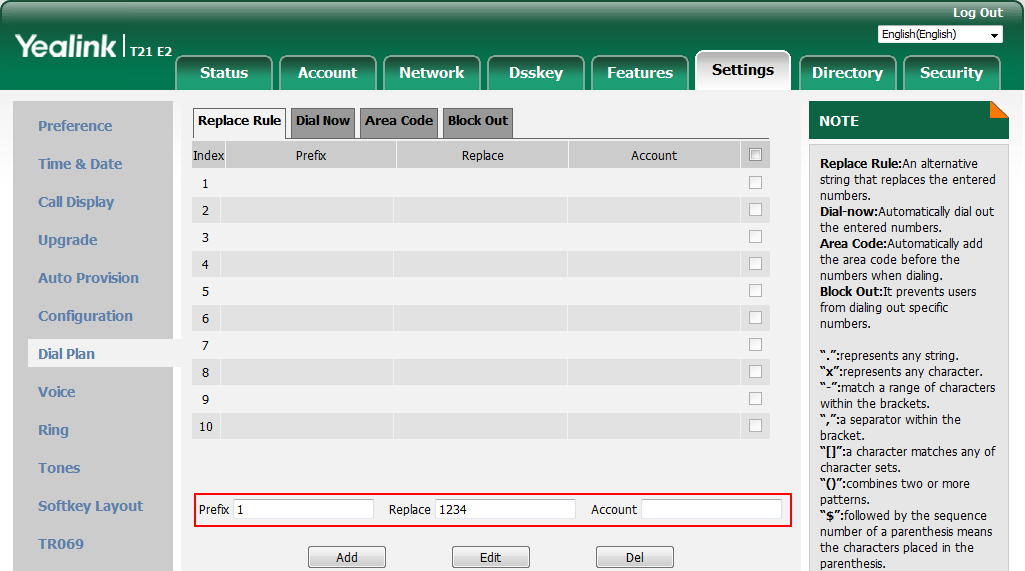

5.
Click Add to add the replace rule.
When you enter the number “1” using the keypad and then press the Send soft key, the
phone will dial out “1234” instead.
The valid values of Account field can be one or two digits between 1 and 2. Every two digits must

be separated by a comma. For example, when you enter the value “1, 2” in the Account field, this
replace rule will apply to account 1 and account 2.
If you leave the Account field blank or enter 0, the replace rule will apply to all accounts.

To edit a replace rule via web user interface:
1.
Click on Settings->Dial Plan->Replace Rule.
2.
Select the desired replace rule by checking the check box.
3.
Edit the values in the Prefix and Replace fields.
4.
Enter the desired line ID in the Account field or leave it blank.
5.
Click Edit to accept the change.
To delete one or more replace rules via web user interface:
1.
Click on Settings->Dial Plan->Replace Rule.
2.
Select one or more replace rules by checking the check box(es).
| Page 83 |
Customizing Your Phone

3.
Click Del to delete the replace rule(s).
Note
Replace rule is configurable via web user interface only.


Dial Now
You can configure one or more dial now rules (up to 100) on your phone. When the dialed
number matches the dial now string, the number will be dialed out automatically. For example, a
dial now rule is configured as "1xx", any entered three-digit string beginning with 1 will then be
dialed out automatically on the phone.
To add a dial now rule via web user interface:
1.
Click on Settings->Dial Plan->Dial Now.
2.
Enter the desired value (e.g., 1xx) in the Rule field.
3.
Enter the desired line ID in the Account field or leave it blank.
For more information on the valid values for the Account field, refer to Replace Rule on
page 81.
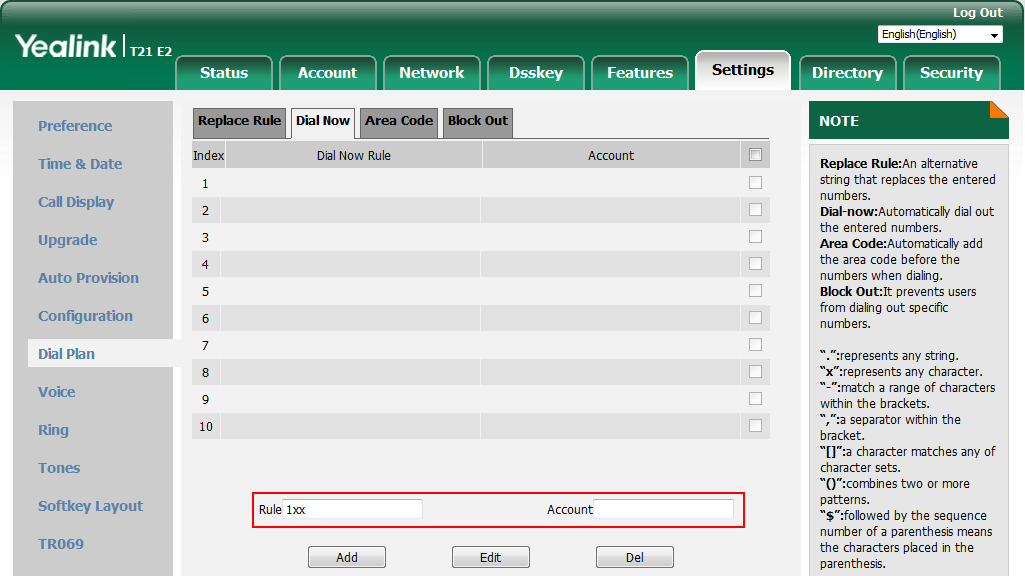

4.
Click Add to add the dial now rule.
When you enter the number “123” using the keypad, the phone will dial out “123”
automatically without pressing any key.
Note
You can also edit or delete the dial now rule, refer to Replace Rule on page 81 for more

information.
Dial now rule is configurable via web user interface only.

Time Out for Dial now Rule
You can configure the delay time for dial now rules. That is, you can configure your phone to
automatically dial out the phone number which matches a dial now rule, after the designated
83
| Page 84 |
User Guide for the SIP
Area Code

Note
84
-T21(P) E2 IP Phone
delay time.
To configure the time out for dial now rule via web user interface:
1.
Click on Features->General Information.
2.
Enter the time between 0 and 14 (seconds) in the Time Out for Dial Now Rule field.
The default value is “1”.
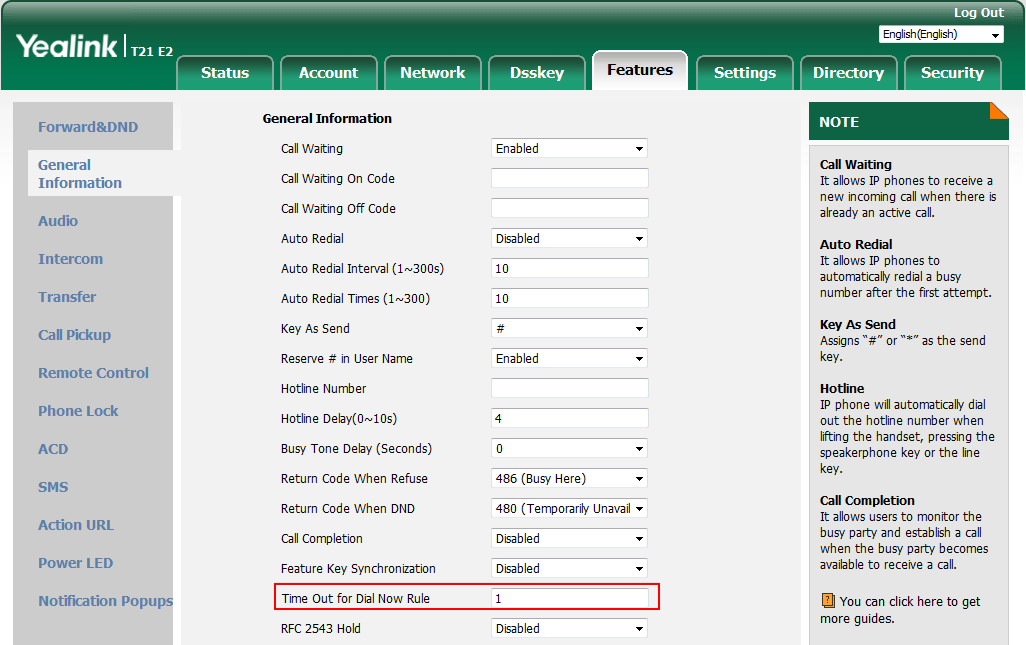

3.
Click Confirm to accept the change.
Time out for dial now rule is configurable via web user interface only.


Area codes are also known as Numbering Plan Areas (NPAs). They usually indicate geographical
areas in a country. This feature is necessary when dialing a phone number outside the code area.
For example, an area code is configured as "Code: 0592, Min Length: 1, Max Length: 15". When
you dial out the number "56789" (the length of the number is between 1 and 15), the phone will
add the area code and dial out the number "059256789". You can only configure one area code
rule on your phone.
To configure the area code via web user interface:
1.
Click on Settings->Dial Plan->Area Code.
2.
Enter the desired values in the Code, Min Length (1-15) and Max Length (1-15) fields.
3.
Enter the desired line ID in the Account field or leave it blank.
| Page 85 |
Note
Block Out

Customizing Your Phone
For more information on the valid values for the Account field, refer to Replace Rule on
page 81.
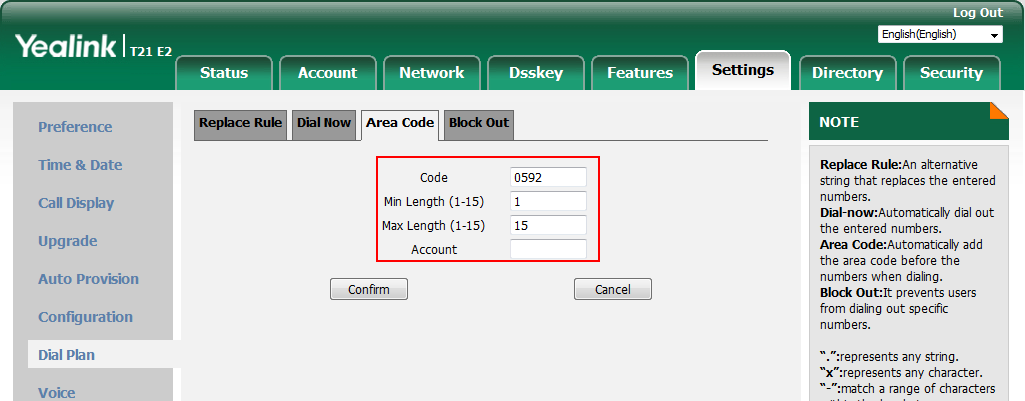

4.
Click Confirm to accept the change.
The default value of minimum and maximum length is 1 and 15 respectively.

Area code is configurable via web user interface only.

You can block some specific numbers (up to 10) from being dialed on your phone. When you
dial a block out number on your phone, the dialing will fail and the LCD screen will prompt
"Forbidden Number".
To add a block out number via web user interface:
1.
Click on Settings->Dial Plan->Block Out.
2.
Enter the desired value in the BlockOut NumberX field.
3.
Enter the desired line ID in the Account field or leave it blank.
For more information on the valid values for the Account field, refer to Replace Rule on
page 81.
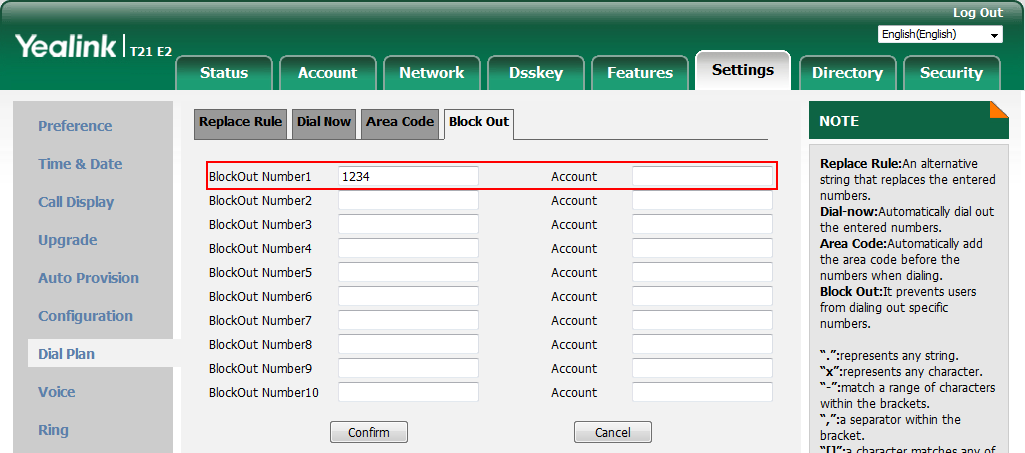

85
| Page 86 |
User Guide for the SIP
Emergency Number

Note
Note
Note
86
-T21(P) E2 IP Phone
4.
Click Confirm to add the block out number.

Block out number is configurable via web user interface only.

Public telephone networks in countries around the world have a single emergency telephone
number (emergency services number), that allows a caller to contact local emergency services
for assistance when necessary. The emergency telephone number may differ from country to
country. It is typically a three-digit number so that it can be easily remembered and dialed
quickly. Some countries have a different emergency number for each of the different emergency
services.
You can specify the emergency telephone numbers on the IP phone for contacting the
emergency services in an emergency situation. You can dial these numbers when the phone is
locked. For more information on phone lock, refer to Phone Lock on page 43.
Contact your local phone service provider for available emergency numbers in your area.

The IP phone also supports the emergency dialplan, which allows users to make emergency calls
if the phone is locked or unregistered. For more information, contact your system administrator.

To specify emergency numbers via web user interface:
1.
Click on Features->Phone Lock.
2.
Enter the emergency number in the Emergency field.
For multiple emergency numbers, enter a comma between every two emergency numbers.
The default emergency numbers are 112, 911 and 110.
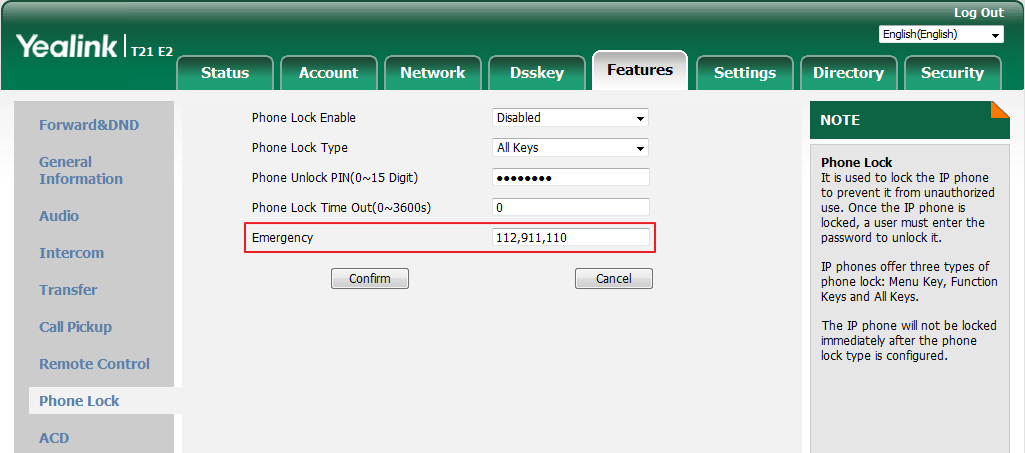

3.
Click Confirm to accept the change.


Emergency number is configurable via web user interface only.
| Page 87 |
Live Dialpad
ine

Note
Hotl
Customizing Your Phone
You can enable live dialpad feature on the SIP-T21(P) E2 IP phone, which enables the IP phone
to automatically dial out a phone number without pressing the send key. You can also configure
a delay, and then the phone will dial out the phone number automatically after the designated
period of time.
To enable live dialpad via web user interface:
1.
Click on Settings->Preference.
2.
Select Enabled from the pull-down list of Live Dialpad.
3.
Enter the desired delay time in the Inter Digit Time(1~14s) field.
The default delay time is 4.
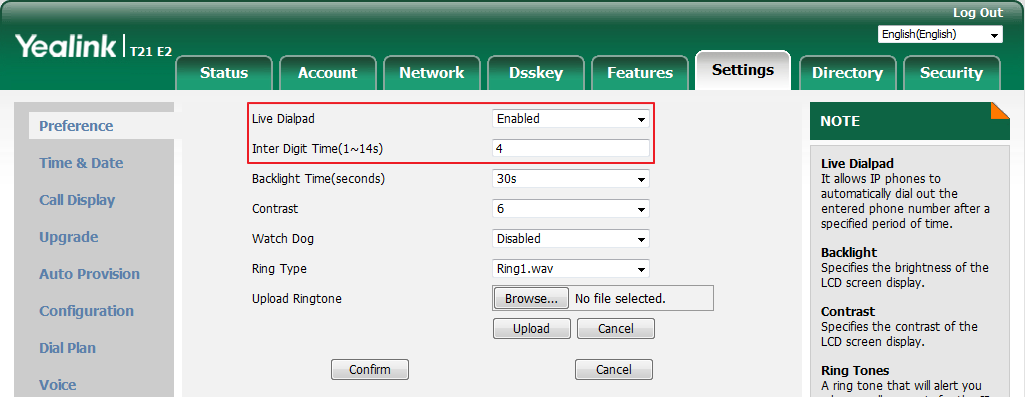

4.
Click Confirm to accept the change.

Live dialpad is configurable via web user interface only.

You can dial a hotline number immediately upon lifting the handset, pressing the Speakerphone
key or the line key. You can also configure a delay, and then the phone will dial out the hotline
number automatically after the designated period of time.
To configure the hot line number via phone user interface:
1.
Press Menu->Features->Hot Line.
2.
Enter the desired number in the Hotline Number field.


87
| Page 88 |
User Guide for the SIP-T21(P) E2 IP Phone

3.
Enter the delay time in the Hotline Delay field.
The valid values range from 0 to 10 (seconds) and the default value is 4.
4.
Press the Save soft key to accept the change or the Back soft key to cancel.
Hotline is configurable via web user interface at the path Features->General Information.
88
| Page 89 |
Basic Call Features
someone
hone. Topics include:
If you require additional information or assistance with your new phone, contact your system

Basic Call Features
The SIP-T21(P) E2 IP phone is designed to be easily used like a regular phone on a public
switched telephone network (PSTN). You can place calls, answer calls, transfer a call to
else, or conduct a conference call.
This chapter provides basic operating instructions for the SIP-T21(P) E2 IP p
Placing Calls
Answering Calls
Ending Calls
Redialing Numbers
Recent Call In
Dialing
Auto Redial
Call Completion
Re
C
all
Call Mute
Call Hold/Resume
Do Not Disturb (DND)
Call Transfer
Call Waiting
Conference
Call Park
/
Retrieve
Call Pickup
Anonymous Call
Anonymous Call Rejection
administrator.
Placing Calls
You can place a call in one of three ways using your SIP-T21(P) E2 IP phone:
Using the handset
Using the speakerphone
Using the headset

89
| Page 90 |
User Guide for the SIP-T21(P) E2 IP Phone

You can also dial the number first, and then choose the way you want to speak to the other
party.
You can also search and dial a contact from local directory, remote phone book or call history.
For more information, refer to Contact Management on page 49 and Call History Management
on page 63.
During a call, you can alternate between Speakerphone, Headset and Handset modes by
pressing the Speakerphone key, the HEADSET key, or by picking up the handset.
The call duration of the active call and far-site’s information (name or phone number) are visible
on the LCD screen. In the figure below, the call to “1040” (the phone number: 1040) has lasted 1
seconds.


To place a call using the handset:
1.
Pick up the handset.
2.
Enter the desired number using the keypad.


3.
Press , , or the Send soft key.
The # key is configured as a send key by default. You can also set the * key as the send key, or
set neither. For more information, refer to Key As Send on page 42.
Note
You can also dial using the SIP URI or IP address. To obtain the IP address of a phone, press the

OK key when the phone is idle. The maximum SIP URI or IP address length is 32 characters. For
example, SIP URI: 2210@sip.com, IP: 192.168.1.15 or 192*168*1*15.
Your phone may not support direct IP dialing. Contact your system administrator for more
information.

To place a call using the hands-free (speakerphone) mode:
Do one of the following:

-
With the handset on-hook, press or the line key to obtain a dial tone.
Enter the desired number using the keypad.

Press , , or the Send soft key.

-
With the handset on-hook, enter the desired number using the keypad.

Press , , , or the Send soft key.


90
| Page 91 |
Basic Call Features
phone can handle multiple calls at a time. However, only one active call (the
call that has audio associated with it) can be in progress at any time, other calls are placed on
hone. To place a new call during an

To place a call using the headset:
Do one of the following:

-
With the optional headset connected, press to activate the headset mode.
Press the line key to obtain a dial tone.
Enter the desired number using the keypad.


Press , , or the Send soft key.
-
With the optional headset connected, press to activate the headset mode.

Enter the desired number using the keypad.

Press , , or the Send soft key.

Note
To permanently use the headset mode, refer to Headset Prior on page 68.
The SIP-T21(P) E2 IP
hold. The SIP-T21(P) E2 IP phone can handle a maximum of 50 calls at one time.
To place multiple calls:
You can have more than one call on your SIP-T21(P) E2 IP p
active call, do one of the following:
-
Press the line key. The active call is placed on hold.
Enter the desired number using the keypad.

Press , , or the Send soft key.

-
Press the Hold soft key to place the original call on hold.
Press the NewCall soft key.
Enter the desired number using the keypad.

Press , , or the Send soft key.

You can press or to switch between calls, and then press the Resume soft key to

retrieve the desired call.

Note
If multiple accounts are registered on the phone, you can first press the desired line key on the
idle screen or press the Line soft key on the dialing screen, and then you can use the selected
account to place a call.






91
| Page 92 |
ate
soft key.
with the
following:
User Guide for the SIP-T21(P) E2 IP Phone

Answering Calls
When you are not in another call, you can answer a call in one of three ways:
Using the handset
Using the speakerphone
Using the headset
Note
You can reject incoming calls by pressing the Reject soft key or the X key. You can also activ
Do Not Disturb mode to ignore all incoming calls without ring on your phone. For more
information, refer to Do Not Disturb (DND) on page 100.
You can forward incoming calls to someone else by pressing the FWD soft key. For more
information, refer to Call Forward on page 104.
Answering When Not in Another Call
Call duration and destination will always appear on the LCD screen for the active call.
To answer a call using the handset:
1.
Pick up the handset.
To answer a call using the hands-free (speakerphone) mode:
Do one of the following:

-
Press .
-
With the handset on-hook and the headset mode deactivated, press the Answer
-
With the handset on-hook and the headset mode deactivated, press the line key
fast-flashing green LED indicator.
To answer a call using the headset:
Do one of the following:

-
Press .
-
With the headset mode activated, press the Answer soft key.
-
With the headset mode activated, press the line key with the fast-flashing green LED
indicator.
Answering When in Another Call
If you have an active call, and an incoming call arrives on the phone, do one of the
-
Press the Answer soft key.
The incoming call is answered and the original call is placed on hold.

-
Press to access the new call.
92



| Page 93 |
Basic Call Features

Press or the Answer soft key.

The incoming call is answered and the original call is placed on hold.
Auto Answer
You can use auto answer feature to automatically answer an incoming call using the
speakerphone. Auto answer is configurable on a per-line basis.
You can choose to mute the local microphone when an incoming call is answered automatically.
To configure auto answer via phone user interface:
1. Press Menu->Features->Auto Answer.

2. Press or , or the Switch soft key to select the desired account from the Line ID

field.


3. Press or , or the Switch soft key to select Enabled from the Status field.


4. Press the Save soft key to accept the change or the Back soft key to cancel.
The icon appears on the LCD screen only when the auto answer feature is enabled for

the default account.


Auto answer is configurable via web user interface at the path Account->Basic.
Note
A
uto answer only
takes effect
when
there is
no
other
call in progress on the phone
. If there is a

call in progress, the second incoming call cannot be automatically answered after ending the
current call by default. If you want to make the phone automatically answer the incoming call
after ending all calls, contact your system administrator for more information.

93
| Page 94 |
User Guide for the SIP-T21(P) E2 IP Phone

Ending Calls
To end a call:
Do one of the following:
-
If you are using the handset, press the EndCall soft key or hang up the handset.
-
If you are using the headset, press the EndCall soft key.

-
If you are using the speakerphone, press or the EndCall soft key.
Redialing Numbers
To redial the last dialed number from your phone:

1.
Press twice.
A call to your last dialed number is attempted.
To redial a previously dialed number from your phone:

1.
Press when the phone is idle.


2.
Press or to select the desired entry from the placed calls list, and then press

or the Send soft key.
Recent Call In Dialing
To view the placed calls list when the phone is on the dialing screen, you should enable recent
call in dialing in advance.
To enable recent call in dialing via web user interface:
1.
Click on Directory->Setting.
94
| Page 95 |
Basic Call Features

2.
Select Enabled from the pull-down list of Recent Call In Dialing.
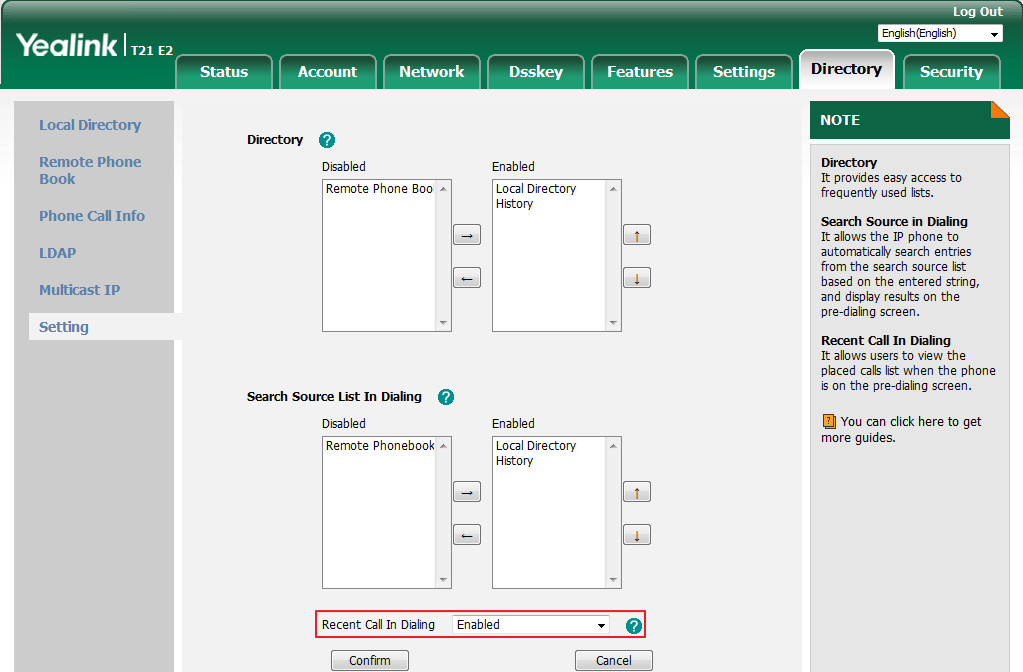

3.
Click Confirm to accept the change.
Note
Recent call in dialing is configurable via web user interface only.


To view placed calls list when the phone is on the dialing screen:
1.
Pick up the handset, press the Speakerphone key or press the line key.
The LCD screen displays the placed calls list.


You can also enter a few continuous characters of the contact name or continuous numbers
of the contact number (office, mobile or other number) to search from placed calls list.


95
| Page 96 |
User Guide for the SIP
Auto Redial

96
-T21(P) E2 IP Phone
You can enable auto redial to automatically redial a phone number when the called party is busy.
You can also configure the number of auto redial attempts and the time to wait between redial
attempts.
To configure auto redial via phone user interface:
1.
Press Menu->Features->Auto Redial.


2.
Press or , or the Switch soft key to select Enabled from the Auto Redial field.


3.
Enter the desired time (in seconds) in the Redial Interval field.
The default value is 10.
4.
Enter the desired number of redial attempts in the Redial Times field.
The default value is 10.
5.
Press the Save soft key to accept the change or the Back soft key to cancel.
Auto redial is configurable via web user interface at the path Features->General Information.
To use auto redial:
When the called party is busy, the following prompt will appear on the LCD screen of the phone:


1.
Press the OK soft key to activate auto redial. The following prompt will appear on the LCD
screen of the phone:


2.
Wait for the designated period of time or press the OK soft key to redial the phone
| Page 97 |
Basic Call Features

number.
The phone will retry as many times as configured until the called party is idle.
Call Completion
You can use call completion to notify the caller who failed to reach a desired party when the
party becomes available to receive a call.
To configure call completion via phone user interface:
1.
Press Menu->Features->Call Completion.

2.
Press or , or the Switch soft key to select Enabled from the Call Completion

field.


3.
Press the Save soft key to accept the change or the Back soft key to cancel.
Call completion is configurable via web user interface at the path Features->General
Information.
To use call completion:
When the called party is busy, the following prompt will appear on the LCD screen of the phone:


1.
Press the OK soft key, the phone returns to the idle screen and call completion is activated.
When the called party becomes idle, the following prompt will appear on the LCD screen of the
phone:


97
| Page 98 |
User Guide for the SIP-T21(P) E2 IP Phone

1.
Press the OK soft key to redial the number.
Note
Call completion is not available on all servers. For more information, contact your system

administrator.

ReCall
You can press a recall key to place a call back to the last incoming call.
To configure a recall key via phone user interface:
1.
Press Menu->Features->DSS Keys.
2.
Select the desired DSS key.

3.
Press or , or the Switch soft key to select Key Event from the Type field.

4.
Press or , or the Switch soft key to select ReCall from the Key Type field.




5.
(Optional.) Enter the string that will appear on the LCD screen in the Label field.
6.
Press the Save soft key to accept the change or the Back soft key to cancel.
Recall key is configurable via web user interface at the path Dsskey->Line Key.
Call Mute
You can mute the microphone of the active audio device during an active call so that the other
party cannot hear you. You can also mute the microphone while dialing so that the other party
cannot hear you when the call is set up. It helps prevent the other party from hearing the
informal discussion when auto answer is enabled on his/her phone.
Call mute applies to all modes (Handset, Headset and Speakerphone).
98
| Page 99 |
Basic Call Features

Keep Mute
Normally, the mute feature is deactivated when the active call ends. Keep mute feature enables
you to make the mute state of your phone persist across calls. When keep mute is enabled and
you press the MUTE key, the phone stays in the mute state until you un-mute the microphone
or until the phone restarts. It helps prevent the other party from hearing the noise coming from
your room when auto answer is enabled on your phone. When you mute the phone in an idle

state or any other states, the mute key LED illuminates solid red and the icon appears on the
status bar.


Note
Keep mute should be pre-configured by your system administrator.


To mute a call:

1.
Press during an active call.
The LCD screen indicates that the call is now muted.


To un-mute a call:

1.
Press again to un-mute the call.
Call Hold/Resume
You can place an active call on hold. Only one active call can be in progress at any time. Other
calls can be made and received while placing the original call on hold. When you place a call on
hold, your IP PBX may play music to the other party while waiting.
To place a call on hold:
1.
Press the Hold soft key during a call.
99
| Page 100 |
User Guide for the SIP
Do Not Disturb (DND)

Note
Note
100
-T21(P) E2 IP Phone
The line key LED flashes green. The LCD screen indicates that the call is on hold.


The phone will beep softly every 30 seconds to remind you that you still have a call on hold. The

phone ignores engaged audio device (handset or headset) and switches to Speakerphone to play
the hold tone by default.

To resume a held call:
1.
Press the Resume soft key.
Multiple Calls on Hold:
If multiple calls are placed on hold, do one of the following:


-
Press or to switch between the calls, and then press the Resume soft key to
retrieve the desired call.
-
Press the corresponding line key to retrieve the call.
If more than one call is placed on hold, a numbered prompt appears on the LCD screen, for
example “2/3”, indicating that this is the second call out of three calls.
You can use DND to reject incoming calls automatically on the phone. The prompt message "n
New Missed Call(s)" ("n" indicates the number of missed calls, e.g., 1 New Missed Call(s)) will
appear on the LCD screen, and callers will receive a busy message. All calls you receive while
DND is activated are logged to your missed calls list.


The prompt message will display only if Missed Call Log for the line is enabled. Missed call log is

configurable via web user interface at the path Account->Basic.
You cannot activate or deactivate DND when DND feature is disabled. Contact your system

administrator for more information.
| Page 101 |
Basic Call Features

When DND feature is activated, the IP phone supports displaying a large DND icon on the idle
screen. For more information, contact your system administrator.


You can activate/deactivate DND for the phone system, or you can customize DND for each or
all accounts.
There are two DND modes:
Phone
(default):
DND is effective for the phone system.
Custom
:
DND can be configured for each or all accounts.
To configure the DND mode via web user interface:
1.
Click on Features->Forward&DND.
2.
In the DND block, mark the desired radio box in the Mode field.
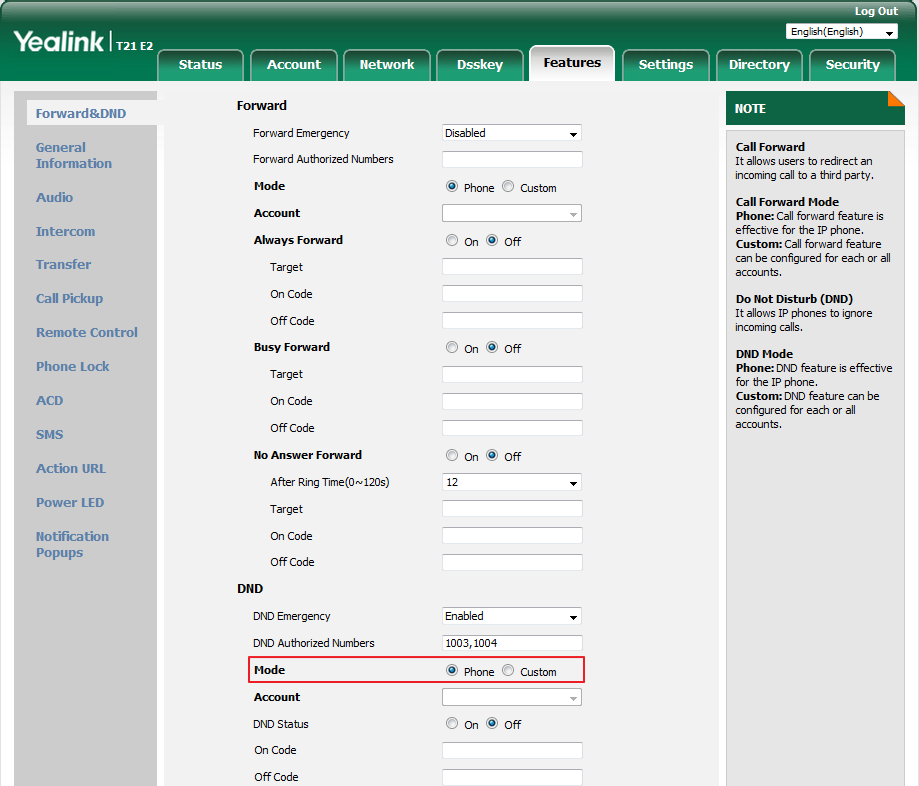

3.
Click Confirm to accept the change.
Note
DND mode is configurable via web user interface only.


101
| Page 102 |
User Guide for the SIP-T21(P) E2 IP Phone

To activate DND in phone mode:
1. Press the DND soft key when the phone is idle.
The icon appears on the status bar.



Note
When
destination number.
DND and busy forward are
activated
For more information on busy forward, refer to
in phone mode
,
calls will be sent to the configured
Call Forward
on page
104
.


To activate DND in custom mode:

1. Press the DND soft key when the phone is idle.
The LCD screen displays a list of accounts registered on the phone.


2. You can activate it for a specific account:

1) Press or to select the desired account and then press the Enter soft key.

2) Press or , or the Switch soft key to select Enabled from the DND Status

field.

3) (Optional.) Enter the DND on code or off code respectively in the On Code or Off
Code field.
If the on code or off code is configured, the IP phone will send the corresponding code
to activate or deactivate DND on the server. It is not available on all servers.
You can also activate DND for all accounts:
1) Do the following:
-
Press the All On soft key if DND on code and off code are not needed on your
server.


-
After DND was activated for a specific account on the step 2, press or to
highlight the DND Status field.
102
| Page 103 |
Basic Call Features

Press the All Lines soft key. The LCD screen prompts “Copy to all lines?”.


Press the OK soft key to accept the change or the Cancel soft key to cancel.
3. Press the Save soft key to accept the change.
If you activate DND for the default account, the associated line icon will change to , and

the icon will appear on the status bar.



If you activate DND for the non-default account, only the associated line icon will change
to .



If you activate DND for all accounts, all line icons will change to , and the icon will

appear on the status bar.



Note
When DND and busy forward are both activated for a specific account, calls to the specific

account will be sent to the configured destination number. For more information on call forward,
refer to Call Forward on page 104.

You can receive incoming calls from authorized numbers when DND is activated.

103
| Page 104 |
User Guide for the SIP
default. If you want to disable the
field.

Note
104
-T21(P) E2 IP Phone
To configure the DND authorized numbers via web user interface:
1.
Click on Features->Forward&DND.
2.
Select Enabled from the pull-down list of DND Emergency.
3.
Enter the numbers in the DND Authorized Numbers field.
For multiple numbers, enter a comma between every two numbers.
4.
Click Confirm to accept the change.
When DND is activated on the phone, the phone can still receive incoming calls from the
numbers specified in the DND Authorized Numbers field.
DND authorized number is configurable via web user interface only.
When the phone misses a call, a prompt window will pop up by
feature, contact your system administrator for more information.
To deactivate DND in phone mode:
1.
Press the DND soft key when the phone is idle.
To deactivate DND in custom mode:
1.
Press the DND soft key when the phone is idle.

2.
Press or to select the desired account and then press the Enter soft key.

3.
Press or , or the Switch soft key to select Disabled from the DND Status
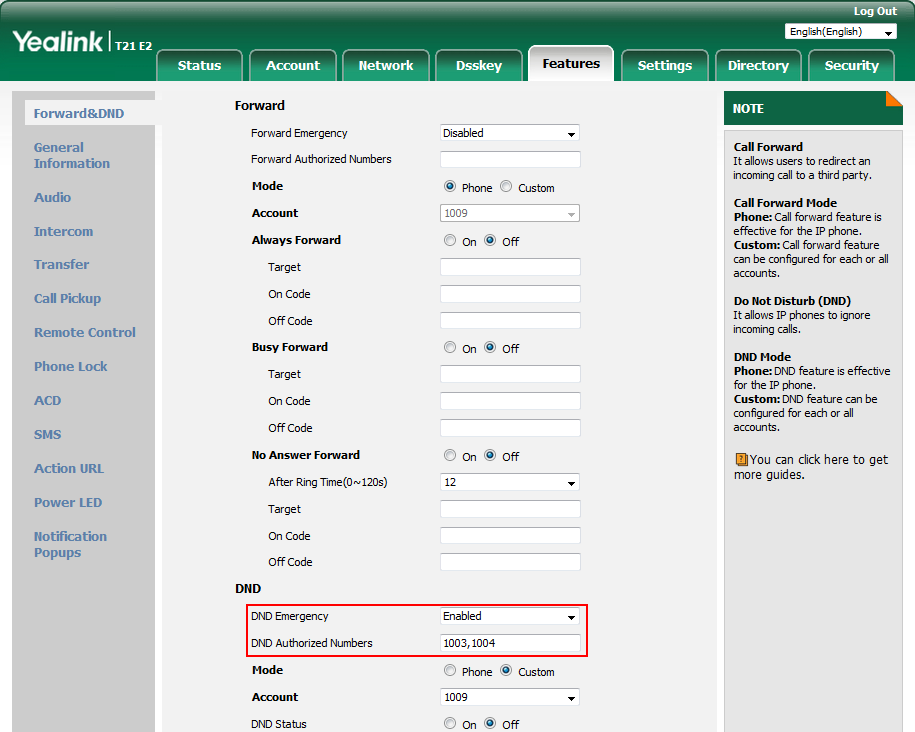





| Page 105 |
Call Forward
Note
Static Forwarding

Basic Call Features
If you want to deactivate DND for all accounts, press the All Lines soft key.
4.
Press the Save soft key to accept the change.
You can configure your phone to forward incoming calls to another party (static forwarding).
You can also forward calls while your phone is ringing (dynamic forwarding).
When the phone forwards a call, a prompt window will pop up by default. If you want to disable

the feature, contact your system administrator for more information.
You cannot activate or deactivate call forward when call forward feature is disabled. Contact your
system administrator for more information.

Three types of static forwarding are:
Always Forward
:
Incoming calls are immediately forwarded.
Busy Forward
:
Incoming calls are immediately forwarded if the phone is busy.
No Answer Forward
:
Incoming calls are forwarded if not answered after
a period of time.
You can activate/deactivate call forward for the phone system, or you can customize call forward
for each or all accounts.
There are two call forward modes:
Phone
(default)
:
Call forwar
d is effective for the phone system.
Custom:
Call forward can be configured for each or all accounts.
To configure the call forward mode via web user interface:
1. Click on Features->Forward&DND.
105
| Page 106 |
User Guide for the SIP

Note
106
-T21(P) E2 IP Phone
2. In the Forward block, mark the desired radio box in the Mode field.
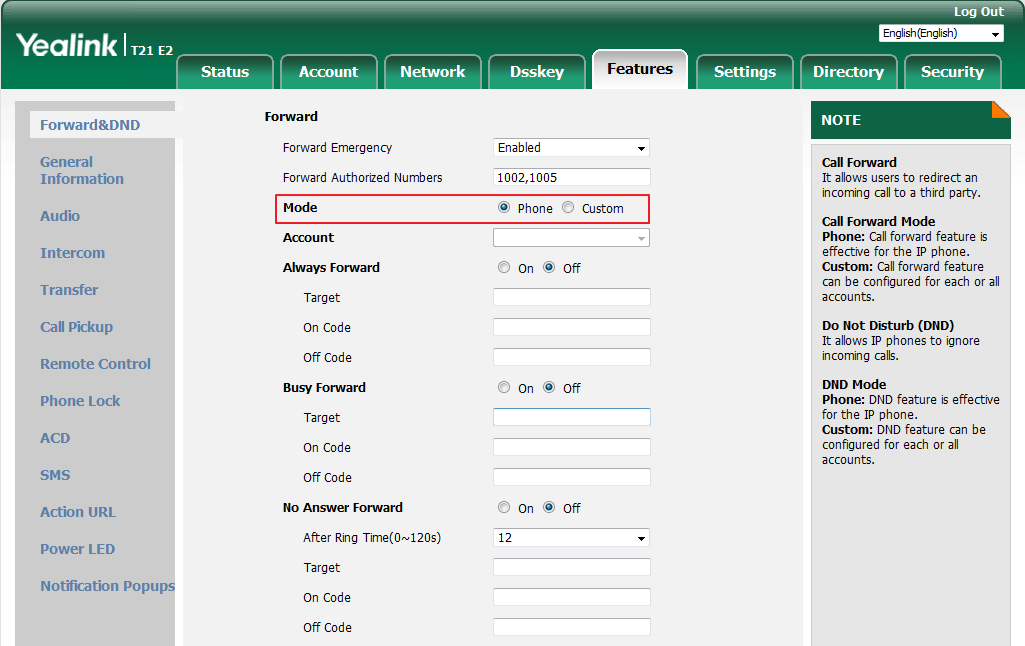

3. Click Confirm to accept the change.
Call forward mode is configurable via web user interface only.


To activate call forward in phone mode:

1.
Press Menu->Features->Call Forward or press when the phone is idle.

2.
Press or to select the desired forwarding type, and then press the Enter soft key.

3.
Depending on your selection:
a)
If you select Always Forward:

1)
Press or , or the Switch soft key to select Enabled from the Always

Forward field.


2)
Enter the destination number you want to forward all incoming calls to in the
Forward to field.
3)
(Optional.) Enter the always forward on code or off code respectively in the On
Code or Off Code field.
b) If you select Busy Forward:


1)
Press or , or the Switch soft key to select Enabled from the Busy
| Page 107 |
activate

4.
To
1.
2.
3.
Basic Call Features
Forward field.


2)
Enter the destination number you want to forward incoming calls to when the
phone is busy in the Forward to field.
3)
(Optional.) Enter the busy forward on code or off code respectively in the On
Code or Off Code field.
c)
If you select No Answer Forward:

1)
Press or , or the Switch soft key to select Enabled from the No

Answer Forward field.


2)
Enter the destination number you want to forward unanswered incoming calls
to in the Forward to field.
3)
Press or , or the Switch soft key to select the ring time to wait before

forwarding from the After Ring Time field.

The default ring time is 12.
4)
(Optional.) Enter the no answer forward on code or off code respectively in the
On Code or Off Code field.
Press the Save soft key to accept the change or the Back soft key to cancel.
The icon on the status bar indicates that the call forward is activated.

call forward in custom mode:

Press Menu->Features->Call Forward or press when the phone is idle.

Press or to select the desired account, and then press the Enter soft key.



Press or to select the desired forwarding type, and then press the Enter soft key.


107
| Page 108 |
User Guide for the SIP-T21(P) E2 IP Phone

4.
Depending on your selection:
a)
If you select Always Forward, you can activate it for a specific account.
1)
Press or , or the Switch soft key to select Enabled from the Always

Forward field.



2)
Enter the destination number you want to forward all incoming calls to in the
Forward to field.
3)
(Optional.) Enter the always forward on code or off code respectively in the On
Code or Off Code field.
You can also activate always forward for all accounts, do the following:


1)
Press or to highlight the Always Forward field.
2)
Press the All Lines soft key.
The LCD screen prompts “Copy to all lines?”.


3)
Press the OK soft key to accept the change or the Cancel soft key to cancel.
b) If you select Busy Forward, you can activate it for a specific account.

1)
Press or , or the Switch soft key to select Enabled from the Busy

Forward field.


2)
Enter the destination number you want to forward all incoming calls to when
the phone is busy in the Forward to field.
3)
(Optional.) Enter the busy forward on code or off code respectively in the On
Code or Off Code field.
You can also activate busy forward for all accounts, do the following:
108
| Page 109 |
Press the
activate

c)
5.
If you
Basic Call Features

1)
Press or to highlight the Busy Forward field.

2)
Press the All Lines soft key.
The LCD screen prompts “Copy to all lines?”.


3)
Press the OK soft key to accept the change or the Cancel soft key to cancel.
If you select No Answer Forward, you can activate it for a specific account.

1)
Press or , or the Switch soft key to select Enabled from the No Answer

Forward field.


2)
Enter the destination number you want to forward all unanswered incoming calls
to in the Forward to field.

3)
Press or , or the Switch soft key to select the ring time to wait before

forwarding from the After Ring Time field.
The default ring time is 12.
4)
(Optional.) Enter the no answer forward on code or off code respectively in the
On Code or Off Code field.
You can also activate no answer forward for all accounts, do the following:

1)
Press or to highlight the No Answer Forward field.

2)
Press the All Lines soft key.
The LCD screen prompts “Copy to all lines?”.


3) Press the OK soft key to accept the change or the Cancel soft key to cancel.
Save soft key to accept the change or the Back soft key to cancel.
call forward for the default account, the associated line icon will change to ,

109
| Page 110 |
User Guide for the SIP-T21(P) E2 IP Phone

and the icon will appear on the status bar.



If you activate call forward for the non-default account, only the associated line icon will change
to .



If you activate call forward for all accounts, all line icons will change to , and the icon will

appear on the status bar.



If the forward on code or off code is configured, the IP phone sends the corresponding code to
the server when a certain action takes place. For example, if you set the Always Forward on code
to be *71 (may vary on different servers), and the target number to be 1234. When you activate
Always Forward on the IP phone, the IP phone sends *711234 to the server, and then the server
will activate Always Forward feature on the server side, hence being able to get the right status
of the extension.
Call forward is configurable via web user interface at the path Features->Forward&DND.
Note
You can also enter the SIP URI or IP address in the Forward to field. For more information on

using the SIP URI or IP address, refer to Placing Calls on page 89.
Call forward is local to the phone, and may be overridden by the server settings. Call forward on
code or off code may be different between servers. For more information, contact your system
administrator.

To configure the forward authorized numbers via web user interface:
1.
Click on Features->Forward&DND.
2.
Select Enabled from the pull-down list of Forward Emergency.
110
| Page 111 |
Basic Call Features

3.
Enter the numbers in the Forward Authorized Numbers field.
For multiple numbers, enter a comma between every two numbers.
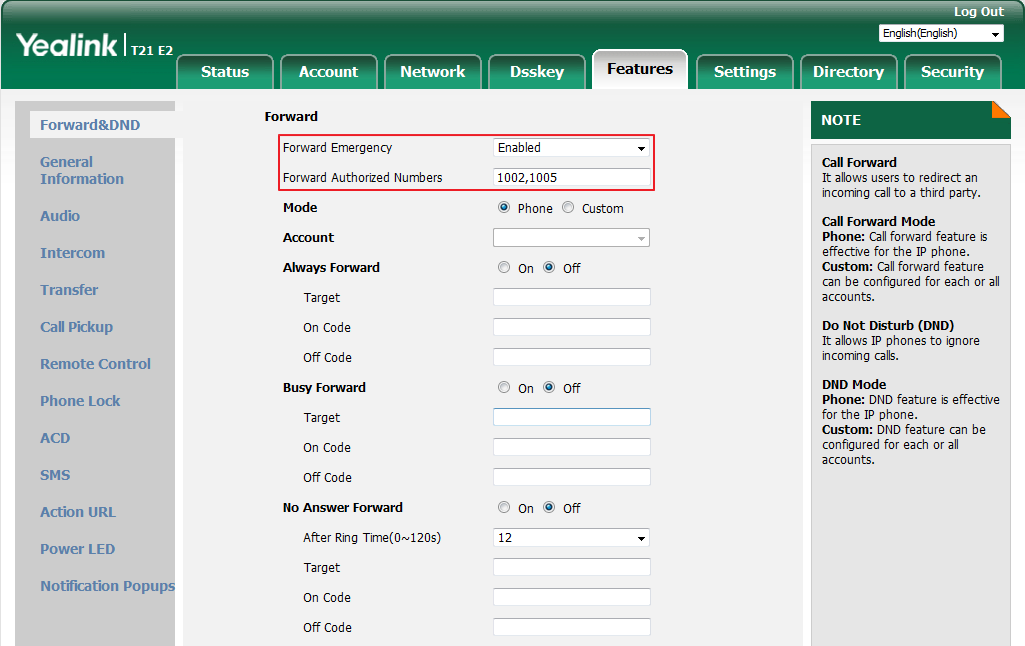

4.
Click Confirm to accept the change.
When call forward is activated on the phone, the phone cannot forward incoming calls
from the numbers specified in the Forward Authorized Numbers field.
Note
Forward authorized number is configurable via web user interface only.


To deactivate call forward in phone mode:
Do one of the following:

-
Press when the phone is idle.
-
Press Menu->Features->Call Forward.


Press or to select the desired forwarding type and then press the Enter soft key.

Press or , or the Switch soft key to select Disabled to deactivate the call forward.

Press the Save soft key to accept the change.
To deactivate call forward in custom mode:
1.
Press Menu->Features->Call Forward or press when the phone is idle.


2.
Press or to select the desired account and then press the Enter soft key.

3.
Press or to select the desired forwarding type and then press the Enter soft key.

4.
Press or , or the Switch soft key to select Disabled to deactivate the call forward.

If you want to deactivate call forward for all accounts, press the All Lines soft key.


5.
Press the Save soft key to accept the change.
111
| Page 112 |
User Guide for the SIP-T21(P) E2 IP Phone

Dynamic Forwarding
You can manually forward a call to another number while your phone rings.
To forward an incoming call to another party:
1.
When the phone is ringing, press the FWD soft key.
2.
Enter the number you want to forward the incoming call to.


3.
Press , , or the Send soft key.


The LCD screen prompts a call forward message.
Note
When the phone forwards a call, a prompt window will pop up by default, if you want to disable

the feature, contact your system administrator for more information.

Call Transfer
You can transfer a call to another party during a call in one of three ways:
Blind Transfer
: Transfer a call directly to another party without consulting.
Semi
-
Attended
Transfer
: Transfer a call when
the target phone is ringing
.
Attended Transfer
(Consultative Transfer)
: Transfe
r a call with prior consulting.
Allow Trans Exist Call
You can also transfer a call to another existing call during multiple calls.
To enable allow trans exist call via web user interface:
1.
Click on Features->General Information.
112
| Page 113 |
Basic Call Features

2.
Select Enabled from the pull-down list of Allow Trans Exist Call.
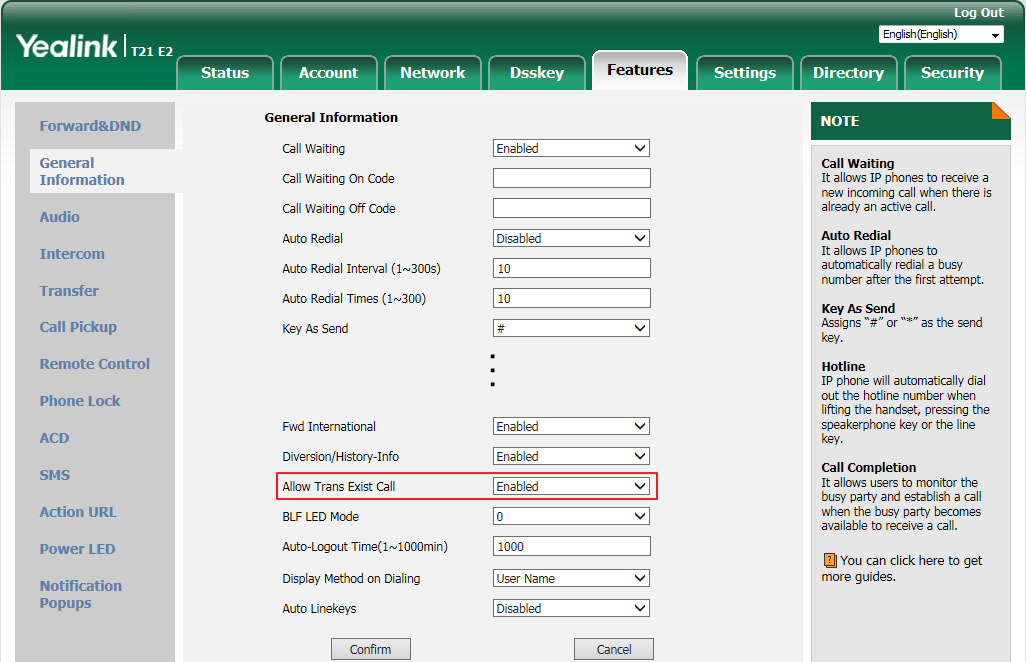

3.
Click Confirm to accept the change.
Blind Transfer
Before performing a blind transfer (except you use dial number method), make sure that the
transfer mode on DSS key is configured as Blind Transfer. For more information on how to
configure it, refer to Configuring Transfer Mode on DSS Key on page 133.
To perform a blind transfer during a call:

1.
Press or the Trans soft key during a call.
2.
You can do one of the following:
-
Enter the number you want to transfer the call to.


Press or the Trans soft key to complete call transfer.

If you are using a handset, the transfer can be completed by hanging up the handset.
-
Press the Dir soft key, and then select Local Directory. Select the desired group and
search for the contact (Directory should be configured in advance. Refer to Directory
on page 50 for more information).
113
| Page 114 |
User Guide for the SIP-T21(P) E2 IP Phone

Press , or the Send soft key to complete the transfer.


-
Press the Dir soft key, and then select History. Select the desired list and then press


or to select the entry (Directory should be configured in advance. Refer to
Directory on page 50 for more information).

Press , or the Send soft key to complete the transfer.

-
Press the Dir soft key, and then select Remote Phone Book. Select the desired group
and search for the contact (Directory should be configured in advance. Refer to
Directory on page 50 and Remote Phone Book on page 61 for more information).

Press , or the Send soft key to complete the transfer.

You can also perform a blind transfer to another existing call when there are multiple calls.
Before performing a blind transfer to another existing call, make sure that the Allow Trans Exist
Call is enabled. For more information, refer to Allow Trans Exist Call on page 112.
To perform a blind transfer during multiple calls:

1.
Press or the Trans soft key during a call.
2.
You can do one of the following:

-
Press or to select the desired hold call you want to transfer the call to.



Press or the Select soft key.

-
Select New Call, you can do one of the following:
Enter the number you want to transfer the call to.

Press or the Trans soft key to complete the transfer.
If you are using a handset, the transfer can be completed by hanging up the
handset.
Press the
Dir
soft key, and then select
Local Directory
. Select the desired group
and search for the contact (Directory should be configured in advance. Refer to
Directory on page 50 for more information).

Press , or the Send soft key to complete the transfer.

Press the
Dir
soft key, and then select
History
. Select the desired list and then

press or to select the entry (Directory should be configured in

advance. Refer to Directory on page 50 for more information).


Press , or the Send soft key to complete the transfer.
Press the
Dir
soft key, and then select
Remote Phone Book
. Select the desired
114
| Page 115 |
Basic Call Features

group and search for the contact (Directory should be configured in advance.
Refer to Directory on page 50 and Remote Phone Book on page 61 for more
information).

Press , or the Send soft key to complete the transfer.

Semi-attended Transfer
Before performing a semi-attended transfer (except you use dial number method), make sure
that the transfer mode on DSS key is configured as New Call or Attended Transfer. For more
information on how to configure it, refer to Configuring Transfer Mode on DSS Key on page
133.
To perform a semi-attended transfer:

1. Press or the Trans soft key during a call.
2. Do one of the following:
-
Enter the number you want to transfer the call to.

Press or to dial out.

-
Press the Dir soft key, and then select Local Directory. Select the desired group and
search for the contact (Directory should be configured in advance. Refer to Directory
on page 50 for more information).

Press , or the Send soft key to dial out.

-
Press the Dir soft key, and then select History. Select the desired list and then press

or to select the entry (Directory should be configured in advance. Refer to

Directory on page 50 for more information).

Press , or the Send soft key to dial out.

-
Press the Dir soft key, and then select Remote Phone Book. Select the desired group
and search for the contact (Directory should be configured in advance. Refer to
Directory on page 50 and Remote Phone Book on page 61 for more information).

Press , or the Send soft key to dial out.

-
If Allow Trans Exist Call (refer to Allow Trans Exist Call on page 112) is enabled, you
can select the NewCall and repeat steps mentioned above to complete transfer.

3. Press or the Trans soft key to complete the transfer when receiving ringback.
If you are using a handset, the transfer can be completed by hanging up the handset.
Attended Transfer
Before performing an attended transfer (except you use dial number method), make sure that
the transfer mode on DSS key is configured as New Call or Attended Transfer. For more
information on how to configure it, refer to Configuring Transfer Mode on DSS Key on page
115
| Page 116 |
User Guide for the SIP-T21(P) E2 IP Phone

133.
To perform an attended transfer:
1. Press or the Trans soft key during a call.

2. Do one of the following:
-
Enter the number you want to transfer the call to.

Press or to dial out.

-
Press the Dir soft key, and then select Local Directory. Select the desired group and
search for the contact (Directory should be configured in advance. Refer to Directory
on page 50 for more information).

Press , or the Send soft key to dial out.

-
Press the Dir soft key, and then select History. Select the desired list and then press

or to select the entry (Directory should be configured in advance. Refer to

Directory on page 50 for more information).

Press , or the Send soft key to dial out.

-
Press the Dir soft key, and then select Remote Phone Book. Select the desired group
and search for the contact (Directory should be configured in advance. Refer to
Directory on page 50 and Remote Phone Book on page 61 for more information).

Press , or the Send soft key to dial out.

-
If Allow Trans Exist Call (refer to Allow Trans Exist Call on page 112) is enabled, you
can select the NewCall and repeat steps mentioned above to complete transfer.

3. After the party answers the call, press or the Trans soft key to complete the transfer.
If you are using a handset, the transfer can be completed by hanging up the handset.
You can cancel the transfer before the call is connected by pressing the Cancel soft key.
Call Waiting
You can enable or disable call waiting on the phone. If call waiting is enabled, you can receive
another call while there is already an active call on the phone. Otherwise, another incoming call
is automatically rejected by the phone with a busy message when there is an active call on the
phone. You can also enable or disable the phone to play a warning tone when receiving another
call.
116
| Page 117 |
Conference
Local Conference

Note
Note
Note
Basic Call Features
To configure call waiting via phone user interface:
1.
Press Menu->Features->Call Waiting.

2.
Press or , or the Switch soft key to select Enabled from the Call Waiting field.



3.
Press or , or the Switch soft key to select Enabled from the Play Tone field.


4.
(Optional.) Enter the call waiting on code or off code respectively in the On Code or Off
Code field.
If on code or off code is configured, the IP phone will send the corresponding code to
activate or deactivate call waiting on the server. It is not available on all servers.
5.
Press the Save soft key to accept the change or the Back soft key to cancel.
Call waiting is configurable via web user interface at the path Features->General Information.
If on code or off code is not configured, the call waiting may not take effect. It depends on your

server. Contact your server administrator for more information.

You can create a conference with other two parties using the phone’s local conference. You can
create a conference between an active call and a call on hold by pressing the Conf soft key. The
SIP-T21(P) E2 IP phone also supports network conference.
Network conference is not available on all servers. For more information, contact your system

administrator.

The SIP-T21(P) E2 IP phone supports up to 3 parties (including yourself) in a conference call. This
is the default method of conference called Local Conference.
To set up a local conference call, make sure local conference feature is enabled. For more

information, contact your system administrator.

To set up a local conference call:
1.
Place a call to the first party.
117
| Page 118 |
User Guide for the SIP-T21(P) E2 IP Phone

2.
When the first party answers the call, press the Conf soft key to place a new call.
The active call is placed on hold.

3.
Enter the number of the second party and then press , , or the Send soft key.

4.
When the second party answers the call, press the Conf soft key again to join all parties in
the conference.


You can press or to see all parties in the conference.

To join two calls in a conference:

1.
Place two calls using two different accounts on the phone (for example, place the first call
using account 1, and then place the second call using account 2).

2.
Press or to select the call for conference and ensure that the call is active (for

example, select the call on account 1).
3.
Press the Conf soft key to join the two calls in the conference on the selected account.
During the conference call, you can do the following actions:
-
Press the Hold soft key to place the conference on hold.
-
Press the Split soft key to split the conference call into two individual calls on hold.

-
Press the Manage soft key, and then press or to select the desired party:

Press the
Far
Mute
soft key to
mute the party. The muted party can hear everyone, but
no one can hear the muted party.
Press the
Remove
soft key to remove the party from the conference call.
Press the
New
Call
soft key to place a new call.
Press the
Back
soft key to return to the previous screen.

-
Press to mute the conference call, all other participants can hear each other, but they
cannot hear you.
-
Press the EndCall soft key to drop the conference call.
Network Conference
You can use network conference feature on the SIP-T21(P) E2 IP phone to conduct a conference
with multiple participants.
118
| Page 119 |
Basic Call Features

This feature allows you to perform the following:
Join two calls to
gether into a conference call.
Invite another party
into an active conference call.
To use this feature, contact your system administrator for the network conference URI in
advance.
To configure network conference via web user interface:
1.
Click on Account->Advanced.
2.
Select the desired account from the pull-down list of Account.
3.
Select Network Conference from the pull-down list of Conference Type.
4.
Enter the conference URI (e.g., conference@example.com) in the Conference URI field.
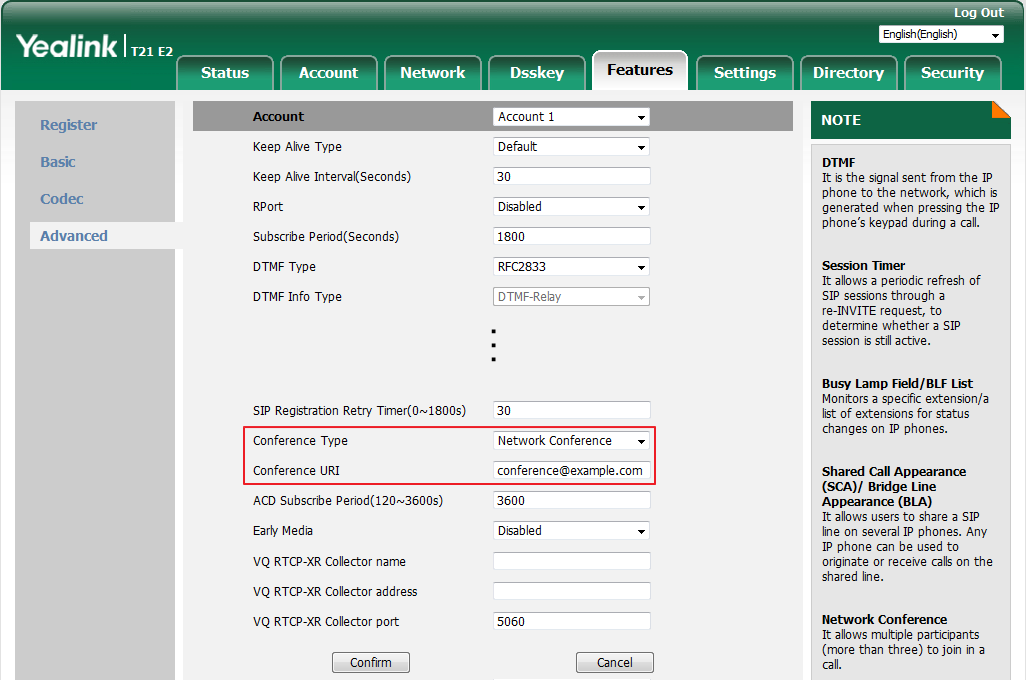

5.
Click Confirm to accept the change.
To set up a network conference call:
1.
Place a call to the first party.
2.
Press the Conf soft key to place a new call.
The active call is placed on hold.

3.
Enter the number of the second party and then press , , or the Send soft key.

4.
When the second party answers the call, press the Conf soft key to add the second party to
the conference.
5.
Press the Conf soft key to place a new call.
The conference is placed on hold.

6.
Enter the number of the new party and then press , , or the Send soft key.

7.
When the new party answers the call, press the Conf soft key to add the new party to the
119
| Page 120 |
User Guide for the SIP-T21(P) E2 IP Phone

conference.
8.
Repeat steps 5 to 7 until you have added all intended parties.
The procedures to set up a network conference call on specific servers may be different from
introduced above. Contact your system administrator for more information.
Call Park/Retrieve
You can use call park feature to place a call on hold, and then retrieve the call from another
phone in the system (for example, a phone in another office or conference room). You can park
an active call by pressing the Park soft key or call park key (if configured) on the phone. If the
call is parked successfully, there is a voice prompt confirming that the call was parked. You can
retrieve the parked call by pressing the Retrieve soft key or the retrieve park key (if configured).
If the parked call is not retrieved within a period of time defined by the system, the phone performing
call park will receive the call back.
Note
Call park is not available on all servers. Contact your system administrator for more information.


The IP phone supports call park feature under the following modes:
FAC mode
: park the call to
the
local extension or a desired extension through dialing the
park code.
Transfer mode
: park the call to shared parking lot through performing a blind transfer to
a call park number (call park code).
To configure a call park key via phone user interface:
1.
Press Menu->Features->DSS Keys.
2.
Select the desired line key.
3.
Press or , or the Switch soft key to select Key Event from the Type field.

4.
Press or , or the Switch soft key to select Call Park from the Key Type field.

5.
Press or , or the Switch soft key to select the desired line from the Account ID

field.

6.
(Optional.) Enter the string that will appear on the LCD screen in the Label field.

7.
(Optional.) Enter the call park code in the Value field.

8.
Press the Save soft key to accept the change or the Back soft key to cancel.
If the call park code is already configured for the Park soft key, you don’t need to configure it
when configuring a call park key.
To configure a retrieve park key via phone user interface:
1.
Press Menu->Features->DSS Keys.
2.
Select the desired line key.

3.
Press or , or the Switch soft key to select Retrieve Park from the Type field.

120
| Page 121 |
Basic Call Features

4.
Press or , or the Switch soft key to select the desired line from the Account ID

field.

5.
(Optional.) Enter the string that will appear on the LCD screen in the Label field.
6.
(Optional.) Enter the park retrieve code in the Value field.
7.
Press the Save soft key to accept the change or the Back soft key to cancel.
If the park retrieve code is already configured for the Retrieve soft key, you don’t need to
configure it when configuring a retrieve park key.
Call park key and retrieve park key are configurable via web user interface at the path
Dsskey->Line Key.
Note
The call park code and park retrieve code are predefined on the system server. Contact your

system administrator for more information.

FAC Mode
To configure call park feature in FAC mode via web user interface:
1. Click on Features->Call Pickup.
2. Select FAC from the pull-down list of Call Park Mode.
3. Select Enabled from the pull-down list of Call Park.
If Enabled is selected, the Park soft key will display on the LCD screen during a call, and the
Retrieve soft key will display on the dialing screen.
4. (Optional.) Enter the call park code in the Call Park Code field.
It is configured for the Park soft key. This call park code will also apply to the call park key.
5. (Optional.) Enter the park retrieve code in the Park Retrieve Code field.
121
| Page 122 |
User Guide for the SIP

Note
122
-T21(P) E2 IP Phone
It is configured for the Retrieve soft key. This park retrieve code will also apply to the call
park key.
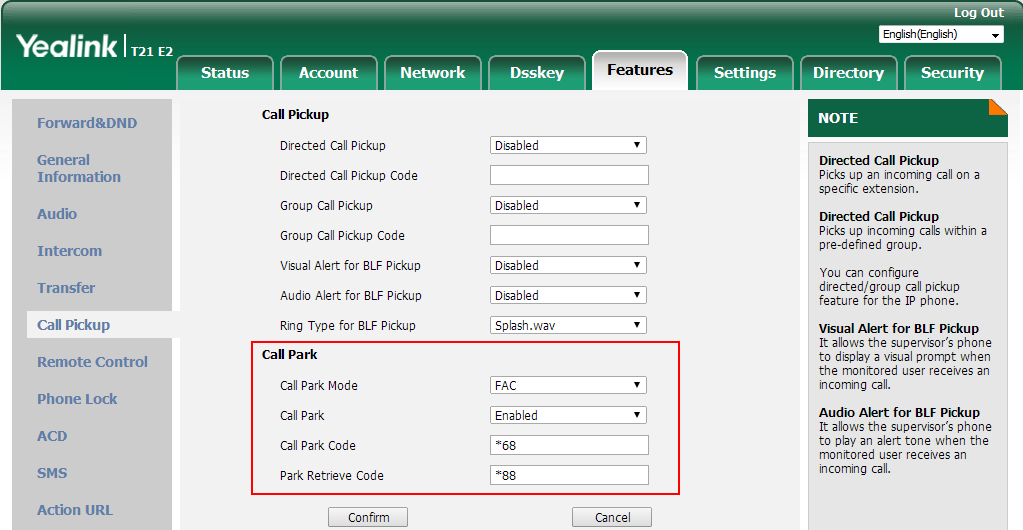

6. Click Confirm to accept the change.
If the
Park
or
Retrieve
soft key doesn
’
t appear on the LCD screen, please select
Disabled
from

the pull-down list of Custom Softkey via web user interface at path Settings->Softkey

Layout.


To park a call in FAC mode:

1. During a call, press the Park soft key (You may need to press the More soft key to see the
Park soft key) or the call park key (if configured).
-
If the call park code is not configured, you need to enter the call park code (e.g., *68).


Press , or the Park soft key.

-
If the call park code is configured, the phone will dial the configured call park code

shown as below:


| Page 123 |
Basic Call Features

2. Do one of the following:
a)
If you want to park the call against the local extension.

1)
Press .
If the call is parked successfully, you will hear a voice prompt confirming that the
call is parked.
b) If you want to park the call against desired extension.
1)
Enter an extension (e.g., 4606) where you want to park the call.

2)
Press or .

If the call is parked successfully, you will hear a voice prompt confirming that the
call is parked. The call is parked against the extension you entered.
To retrieve a parked call in FAC mode:
1.
Do one of the following:
-
If the park retrieve code is not configured, dial the park retrieve code (e.g., *88).
-
If the park retrieve code is configured, press the Retrieve soft key on the dialing
screen or retrieve park key (if configured) on the IP phone.
The phone will dial the configured park retrieve code and the Retrieve screen appears
as below:


2.
Follow the voice prompt, do one of the following:
-
Press on the phone where the call is parked.

-
Enter the desired extension followed by # (e.g., 4606#) on any phone.
Note
You can also press the desired BLF or BLF list key to park a call or retrieve a parked call directly.

For more information, refer to Parking a Call/Retrieving a Parked Call to the Monitored User on

page 138.


Transfer Mode

To configure call park feature in transfer mode via web user interface:

1.
Click on Features->Call Pickup.
2.
Select Transfer from the pull-down list of Call Park Mode.
3.
Select Enabled from the pull-down list of Call Park.
123
| Page 124 |
User Guide for the SIP

Note
124
-T21(P) E2 IP Phone
If Enabled is selected, the Park soft key will display on the LCD screen during a call, and
the Retrieve soft key will display on the dialing screen.
4.
(Optional.) Enter the call park code in the Call Park Code field.
It is configured for the Park soft key. This call park code will also apply to the call park key.
5.
(Optional.) Enter the park retrieve code in the Park Retrieve Code field.
It is configured for the Retrieve soft key. This park retrieve code will also apply to the call
park key.
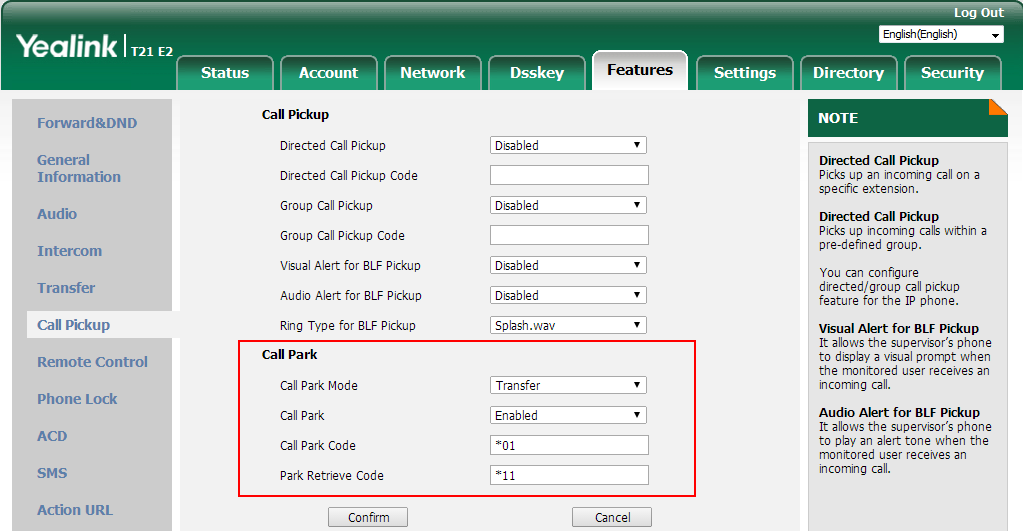

6.
Click Confirm to accept the change.
If the Park or Retrieve soft key doesn’t appear on the LCD screen, please select Disabled from

the pull-down list of Custom Softkey via web user interface at path Settings->Softkey

Layout.


To park a call in Transfer mode:

1. During a call, press the Park soft key (You may need to press the More soft key to see the
Park soft key) or the call park key (if configured).
-
If the call park code is not configured, you need to enter the call park code (e.g., *01).


Press , or the Park soft key. The call will be transferred to the shared

parking lot.

| Page 125 |
Call Pickup
Direct

Note
Note
Basic Call Features
-
If the call park code is configured, the call will be directly transferred to the shared
parking lot.
For some servers, the system
will return
a
specific park retrieve number (
park retrieve code)

from which the call can be retrieved after parking successfully.

To retrieve a parked call in Transfer mode:
1.
Do one of the following:
-
If the park retrieve code is not configured, dial the park retrieve code (e.g., *11).
-
If the park retrieve code is configured, press the Retrieve soft key on the dialing
screen or retrieve park key (if configured) on the IP phone.
The phone will retrieve the parked call from the shared parking lot.
You can use call pickup to answer someone else’s incoming call on your phone. The SIP-T21(P)
E2 IP phone supports directed call pickup and group call pickup. Directed call pickup is used for
picking up a call that is ringing at a target phone number. Group call pickup is used for picking
up a call that is ringing at any phone number in a certain group. The pickup group should be
predefined, contact your system administrator for more information.
You can pick up an incoming call by using the DPickup/GPickup soft key. To use call pickup,
you need to configure the call pickup code beforehand on a global or per-line basis via web
user interface.
If there are many incoming calls at the same time, pressing the GPickup soft key on the phone

will pick up the call that rings first.

ed Call Pickup
To enable directed call pickup and configure the directed call pickup code on a global
basis via web user interface:
1.
Click on Features->Call Pickup.
2.
Select Enabled from the pull-down list of Directed Call Pickup.
125
| Page 126 |
User Guide for the SIP
Pick up the handset, press the Speakerphone key or press the line key (You may need to

126
-T21(P) E2 IP Phone
3.
Enter the directed call pickup code in the Directed Call Pickup Code field.
4.
Click Confirm to accept the change.
To configure the directed call pickup code on a per-line basis via web user interface:
1.
Click on Account->Advanced.
2.
Select the desired account from the pull-down list of Account.
3.
Enter the directed call pickup code in the Directed Call Pickup Code field.
4.
Click Confirm to accept the change.
To pick up a call directly:
1.
press the More soft key to see the DPickup soft key).
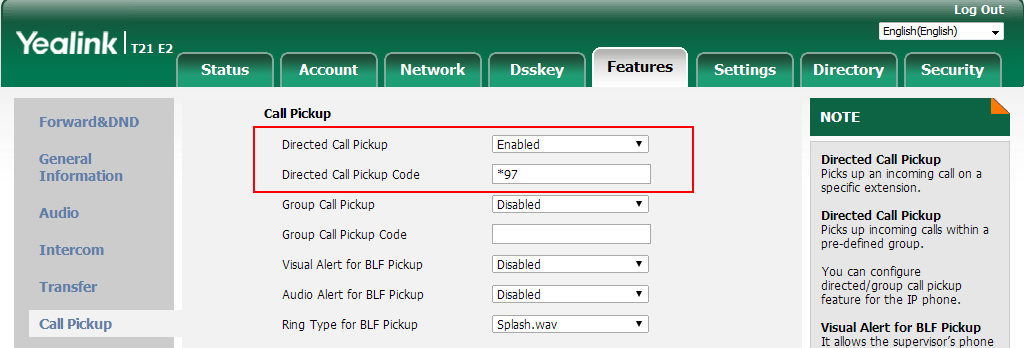

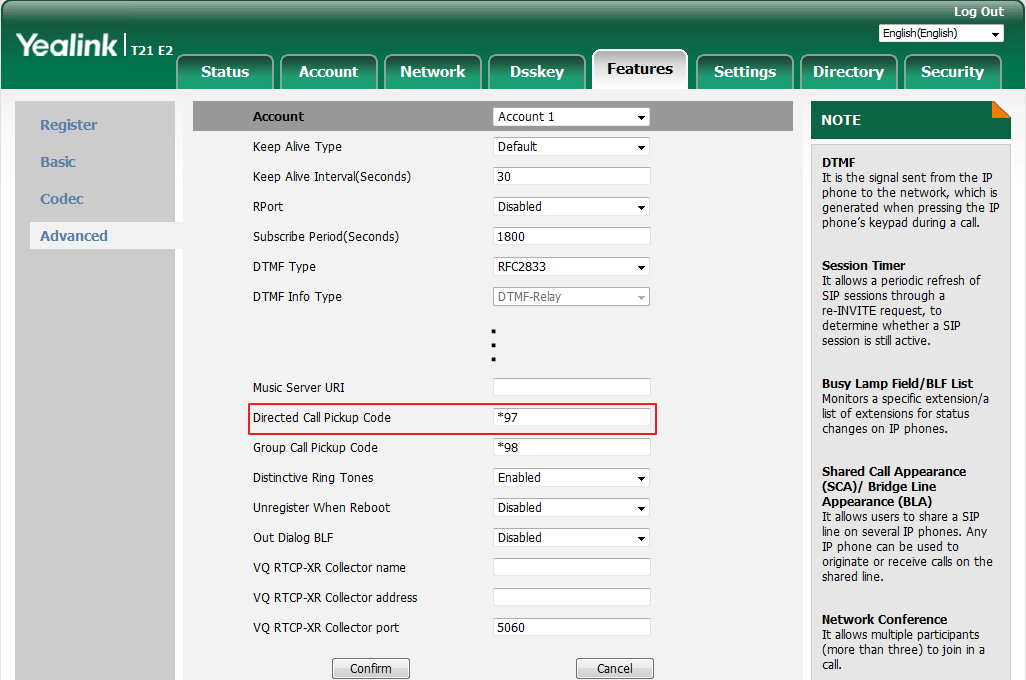

| Page 127 |
Basic Call Features

The DPickup soft key appears on the LCD screen.


2.
Press the DPickup soft key on your phone when the target phone receives an incoming
call.
3.
Enter the phone number which is receiving an incoming call.
4.
Press the DPickup soft key again.
The call is answered on your phone.
You can also configure a DSS key as a direct pickup key via phone user interface or web user
interface. Once configured, you can pick up a call by pressing the direct pickup key directly. For
more information, refer to DSS Keys on page 69.
Group Call Pickup
To enable group call pickup and configure the group call pickup code on a global basis via
web user interface:
1.
Click on Features->Call Pickup.
2.
Select Enabled from the pull-down list of Group Call Pickup.
3.
Enter the group call pickup code in the Group Call Pickup Code field.
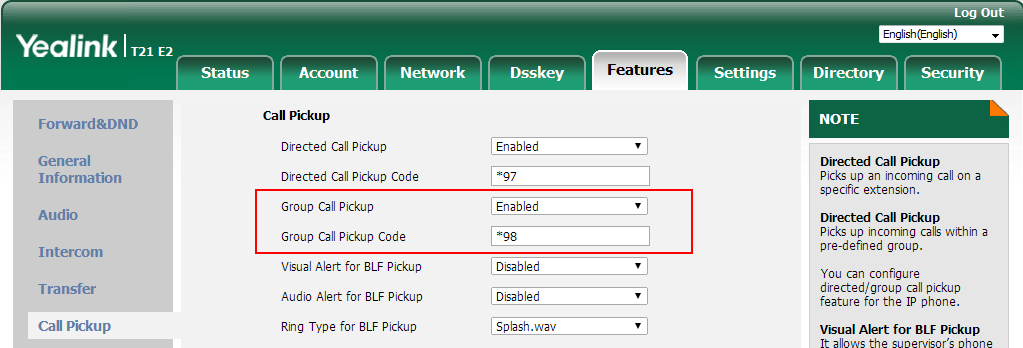

4.
Click Confirm to accept the change.
To configure the group call pickup code on a per-line basis via web user interface:
1.
Click on Account->Advanced.
2.
Select the desired account from the pull-down list of Account.
127
| Page 128 |
User Guide for the SIP

Note
128
-T21(P) E2 IP Phone
3.
Enter the group call pickup code in the Group Call Pickup Code field.
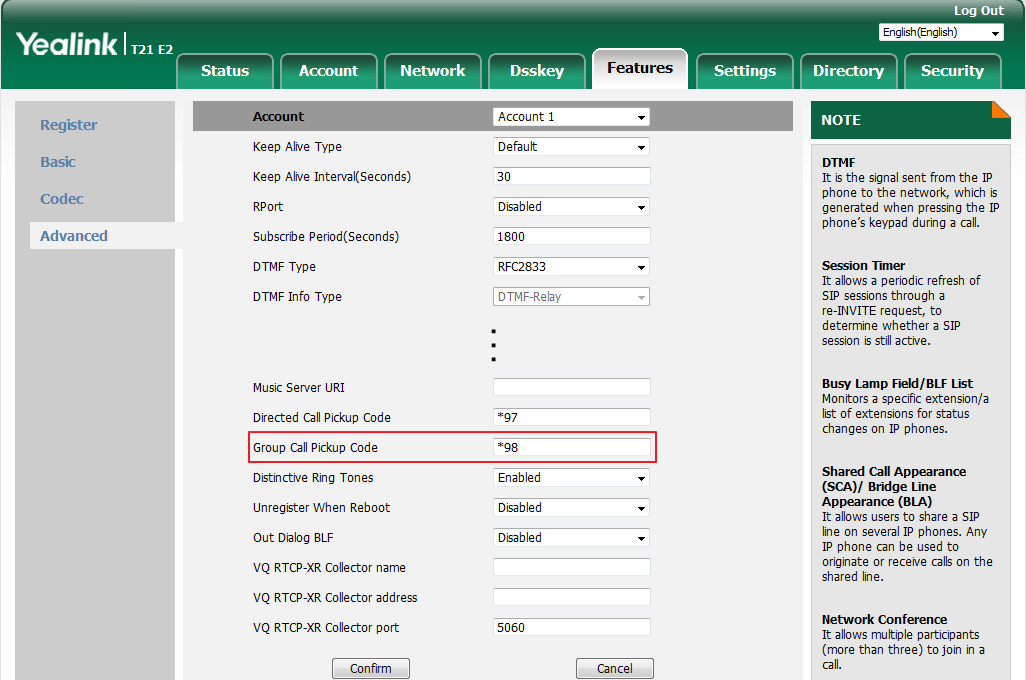

4.
Click Confirm to accept the change.
To pick up a call in the group:
1.
Pick up the handset, press the Speakerphone key or press the line key.
The GPickup soft key appears on the LCD screen.


2.
Press the GPickup soft key on your phone when a phone in the group receives an
incoming call.
The call is answered on your phone.
You can also configure a DSS key as group pickup key via phone user interface or web user
interface. Once configured, you can pick up a call by pressing the group pickup key directly. For
more information, refer to DSS Keys on page 69.
The directed call pickup code and group call pickup code are predefined on the system server.

Contact your system administrator for more information.
The call pickup code configured on a per-line basis takes precedence over that configured on a
global basis.

| Page 129 |
Basic Call Features

Anonymous Call
You can use anonymous call to block your identify and phone number from appearing to the
called party when you call someone. For example, you want to call to consult some services, but
don’t want to be harassed. Anonymous call is configurable on a per-line basis. You can also
configure the phone to send anonymous call on/off code to the server to activate/deactivate
anonymous call on the server side.
Note
Anonymous call is not available on all servers. Contact your system administrator for the

anonymous call on code and off code.

To configure anonymous call via phone user interface:
1.
Press Menu->Features->Anonymous Call.

2.
Press or , or the Switch soft key to select the desired line from the Line ID field.

3.
Press or , or the Switch soft key to select Enabled from the Local Anonymous

field.



4.
(Optional.) Press or , or the Switch soft key to select the desired value from the

Send Anony Code field.

The phone will send the configured on code or off code depending on your selection when
you enable or disable anonymous call feature on the phone.
5.
(Optional.) Enter the anonymous call on code in the On Code field.
6.
(Optional.) Enter the anonymous call off code in the Off Code field.
7.
Press the Save soft key to accept the change or the Back soft key to cancel.
Anonymous call is configurable via web user interface at the path Account->Basic.
To place an anonymous call:
1.
Using the specific line on the phone to place a call to phone B.
The LCD screen of phone B prompts an incoming call from anonymity.


129
| Page 130 |
User Guide for the SIP-T21(P) E2 IP Phone

Anonymous Call Rejection
You can use anonymous call rejection to reject incoming calls from anonymous callers.
Anonymous call rejection automatically rejects incoming calls from callers who deliberately
block their identities and numbers from being displayed. Anonymous call rejection is
configurable on a per-line basis. You can also configure the phone to send anonymous call
rejection on/off code to the server to activate/deactivate anonymous call rejection on the server
side.
To configure anonymous call rejection via phone user interface:
1.
Press Menu->Features->Anonymous Call.


2.
Press or , or the Switch soft key to select the desired line from the Line ID field.


3.
Press or to scroll to the Anony Rejection field.

4.
Press or , or the Switch soft key to select Enabled from the Anony Rejection

field.


5.
(Optional.) Press or , or the Switch soft key to select the desired value from the


Send Reject Code field.
The phone will send the configured on code or off code depending on your selection when
you enable or disable anonymous call rejection feature on the phone.
6.
(Optional.) Enter the anonymous call rejection on code in the On Code field.
7.
(Optional.) Enter the anonymous call rejection off code in the Off Code field.
8.
Press the Save soft key to accept the change or the Back soft key to cancel.
Anonymous call rejection is configurable via web user interface at the path Account->Basic.
130
| Page 131 |
Advanced Phone Features

Advanced Phone Features

This chapter provides operating instructions for the advanced features of the SIP-T21(P) E2 IP
phone. Topics include:
Busy Lamp Field (BLF)
BLF List
Call Recording
Hot Desking
Intercom
Multicast Paging
Music
on
Hold
(MoH)
Automatic Call Distribution (ACD)
Shared Call Appearance (SCA)
Bridge
d
Line Appearance (BLA)
Messages
If you require additional information or assistance with your new phone, contact your system
administrator.
Busy Lamp Field (BLF)
You can use BLF to monitor a specific line for status changes on the phone. For example, you
can configure a BLF key on the phone to monitor the status of a friend’s line (busy or idle). The
BLF key LED illuminates solid red when the friend's line is in use. For more information on BLF
key LED indicators, refer to LED Instructions on page 17.
Configuring the BLF Feature on the IP Phone
You need to configure the IP phone to perform BLF monitoring IP phones being monitored do
not require any configuration.
Configuring a BLF Key
To configure a BLF key via phone user interface:
1.
Press Menu->Features->DSS Keys.
2.
Select the desired DSS key.
131
| Page 132 |
User Guide for the SIP
Configuring

Note
132
-T21(P) E2 IP Phone

3.
Press or , or the Switch soft key to select BLF from the Type field.



4.
Press or , or the Switch soft key to select the desired line from the Account ID


field.
5.
(Optional.) Enter the string that will appear on the LCD screen in the Label field.
6.
Enter the phone number or extension you want to monitor in the Value field.
7.
(Optional.) Enter the directed call pickup code in the Extension field.
If it is configured, when the monitored user receives an incoming call, the supervisor can
press the BLF key to pick up the call directly.
8.
Press the Save soft key to accept the change or the Back soft key to cancel.
BLF key is configurable via web user interface at the path Dsskey->Line Key.
Visual and Audio Alert for BLF Pickup
You can enable visual alert feature for BLF pickup on the phone. This allows the LCD screen of
the monitoring phone to display the caller ID when the monitored line receives an incoming call.
You can also enable audio alert feature for BLF pickup on the phone. If audio alert feature for
BLF pickup is enabled, you can specify a desired ring tone to play when the monitored line
receives an incoming call.
To enable visual and audio alert features via web user interface:
1.
Click on Features->Call Pickup.
2.
Select Enabled from the pull-down list of Visual Alert for BLF Pickup.
3.
Select Enabled from the pull-down list of Audio Alert for BLF Pickup.
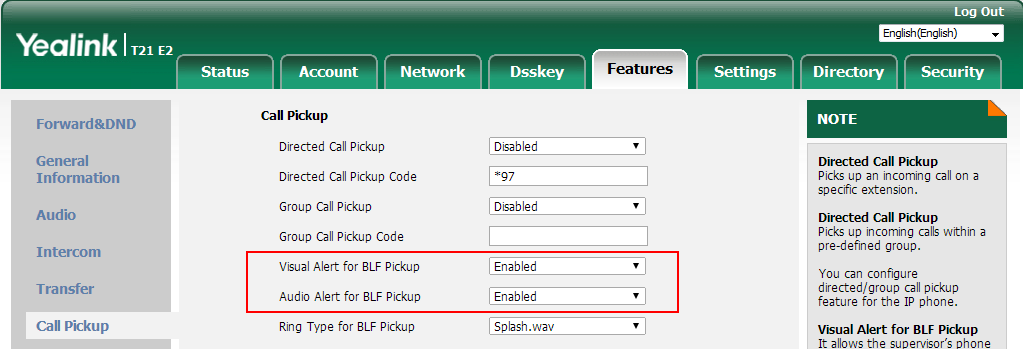

4.
Click Confirm to accept the change.


Visual and audio alert features are configurable via web user interface only.
| Page 133 |
Advanced Phone Features

To configure BLF ring type via phone user interface:
1.
Press Menu->Settings->Basic Settings->Sound->BLF Ring Type.

2.
Press or to select the desired ring tone.



3.
(Optional.) Press to adjust the ringer volume.

4.
Press the Save soft key to accept the change or the Back soft key to cancel.
BLF ring type is configurable via web user interface at the path Features->Call Pickup.
When the monitored line receives an incoming call, the following occurs on your phone:
The phone plays
a specific ring tone
(if enabled).
The BLF key LED flashes
red
.
The caller ID appears on the
LCD
screen (if enabled).
In the following figure, the LCD screen shows an incoming call from 1040 on the monitored line.


You can do the following actions:
-
Press
the
Pick
U
p
soft key to pick up the call.
-
Press
the
Send
soft key to dial out the monitored phone number.
-
Press
the
NewCall
soft key to place a new call.
-
Press
the
Cancel
soft key to exit the screen.
Note
If your phone is locked and the type of the
phone
lock is
configured as
Function Keys
or
All

Keys, you cannot use the Pick Up, Send, NewCall and Cancel soft keys until unlocked. For more
information, refer to Phone Lock on page 43.

Configuring Directed Call Pickup Code
If you configure the directed call pickup code in advance, you can pick up the monitored user’s
incoming call by pressing the BLF key. You can configure the directed call pickup code when
133
| Page 134 |
User Guide for the SIP

Note
134
-T21(P) E2 IP Phone
configuring a BLF key. For more information, refer to Configuring a BLF Key on page 131. You
can also configure the directed call pickup code on a global or per-line basis via web user
interface.
If you enable visual alert feature, you can also pick up the monitored user’s incoming call by
pressing DPickup soft key. To use DPickup soft key to pick up the call, the call pickup code can
only be configured on a global or per-line basis via web user interface.
The pickup code is used in the following order of preference: Extension (Dsskey->Line

Key)>Directed Call Pickup Code (Account->Advanced)>Directed Call Pickup Code
(Features->Call Pickup). If pickup code is not configured, pressing the BLF key/DPickup soft key
will directly call the monitored user when he/she receives an incoming call.

To configure the directed call pickup code on a global basis via web user interface:
1.
Click on Features->Call Pickup.
2.
Enter the desired pickup code in the Directed Call Pickup Code field.
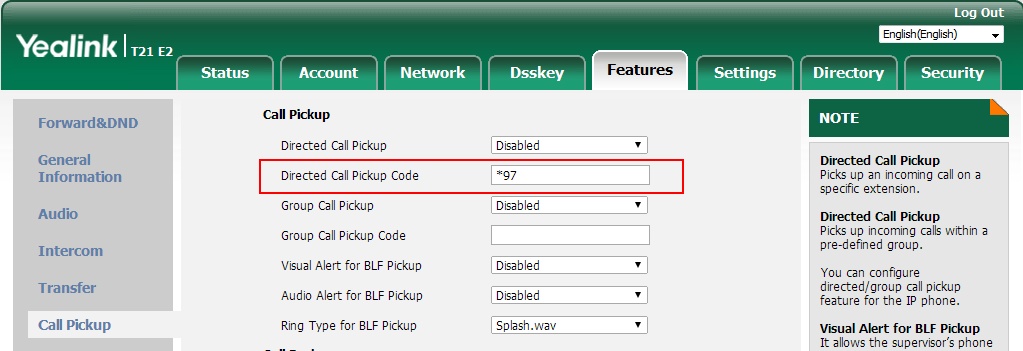

3.
Click Confirm to accept the change.
To configure the directed call pickup code on a per-line basis via web user interface:
1.
Click on Account->Advanced.
2.
Select the desired account from the pull-down list of Account.
| Page 135 |
Advanced Phone Features

3.
Enter the desired pickup code in the Directed Call Pickup Code field.
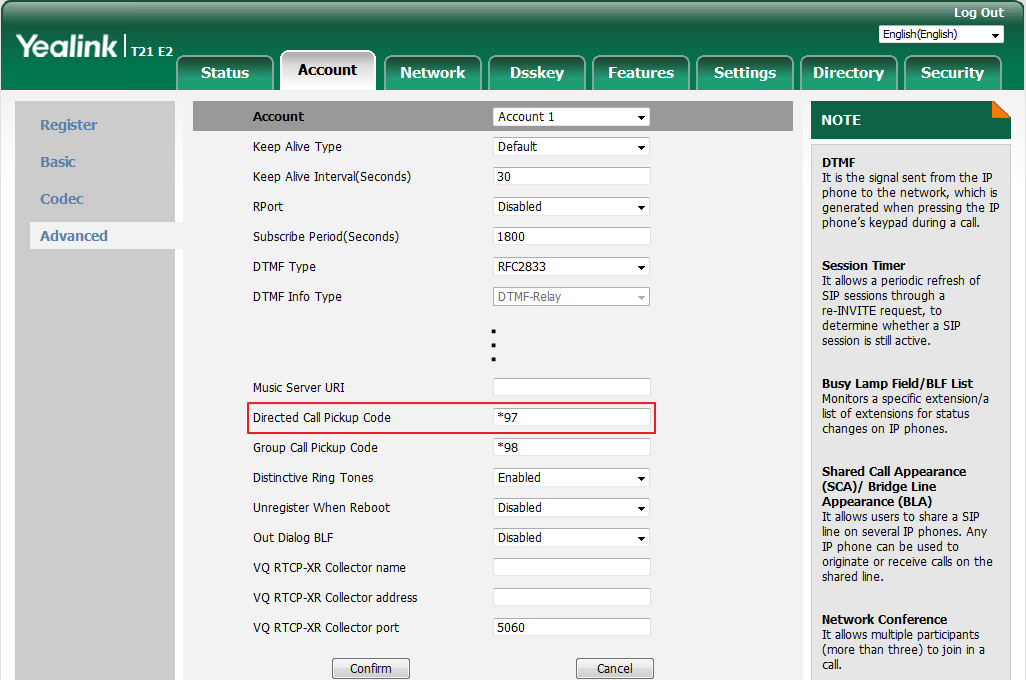

4.
Click Confirm to accept the change.
Configuring Transfer Mode on DSS Key
When there is an active call on the IP phone, you can handle the active call differently using a
BLF key. The phone behavior depends on the configuration of transfer mode via Dsskey with the
BLF key.
To configure the transfer mode on DSS key via web user interface:
1.
Click on Features->Transfer.
2.
Select the desired transfer mode from the pull-down list of Transfer Mode via Dsskey.
If you select
Blind Transfer
,
press
the BLF key to blind transfer the call to the
monitored user.
If you select
Attended
Transfer
,
press
the BLF key to dial out the monitored phone
number and then perform an attended or a semi-attended transfer.
If you select
New Call
,
press
the BLF key to place a new call to the monitored user.
135
| Page 136 |
User Guide for the SIP-T21(P) E2 IP Phone

The original call is placed on hold.
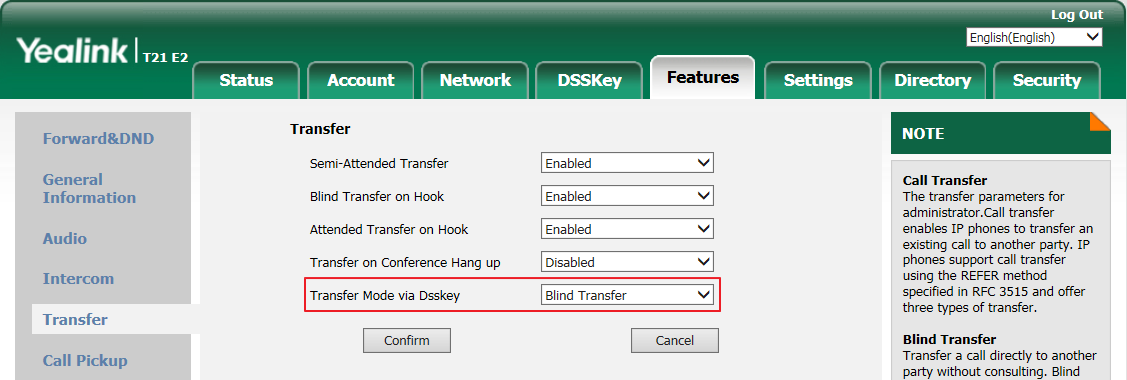

3.
Click Confirm to accept the change.
Note
Transfer Mode on DSS Key is also applicable to BLF list feature.


Using BLF Feature on the Phone
You can use the BLF key in the following ways:
Place a call to the monitored user.
Transfer a call to the monitored user.
Pick up an incoming call of the monitored user.
Placing a Call to the Monitored User
You can press a BLF key to dial out the monitored phone number when the monitored line is
idle.
To place a call to the monitored user when the IP phone is idle:
1.
Press the BLF key.
The IP phone dials out the phone number of the monitored user.
Transferring a Call to the Monitored User
When there is already an active call on the IP phone, you can transfer the active call to the
monitored user by pressing the BLF key. The phone handles the active call differently depending
on the configuration of transfer mode via Dsskey with the BLF key (refer to Configuring Transfer
Mode on DSS Key). The transfer mode on DSS key has the following modes:
Blind Transfer
Attended Transfer
New Call
When the transfer mode on DSS key is set to Blind Transfer and there is already an active call
on the IP phone, you can do the following:
136
| Page 137 |
Advanced Phone Features

To perform a blind transfer:
1.
Press the BLF key of the monitored user which you want to transfer this call to.
Then the active call is connected to the number of the monitored user.
When the transfer mode on DSS key is set to Attended Transfer and there is already an active
call on the IP phone, you can do the following:
To perform a semi-attended transfer:
1.
Press the BLF key of the monitored user which you want to transfer this call to. The phone
will dial the number of the monitored user.
2.
Press the BLF key of the monitored user again or the Trans soft key to complete the
transfer when receiving ringback.
To perform an attended transfer:
1.
Press the BLF key of the monitored user which you want to transfer this call to. The phone
will dial the number of the monitored user.
2.
Press the BLF key of the monitored user again or the Trans soft key to complete the
transfer after the monitored user answers the call.
When the transfer mode on DSS key is set to New Call and there is already an active call on the
IP phone, you can do the following:
To perform a new call:
1.
Press the BLF key of the monitored user you want to call.
The phone will dial the number of the monitored user. The original call is placed on hold.
Picking up an Incoming Call of the Monitored User
When the monitored user receives an incoming call, the BLF key indicator of the monitored user
will flash red. You can use the BLF key to pick up an incoming call of the monitored user. If you
enable visual alert feature on the phone, you can pick up the incoming call using the DPickup
soft key. Before picking up an incoming call, ensure that the directed call pickup code has been
configured in advance.
To pick up an incoming call using the BLF key or the DPickup soft key:
1.
Press the BLF key or the DPickup soft key.
The incoming call of the monitored user is answered on the IP phone.
Note
If the directed call pickup code is not configured, the phone will place a call to the monitored

user instead of picking up an incoming call of the monitored user when you press the BLF key
or the DPickup soft key.

137
| Page 138 |
User Guide for the SIP
arking a Call/
BLF List

P
Note
138
-T21(P) E2 IP Phone
Retrieving a Parked Call to the Monitored User
You can press the desired BLF key to park a call or retrieve a parked call directly in FAC mode. It
should be pre-configured by your system administrator.
To park a call in FAC mode:
1.
During a call, press the Park soft key (You may need to press the More soft key to see the
Park soft key).
2.
Press the desired BLF key to park the call to the monitored user.
To retrieve a parked call in FAC mode:
1.
Press the Retrieve soft key on the dialing screen.
2.
Press the desired BLF key to retrieve a call that is parked to the monitored user.
Make sure that the call park code/park retrieve code is configured via web user interface at the

path: Feature->Call Pickup. For more information, refer to FAC Mode on page 121.

You can use the BLF List feature to monitor a list of users defined by your system administrator.
For example, your system administrator enables BLF List, and creates a BLF List URI (e.g.,
BLFList@example.com) including a list of user1, user2 on the server. The BLF List keys on the IP
phone can present the status of user1 and user2. The key LEDs illuminate either flashing or solid
depending on the status of those users. For more BLF List key LED indicators, refer to LED
Instructions on page 17.
You can use the BLF List keys in the following ways:
When the monitored user is idle, press
the BLF list key to dial out the phone number.
When there is already an active call on the IP phone, you can transfer the active call to the
monitored user by pressing the BLF List key. The phone handles the active call differently
depending on the configuration of transfer mode via Dsskey. For more information on the
transfer mode on DSS key, refer to Configuring Transfer Mode on DSS Key on page 133.
When the monitored user receives an incoming call, press the BLF list key to pick up the
call directly. Before picking up an incoming call, ensure that the BLF List Pickup Code has
been configured in advance. If the code is not configured, the phone will place a call to the
monitored user instead of picking up the incoming call of the monitored user when you
press the BLF List key.
When there is a conversation
on the monitored user, press the BLF list key to barge in and
set up a conference call. Before barging in an active call, ensure that the BLF List Barge In
Code has been configured in advance. If the code is not configured, the phone will place a
call to the monitored user instead of barging in an active call of the monitored user when
you press the BLF List key.
| Page 139 |
Advanced Phone Features

When a call is being parked against the monitored phone, press the BLF List key to
retrieve
the parked call from the monitored user. Before retrieving the parked call, ensure that the
BLF List Retrieve Call Parked Code has been configured in advance. If the code is not
configured, the phone will place a call to the monitored user instead of retrieving the
parked call when you press the BLF List key.
To configure BLF List settings via web user interface:
1.
Click on Account->Advanced.
2.
Select the desired account from the pull-down list of Account.
3.
Enter the BLF List URI in the BLF List URI field.
4.
(Optional.) Enter the directed call pickup code in the BLF List Pickup Code field.
5.
(Optional.) Enter the barge-in code in the BLF List Barge In Code field.
6.
(Optional.) Enter the park retrieve code in the BLF List Retrieve Call Parked Code field.
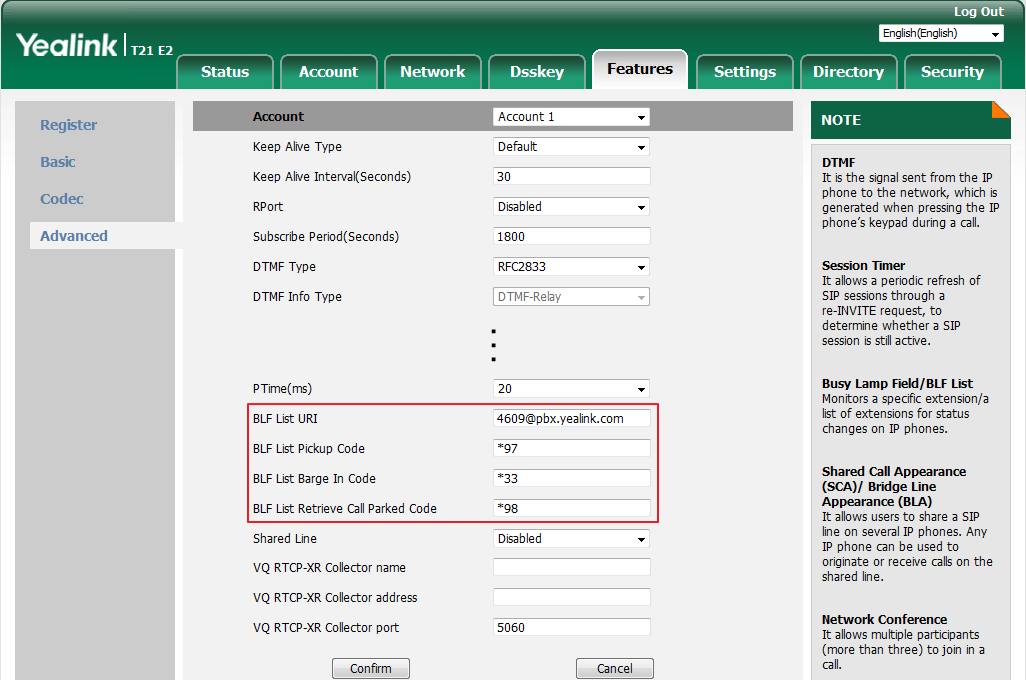

7.
Click Confirm to accept the change.
Note
For more information on BLF List URI/BLF List Pickup Code/BLF List Barge In Code/BLF List

Retrieve Call Parked Code, contact your system administrator.

According to the response message from the server, the IP phone will automatically configure
the BLF List keys beginning from the first unused Line key. Once any Line key is seized, the IP
phone will skip to configure the next Line key.
139
| Page 140 |
User Guide for the SIP
Call Recording
Configuring a Record Ke

Note
Note
140
-T21(P) E2 IP Phone
You can receive a visual or/and an audio alert (if enabled) on your phone when the monitored
user receives an incoming call. For more information, refer to Configuring Visual and Audio Alert
for BLF Pickup on page 132.
The pickup code is used in the following order of preference:

BLF List Pickup Code (Account->Advanced)>Directed Call Pickup Code
(Account->Advanced)>Directed Call Pickup Code (Features->Call Pickup). If all of them are not
configured, pressing the BLF List key will directly call the monitored user when he/she receives an
incoming call. For more information about pickup code, refer to Call Pickup on page 125.

You can record calls by pressing a record key on the phone. The SIP-T21(P) E2 IP phone
supports record and URL record.
Two ways of call recording:
Record
:
T
he phone sends SIP INFO message containing a specific header
“Record: on/off”
to trigger a recording.
URL Record
:
T
he phone sends HTTP URL request to trigger
a
recording. Contact your
system administrator for the predefined URL.
Server recording is not available on all servers. Contact your system administrator for more

information.

The Record and URL Record keys control the recording function, and are available:

During an active call
When calls are on hold or mute
During a blind or attended transfer
During a conference call
When the phone prompts you to answer an incoming call
The Record and URL Record keys are not available when:
There are no
connected calls on your phone
You place a new call
y
To configure a record key via phone user interface:
1.
Press Menu->Features->DSS Keys.
2.
Select the desired DSS key.
| Page 141 |
Advanced Phone Features
and
key LED

3.
Press or , or the Switch soft key to select Key Event from the Type field.

4.
Press or , or the Switch soft key to select Record from the Key Type field.




5.
(Optional.) Enter the string that will appear on the LCD screen in the Label field.

6.
Press the Save soft key to accept the change or the Back soft key to cancel.
Record key is configurable via web user interface at the path Dsskey->Line Key.
Configuring a URL Record Key
To configure a URL record key via phone user interface:
1.
Press Menu->Features->DSS Keys.
2.
Select the desired DSS key.

3.
Press or , or the Switch soft key to select URL Record from the Type field.



4.
(Optional.) Enter the string that will appear on the LCD screen in the Label field.
5.
Enter the URL (e.g., http://10.1.2.224/phonerecording.cgi) in the Value field.
6.
Press the Save soft key to accept the change or the Back soft key to cancel.
URL record key is configurable via web user interface at the path Dsskey->Line Key.
Recording a Call
To record a call:
1.
Press the Record or URL Record key during a call.
If the recording starts successfully, the recording icon will appear on the LCD screen
the Record or URL Record key LED will flash green.
2.
Press the Record or URL Record key again to stop recording.
The recording icon disappears from the LCD screen and the Record or URL Record
goes out.
141
| Page 142 |
User Guide for the SIP
Hot Desking

Note
Note
142
-T21(P) E2 IP Phone
Recording status indicators you need to know:


Circumstance
Icons on the LCD screen



A recording is started
appears on the LCD screen


A recording cannot be started
appears for 1 second



A recording cannot be stopped
appears for 1 second, then goes back


The recording box is full
appears for 1 second


The call cannot be recorded
appears for 1 second



You can listen to the recordings stored on your server system. For example, you can dial an

access code to listen to the recordings.

The way in which you listen to the recordings may be different depending on the server. Contact

your system administrator for more information.



Hot desking originates from the definition of being the temporary physical occupant of a work

station or surface by a particular employee. A primary motivation for hot desking is cost

reduction. This feature is regularly used in places where not all the employees are in the office at


the same time, or not in the office for very long, which means that actual personal offices would

be often vacant, consuming valuable space and resources.

You can use hot desking on the SIP-T21(P) E2 IP phone to log out of the existing accounts and

then log into a new account. As a result, many users can share the phone resource at different

times. To use this feature, you need to configure a hot desking key in advance.

Hot desking is not available on all servers. Contact your system administrator for more

information.

To configure a hot desking key via phone user interface:


1.
Press Menu->Features->DSS Keys.

2.
Select the desired DSS key.

3.
Press or , or the Switch soft key to select Key Event from the Type field.

4.
Press or , or the Switch soft key to select Hot Desking from the Key Type field.











































| Page 143 |
Advanced Phone Features

5.
(Optional.) Enter the string that will appear on the LCD screen in the Label field.
6.
Press the Save soft key to accept the change or the Back soft key to cancel.
Hot desking key is configurable via web user interface at the path Dsskey->Line Key.
To use hot desking:
1.
Press the hot desking key when the phone is idle.
The LCD screen prompts the following warning:


2.
Press the OK soft key, registration configurations of all accounts on the phone will be
cleared immediately.
The login wizard will be displayed as below:


3.
Enter the login information in each field.
4.
Press the Save soft key to login or the Cancel soft key to cancel.
Intercom
Intercom is a useful feature in an office environment to quickly connect with the operator or the
secretary. You can press the intercom key to automatically connect with a preconfigured target
extension for outgoing intercom calls, and the target extension will automatically answer
incoming intercom calls by default. You can also use intercom key to monitor a specific line for
status changes on the phone.
Note
I
ntercom is
not
available
on
all
servers
.
Contact your system administrator for more information.


143
| Page 144 |
User Guide for the SIP
Configuring the
Configuring a
Incom

144
-T21(P) E2 IP Phone
Intercom Feature on the IP Phone
n Intercom Key
To configure an intercom key via phone user interface:
1. Press Menu->Features->DSS Keys.
2. Select the desired DSS key.

3. Press or , or the Switch soft key to select Intercom from the Type field.



4. Select the desired line from the Account ID field.
5. (Optional.) Enter the string that will appear on the LCD screen in the Label field.
6. Enter the target extension number in the Value field.
7. (Optional.) Enter the directed call pickup code in the Extension field.
If it is configured, when the target extension receives an incoming call, the supervisor can
press the intercom key to pick up the call directly. Contact your system administrator for
more information.
8. Press the Save soft key to accept the change or the Back soft key to cancel.
Intercom key is configurable via web user interface at the path Dsskey->Line Key.
ing Intercom Calls
The SIP-T21(P) E2 IP phone supports automatically to answer an incoming intercom call by
default. The phone automatically plays a warning tone when it receives an incoming intercom
call. In addition, you can enable the phone to mute the microphone when it automatically
answers an incoming intercom call. You can also enable the phone to automatically answer an
incoming intercom call while there is already an active call on the phone. The active call is then
placed on hold.
Intercom features you need to know:


Intercom Feature
Description



Intercom Allow
E
intercom call.
nable or disable the IP phone to
answer an incoming


Intercom Mute
E
calls.
nable or disable the IP phone
’s
microphone for
i
ntercom












































Intercom Tone
Enable or disable the IP phone to play a warning tone
| Page 145 |
Advanced Phone Features

Intercom Feature
Description


when it receives an incoming intercom call.



Enable or disable the IP phone to automatically answer an


Intercom Barge
incoming intercom call while there is already an active call



on the phone.


Intercom Allow


You can enable or disable the phone to answer an incoming intercom call. If Intercom Allow is



enabled, the phone will automatically answer an incoming intercom call. If Intercom Allow is

disabled, the phone will handle an incoming intercom call like a normal call instead of directly

rejecting it. Intercom Allow is enabled by default.

Note
Your administrator can set a period of delay time before the phone automatically answers

intercom calls. Contact your system administrator for more information.

Intercom Mute

You can mute or un-mute the phone’s microphone for intercom calls automatically. If Intercom

Mute is enabled, the microphone will be muted for intercom calls. If Intercom Mute is disabled,

the microphone will work for intercom calls. Intercom Mute is disabled by default.

Intercom Tone

You can enable or disable the phone to play a warning tone when receiving an intercom call. If

Intercom Tone is enabled, the phone will play a warning tone before answering the intercom call.

If Intercom Tone is disabled, the phone will automatically answer the intercom call without

warning. Intercom Tone is enabled by default.

Intercom Barge

You can enable or disable the phone to automatically answer an incoming intercom call while

there is already an active call on the phone. If Intercom Barge is enabled, the phone will

automatically answer the intercom call and place the active call on hold. If Intercom Barge is


disabled, the phone will handle an incoming intercom call like a waiting call. Intercom Barge is


disabled by default.

Note
To enable the phone to receive a new incoming call when it has an active call, make sure that call

waiting feature is enabled on the phone in advance. For more information, refer to Call Waiting

on page 116.






145
| Page 146 |
User Guide for the SIP-T21(P) E2 IP Phone

To configure intercom features via phone user interface:
1. Press Menu->Features->Intercom.
2. Make the desired changes.


3. Press the Save soft key to accept the change or the Back soft key to cancel.
Intercom features are configurable via web user interface at the path Features->Intercom.
Using Intercom
You can use the intercom key in the following ways:
Place a call to the target extension
Pick up an incoming call of the
target extension
Note
To use the intercom key to pick up an incoming call, make sure the intercom subscription feature

is enabled. For more information, contact your system administrator.

Placing an Intercom Call to the Target Extension
To place an intercom call when the target phone is idle:
1. Press the intercom key.
The target extension plays a warning tone and automatically answers the call in the
hands-free (speakerphone) mode by default.
Picking up an Incoming Call of the Target Extension
When the target extension receives an incoming call, the intercom key LED of the target
extension will flash green. If you configure the directed call pickup code in advance, you can pick
up the target extension’s incoming call by pressing the intercom key. You can configure the
directed call pickup code when configuring an intercom key. For more information, refer to
Configuring an Intercom Key on page 144.
146
| Page 147 |
Advanced Phone Features

To pick up an incoming call when the monitored phone is ringing:
1.
Press the intercom key.
The incoming call of the target extension is answered on the IP phone.
Note
If the directed call pickup code is not configured, the phone will place a call to the target

extension instead of picking up an incoming call of the target extension when you press the
intercom key.

Multicast Paging
You can use multicast paging to quickly and easily broadcast time sensitive announcements to
users who are listening to a specific multicast group and a specific channel. You can configure
the paging list key on the phone, which allows you to send a Real Time Transport Protocol (RTP)
stream to the pre-configured multicast address(es) and channel(s) without involving SIP
signaling. You can configure the phone to receive an RTP stream from pre-configured multicast
listening address(es) and channel(s) without involving SIP signaling. You can specify up to 31
multicast listening addresses and channels.
The following describes 31 paging channels:
0
: You can broadcast audio to channel 0. Note that the Yealink IP phones running old
firmware version (old paging mechanism) can be regarded as listening to channel 0. It is
the default channel.
1 to 25
: You can broadcast audio to a specific channel. We recommend that you specify
these channels when broadcasting with Polycom IP phones which have 25 channels you
can listen to.
26 to 30
:
You can broadcast audio to a specific channel. We recommend that you specify
these channels when broadcasting with Yealink IP phones running new firmware version
(new paging mechanism).
The IP phones will automatically ignore all incoming multicast paging calls on the different
channel.
Sending RTP Stream
To configure a multicast paging key via phone user interface:
1. Press Menu->Features->DSS Keys.
2. Select the desired DSS key.


3. Press or , or the Switch soft key to select Key Event from the Type field.
147
| Page 148 |
User Guide for the SIP-T21(P) E2 IP Phone

4. Press or , or the Switch soft key to select Multicast Paging from the Key Type

field.



5. (Optional.) Enter the string that will appear on the LCD screen in the Label field.
6. Enter the multicast IP address and port number (e.g., 224.5.6.20:10008) in the Value field.
The valid multicast IP addresses range from 224.0.0.0 to 239.255.255.255.
7. Enter the desired channel in the Channel field.
The valid channel ranges from 0 to 30.
8. Press the Save soft key to accept the change or the Back soft key to cancel.
Multicast paging key is configurable via web user interface at the path Dsskey->Line Key.
To configure a paging list key via phone user interface:
1.
Press Menu->Features->DSS Keys.
2.
Select the desired DSS key.

3.
Press or , or the Switch soft key to select Key Event from the Type field.

4.
Press or , or the Switch soft key to select Paging List from the Key Type field.




5.
(Optional.) Enter the string that will appear on the LCD screen in the Label field.
6.
Press the Save soft key to accept the change or the Back soft key to cancel.
Paging list key is configurable via web user interface at the path Dsskey->Line Key.
To configure paging list via phone user interface:
1.
Press the paging list key when the phone is idle.
If the paging list key is not configured, you can also press Menu->Features->Paging List
to configure the paging list.

2.
Press or to select a desired paging group.

148
| Page 149 |
Advanced Phone Features
Address
use a default codec for sending multicast RTP stream via

The default tag is Empty if it is not configured before.


3.
Press the Option soft key and then press the Edit soft key.
4.
Enter the multicast IP address and port number (e.g., 224.5.6.20:10008) in the
field.
The valid multicast IP addresses range from 224.0.0.0 to 239.255.255.255.


5.
Enter the group name in the Label field.
6.
Enter the desired channel in the Channel field.
The valid channel ranges from 0 to 30.
7.
Press the Save soft key to accept the change.
8.
Repeat steps 2 to 7, you can add more paging groups.
Paging list is configurable via web user interface at the path Directory->Multicast IP.
To delete a paging group via phone user interface:
1.
Press the paging list key when the phone is idle.

2.
Press or to select a desired paging group.

3.
Press the Option soft key and then select Delete.
The LCD screen prompts “Delete selected paging group?”.


4.
Press the OK soft key to accept the change or the Cancel soft key to cancel.
If you want to delete all paging groups, you can press the Del All soft key.
You can also configure the phone to
149
| Page 150 |
User Guide for the SIP
Receiving RTP Stream

Note
Note
150
-T21(P) E2 IP Phone
web user interface.
To configure a default codec for multicast paging via web user interface:
1. Click on Features->General Information.
2. Select the desired codec from the pull-down list of Multicast Codec.
The default codec is G722.
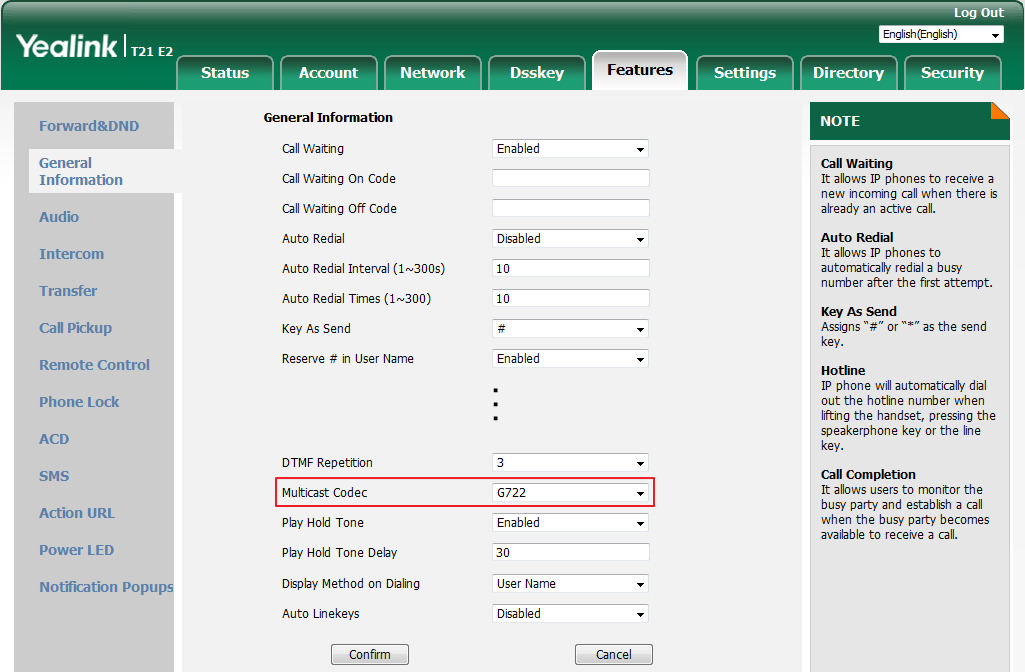

3. Click Confirm to accept the change.

If G722 codec is used for multicast paging, the LCD screen will display the icon to indicate

that it is providing high definition voice.
Default codec for multicast paging is configurable via web user interface only.

You can configure the phone to receive a Real Time Transport Protocol (RTP) stream from the
pre-configured multicast address(es) and channel(s) without involving SIP signaling. You can
specify up to 31 multicast addresses and channels that the phone listens to on the network.
RTP stream is listened in the hands-free (speakerphone) mode by default. If you want to listen the

RTP stream using the engaged audio device (speakerphone, handset or headset), contact your
system administrator for more information.
Fixed volume to play RTP stream for specified paging group is configurable by your system

administrator.
| Page 151 |
Advanced Phone Features

How the phone handles incoming multicast paging calls depends on Paging Barge, Ignore DND
and Paging Priority Active parameters configured via web user interface.
Paging Barge
The paging barge parameter defines the priority of the voice call in progress. If the priority of an
incoming multicast paging call is lower than that of the active call, it will be ignored
automatically. Valid values in the Paging Barge field:
1 to
31
: Define the priority of the active call, 1 with
the highest priority, 31
with the lowest.
Disabled
: The voice call in progress will take precedence
over all incoming paging calls.
Ignore DND
The ignore DND parameter defines the lowest priority of multicast listening address from which
the phone can receive an RTP stream when DND is activated. If a priority is selected from the
pull-down list of Ignore DND, the phone will ignore incoming multicast paging calls with lower
priorities when DND is activated in phone mode.. Valid values in the Ignore DND field:
1 to 31
:
Define the lowest priority of the multicast listening address from which the phone
can receive an RTP stream, 1 with the highest priority, 31 with the lowest.
Disabled
: All the incoming multicast paging
calls will be ignored when DND
is activated
in
phone mode.
The phone will automatically answer all incoming multicast paging calls when DND is activated
in custom mode.
Paging Priority Active
The paging priority active parameter decides how the phone handles incoming multicast paging
calls when there is already a multicast paging call on the phone. If enabled, the phone will
ignore incoming multicast paging calls with lower priorities, otherwise, the phone will answer
incoming multicast paging calls automatically and place the previous multicast paging call on
hold. If disabled, the phone will automatically ignore all incoming multicast paging calls.
To configure multicast listening addresses via web user interface:
1. Click on Directory->Multicast IP.
2. Select the desired value from the pull-down list of Paging Barge.
3. Select the desired value from the pull-down list of Ignore DND.
4. Select the desired value from the pull-down list of Paging Priority Active.
5. Enter the multicast IP address(es) and port number (e.g., 224.5.6.20:10008) which the phone
listens to for incoming RTP multicast in the Listening Address field.
6. (Optional.) Enter the label in the Label field.
Label will appear on the LCD screen when receiving the multicast RTP stream.
7. Select the desired channel to listen from the pull-down list of Channel.
151
| Page 152 |
User Guide for the SIP
Using

Note
152
-T21(P) E2 IP Phone
The default channel is 0.
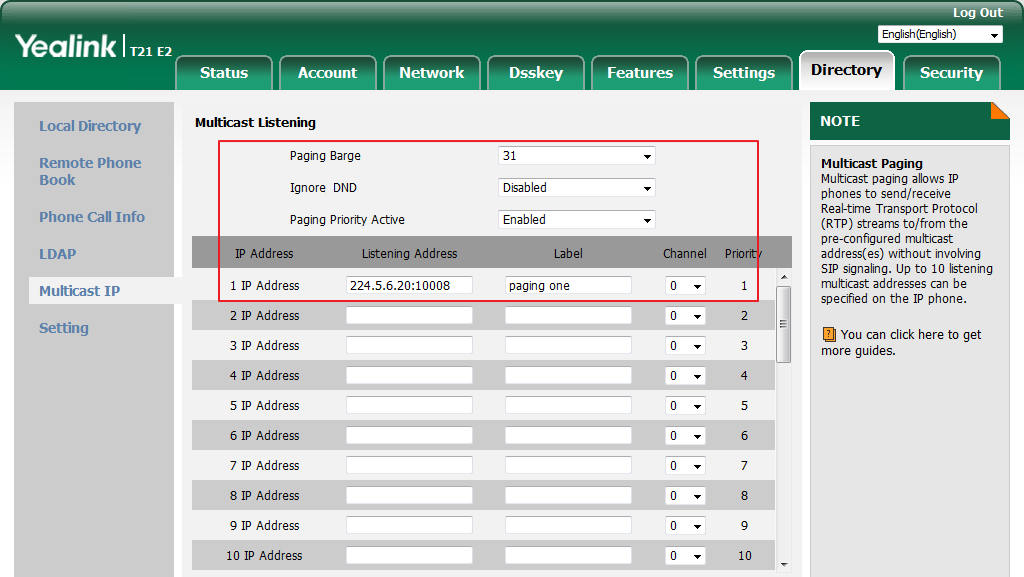

8. Click Confirm to accept the change.
The priorities of listening addresses are predefined: 1 with the highest priority, 31 with the lowest.

Multicast listening addresses are configurable via web user interface only.

Multicast Paging
To send RTP stream via a multicast paging key when the receiver’s phone is idle:
1. Press the multicast paging key when the phone is idle.
The phone sends RTP to a preconfigured multicast address (IP: Port).
Both the sender’s and receiver’s phones play a warning tone and the receiver automatically
answers the multicast RTP session in the hands-free (speakerphone) mode.
The multicast paging key LED illuminates solid green.
The following figure shows a multicast RTP session on the phone:


2. You can do the following:
To place the current multicast RTP session on hold, press the
Hold
soft key.
The sender’s phone places the multicast RTP session on hold and receiver’s phone
releases the session.
| Page 153 |
Advanced Phone Features

To resume the held multicast RTP session, press the Resume soft key.
The multicast RTP session is established again.
To end the multicast RTP session, press the
EndCall
soft key.
Note
Multicast RTP is one way only from the sender to the multicast address(es) (receiver). For

outgoing RTP multicasts, all other existing calls on the phone will be placed on hold.

To send RTP stream via a paging key list when the receiver’s phone is idle:
1.
Press the paging list key when the phone is idle.


2.
Press or to select the desired paging group.


3.
Press or the Paging soft key to send RTP.

4.
Your can do the following:
To place the current multicast RTP session on hold, press the
Hold
soft key.
The sender’s phone places the multicast RTP session on hold and receiver’s phone
releases the session.
To resume the held multicast RTP session, press the Resume soft key.
The multicast RTP session is established again.
To end the multicast RTP session, press the
EndCall
soft key.
Music on Hold (MoH)
Music on hold (MoH) is the business practice of playing recorded music to fill the silence that
would be heard by the party placed on hold. To use this feature, you should specify a SIP URI
pointing to a Music on Hold Server account. When a call is placed on hold, the phone will send a
SIP INVITE message to the Music on Hold Server account. The Music on Hold Server account
automatically answers the SIP INVITE messages and immediately plays audio from some source
located anywhere (LAN, Internet) to the held party. Contact your system administrator for the
SIP URI.
Note
If your server supports the MOH feature, you can also upload the custom music file into it

directly. For more information, contact your service provider.

153
| Page 154 |
User Guide for the SIP
Automatic Call Distribution (ACD)

Note
Note
154
-T21(P) E2 IP Phone
To configure music on hold server via web user interface:
1.
Click on Account->Advanced.
2.
Select the desired account from the pull-down list of Account.
3.
Enter the SIP URI (e.g., sip:moh@sip.com) in the Music Server URI field.
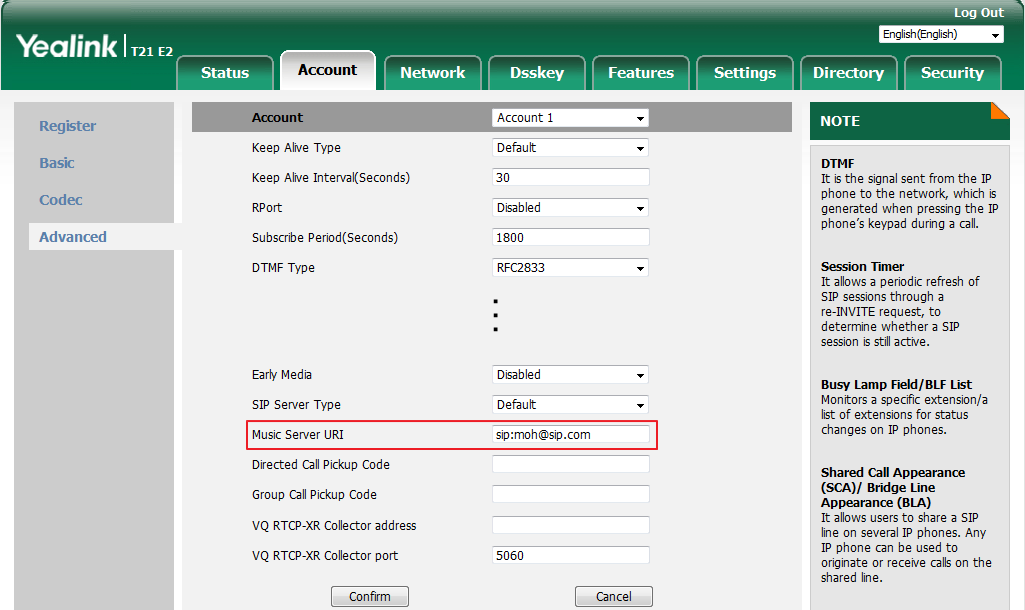

4.
Click Confirm to accept the change.
When you have placed a call on hold, the held party can hear the music.
For this feature to function, all involved parties cannot use encrypted RTP (SRTP).

Music on hold server is configurable via web user interface only.

ACD is often used in offices for customer service, such as call center. The ACD system handles
large volumes of incoming calls from callers who have no need to talk to a specific person but
who require assistance from any of multiple persons at the earliest opportunity. ACD on the
SIP-T21(P) E2 IP phone allows the ACD system to distribute large volumes of incoming calls to
the registered ACD users. To use this feature, you should configure an ACD key in advance.
Make sure ACD is enabled on your IP phone. For more information on enabling ACD, contact your

system administrator.

To configure an ACD key via phone user interface:
1.
Press Menu->Features->DSS Keys.
2.
Select the desired DSS key.
| Page 155 |
Advanced Phone Features

3.
Press or , or the Switch soft key to select ACD from the Type field.




4.
(Optional.) Enter the string that will appear on the LCD screen in the Label field.
5.
Press the Save soft key to accept the change or the Back soft key to cancel.
ACD key is configurable via web user interface at the path Dsskey->Line Key.
To log into the ACD system:
1.
Press the ACD key when the phone is idle.
The LCD screen prompts you the following information:
User ID: the identity used to log into the queue.
Password: the password used to log into the queue.


2.
Press the Login soft key to log in.
Note
Contact your system administrator for the User ID and Password to access the ACD system.


After configuring an ACD key, you can press the ACD key to log into the ACD system. After
logging in, you are ready to receive calls from the ACD system. You can press the ACD key to
show your current ACD user status. You can press the Avail/Unavail soft key to change your
ACD user status. ACD user status synchronizes on both IP phone and ACD system.
When you set the ACD user status to be available, the ACD key LED illuminates solid green, and
then the server begins distributing calls to your IP phone. When you set the ACD user status to
be unavailable, the ACD key LED flashes green, and then the server temporarily stops
distributing calls to your IP phone. To log out of the ACD system, press the Logout soft key.
Note
It is recommended you configure no more than one ACD key per phone. At any time, at most one

ACD key can be in progress on your phone.

155
| Page 156 |
User Guide for the SIP-T21(P) E2 IP Phone

Shared Call Appearance (SCA)
You can use SCA feature to share an extension which can be registered on two or more IP
phones at the same time. The shared line is indicated by a different line icon.
In the following figure, the first line is private and the second line is shared:


If two phones share a line, an incoming call to this extension will cause both phones to ring
simultaneously. The incoming call can be answered on either phone but not both.
This feature is very useful in the boss and secretary scenario. For example, the secretary can
share the boss's extension on her phone. When there is an incoming call to the extension of the
boss, both the phones of the boss and the secretary will ring simultaneously. Either the boss or
the secretary can answer the call. Calls on the shared line can be placed on hold, barged in or
retrieved from another shared phone.
Configuring SCA Feature on the IP Phone
You can configure a primary account on the IP phone and other alternate accounts on the other
IP phones. In a SCA Hybrid Key System scenario, you can automatically assign multiple DSS keys
with Line type for a registered shared line on the phone (If auto linekeys feature is enabled). For
example, party A, party B share the account 4603, phone A registers the primary account 4603
and assigns line key 1 and line key 2 for the account 4603, phone B registers the alternate
account 4603_1 and assigns line key 1 and line key 2 for the account 4603_1, phone C registers
the account 4604.
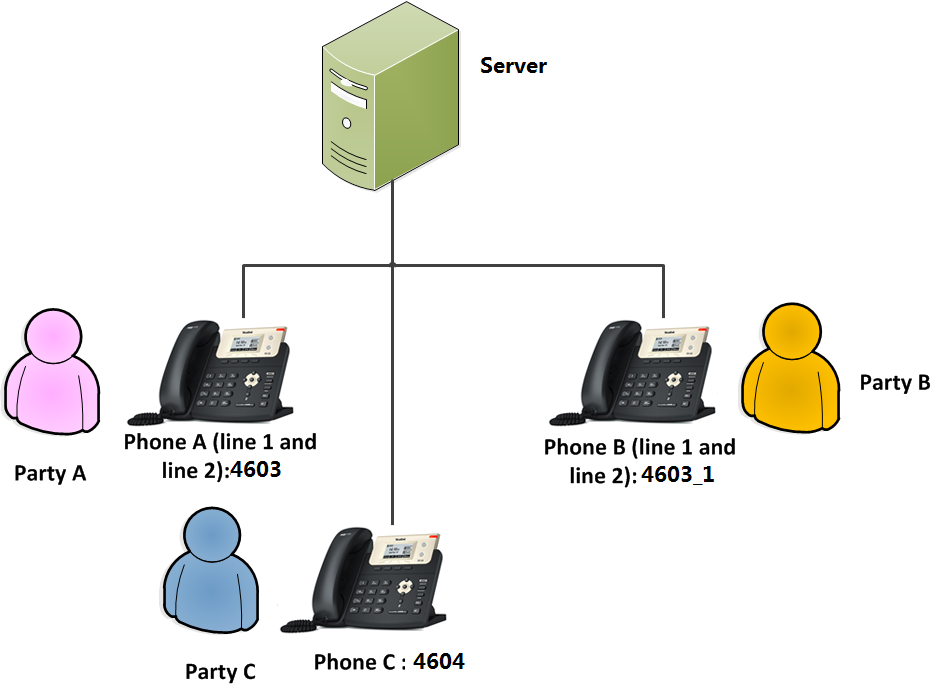
156
| Page 157 |
To configure the auto linekeys feature
you can automatically assign multiple

1.
2.
3.
via web user interface:
Click on Features->General Information.
Select Enabled from the pull-down list of Auto LineKeys.
If Auto LineKeys is enabled,
for a registered shared line on the phone.
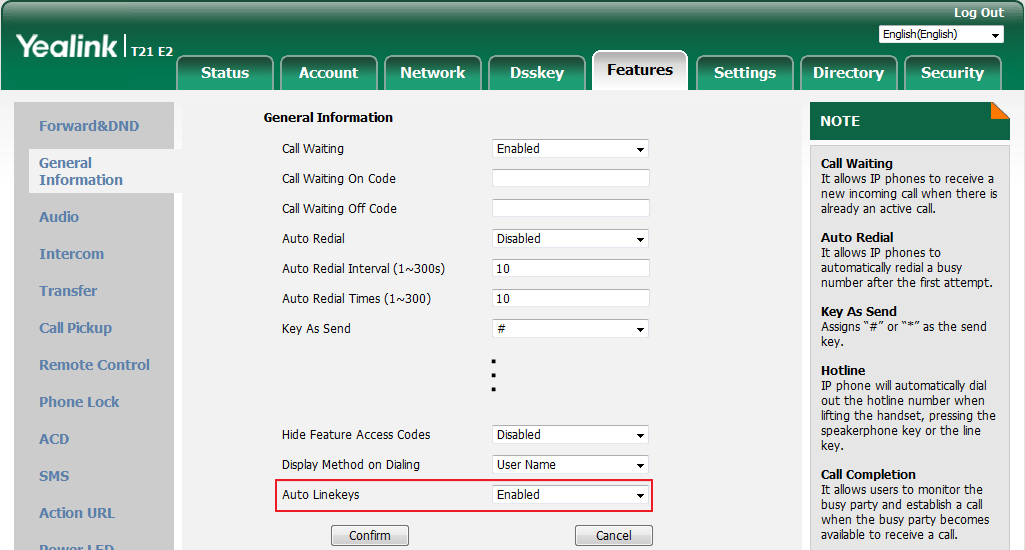
Click Confirm to accept the change.

Advanced Phone Features
DSS keys with Line type
157
| Page 158 |
User Guide for the SIP

158
-T21(P) E2 IP Phone
To configure the shared line settings and the number of line key on phone A via web user
interface:
1.
Register the primary account 4603.
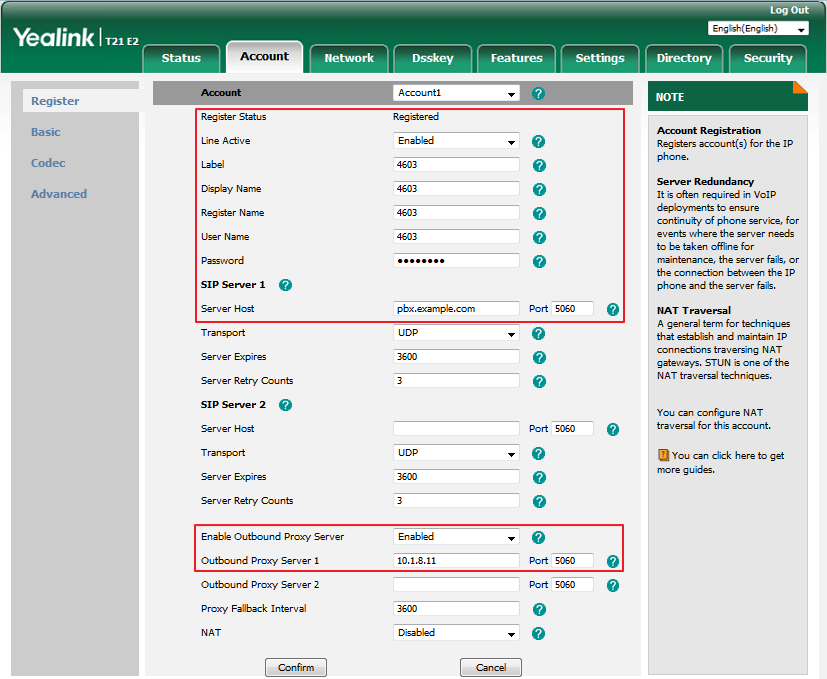

2.
Click on Advanced, and then select Shared Call Appearance from the pull-down list of
Shared Line.
3.
Enter the desired number in the Number of line key field.
This field appears only if Auto Linekeys is enabled.
| Page 159 |
Advanced Phone Features

The default value is 1. In this example, the value is set to 2.
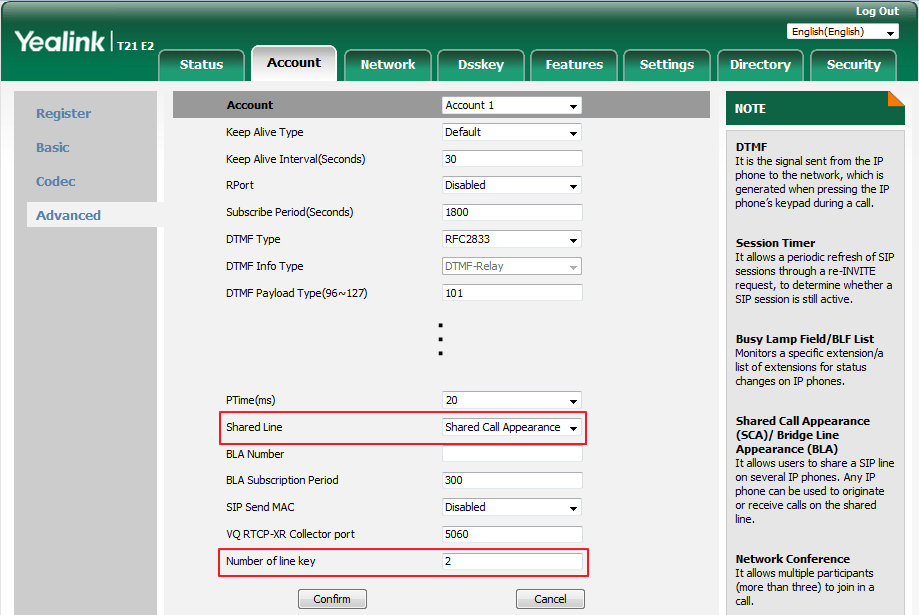

4.
Click Confirm to accept the change.
The phone A will automatically configure the line keys from the first unused DSS key, according
to the configured number in the Number of line key field.
To configure the shared line settings and the number of line key on phone B via web user
interface:
1.
Register the alternate account 4603_1.
159
| Page 160 |
User Guide for the SIP
from the pull
down list of

160
2.
3.
-T21(P) E2 IP Phone
(Enter the primary account 4603 in the Register Name field.)
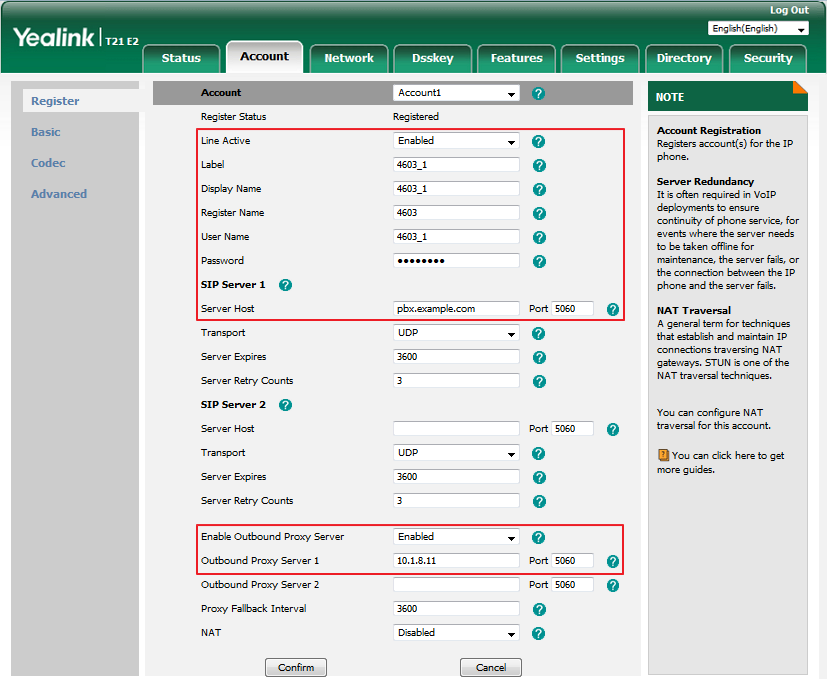
Click on Advanced, and then select Shared Call Appearance

Shared Line.
Enter the desired number in the Number of line key field.
This field appears only if Auto Linekeys is enabled.
The default value is 1. In this example, the value is set to 2.
-


| Page 161 |
Advanced Phone Features

4.
Click Confirm to accept the change.
The phone B will automatically configure the line keys from the first unused DSS key, according
to the configured number in the Number of line key field.
Configuring private hold soft key or private hold key
Public hold allows any shared line to retrieve the held call. Private hold only allows the hold
party to retrieve the held call. For example, you can retrieve the held call on either phone A or
phone B when you place a call on public hold; you can retrieve the held call only on phone A
when you place a call on private hold on phone A. By default, the private hold soft key isn’t
displayed on the LCD screen. You need to configure either the private hold soft key or a private
hold key before you place the call on private hold.
To configure the private hold soft key via web user interface:
1.
Click on Settings->Softkey Layout.
2.
Select Enabled from the pull-down list of Custom Softkey.
3.
Select On Talk from the pull-down list of Call States.
4.
Select PriHold from the Unselected Softkeys column and then click .

The PriHold appears in the Selected Softkeys column.
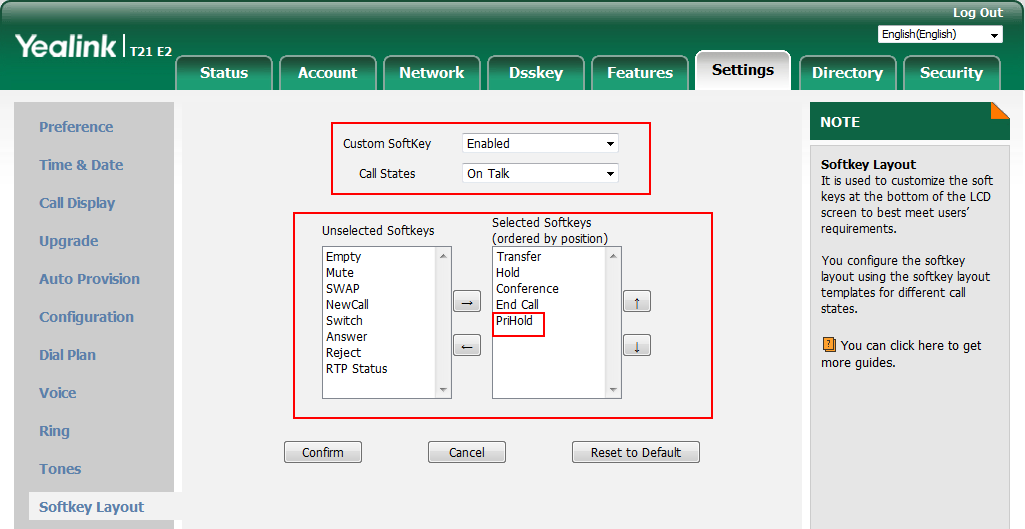

5.
Click Confirm to accept the change.
Note
Configuring the private hold soft key may affect the softkey layout in the Talking state. Contact

your administrator for more information.

To configure a private hold key via phone user interface:
1. Press Menu->Features->DSS Keys.
2. Select the desired DSS key.

3. Press or , or the Switch soft key to select Key Event from the Type field.

161
| Page 162 |
User Guide for the SIP
Using SCA Feature on the IP Phone

162
-T21(P) E2 IP Phone

4. Press or , or the Switch soft key to select Private Hold from the Key Type field.



5. (Optional.) Enter the string that will appear on the LCD screen in the Label field.
6. Press the Save soft key to accept the change or the Back soft key to cancel.
Configuring call pull feature
Call pull feature allows users to retrieve an existing call from another shared phone that is in
active or public hold status.
To configure the call pull feature access code via web user interface:
1.
Click on Account->Advanced.
2.
Select the desired account from the pull-down list of Account.
3.
Enter the call pull feature access code (e.g., *11) in the Call Pull Feature Access Code field.
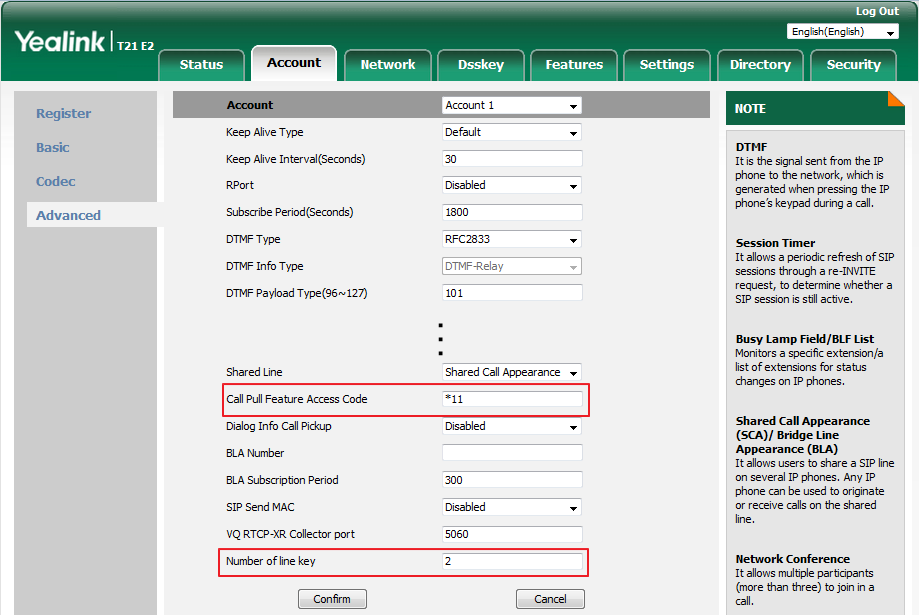

4.
Click Confirm to accept the change.
The phone will dial out “*11” automatically when you press the CallPull soft key.
This section provides you with detailed information on using the SIP-T21(P) E2 IP phone in a
| Page 163 |
Advanced Phone Features

SCA Hybrid Key System scenario. In a SCA Hybrid Key System scenario, the status of the line key
LED which associates with a shared line will change. For more information on line key LED
indicators, refer to LED Instructions on page 17.
You can do the following using the IP phone in a SCA Hybrid Key System scenario:
Placing calls
Answering calls
P
lac
ing a
call on hold
Retrieving a held call
Barg
ing
i
n
an active call
Call Pull
Placing Calls
You can have one call or multiple calls on the shared line.
To place a call on the shared line:
Do one of following:

-
Enter the desired number using the keypad when the phone is idle. Press , , or

the Send soft key.
The phone will dial the entered number using the first line key.
-
Press the line key when the phone is idle to enter the dialing screen.


Enter the desired number using the keypad and then press , , or the Send soft
key.
The phone will dial the entered number using the selected line key.
To place multiple calls on the shared line:
You can have more than one call on the shared line. To place a new call when there is an active
call on the line key 1 of phone A, do one of the following on phone A:
-
Press the Hold soft key. The original call is placed on hold.
Press the NewCall soft key to enter the dialing screen.
Enter the desired number using the keypad.


Press , , or the Send soft key.
Phone A will dial the entered number using the line key 2 automatically.
-
Press the line key. The original call is placed on hold.
Enter the desired number using the keypad.

Press , , or the Send soft key.

Phone A will dial the entered number using the selected line key.
163
| Page 164 |
User Guide for the SIP-T21(P) E2 IP Phone

Answering Calls
You can have one call or multiple calls on the shared line. Incoming calls will be distributed
evenly among the available line keys.
To answer a call on the shared line:
When an incoming call arrives on the shared line, the phone A and phone B will ring
simultaneously, and the LED indicators of the line key 1 on both phone A and phone B will flash
green. You can answer the incoming call on either phone A or phone B but not both.
Do one of the following on phone A or phone B:


-
Press the line key 1, , or the Answer soft key on phone A.
The LED indicators of the line key 1 on phone A will illuminate solid green and phone B will
illuminate solid red.


-
Press the line key 1, , or the Answer soft key on phone B.
The LED indicators of the line key 1 on phone A will illuminate solid red and phone B will
illuminate solid green.
To answer multiple calls on the shared line:
An incoming call arrives on the shared line when there is an active call on phone A’s line key 1.
The LED indicators of the line key 2 on both phone A and phone B will fast flash green. You can
answer the incoming call on either phone A or phone B. The LCD screen of phone A displays the
information of the incoming call (e.g., ”Incoming call: 4604 Yealink”).


Note
Make sure call waiting feature is enabled on phone A. For more information, refer to Call Waiting

on page 116.

Do one of the following on phone A:

-
Press the line key 2. Phone B stops ringing.
-
Press the Answer soft key. Phone B stops ringing.

-
Press to access the new call.

Press or the Answer soft key. Phone B stops ringing.
The incoming call is answered and the original call is placed on hold. The LED indicators of the
line key 1 on phone A will slowly flash green and phone B will slowly flash red indicating that
there is the held call on the line key 1. The LED indicators of the line key 2 on phone A will
164
| Page 165 |
Advanced Phone Features

illuminate solid green and phone B will illuminate solid red indicating that there is an active call
on the line key 2.
You can also answer the call on phone B. Do one of the following on phone B:
-
Press the line key 2. Phone A stops ringing.

-
Press or the Answer soft key. Phone A stops ringing.
The LED indicators of the line key 2 on phone A will illuminate solid red and phone B will
illuminate solid green indicating that there is an active call on the line key 2. Meanwhile, The LED
indicators of the line key 1 phone A will illuminate solid green and phone B will illuminate solid
red indicating that there is an active call on the line key 1.
Note
If the number of incoming calls is greater than the configured line keys, the line keys will be used

by sequence circulation.

Placing a Call on Hold

To place a call on public hold:
1.
Press the Hold soft key on phone A when party A and party C are talking.


The line key LEDs on phone A slowly flash green and phone B slowly flash red when the
shared line call is placed on hold.
To place a call on private hold:
1.
Press the PriHold soft key or private hold key on phone A when there is an active call on
the shared line (You may need to press the More soft key to see the PriHold soft key).


The line key LED slowly flashes green on phone A when the shared line call is placed on
private hold.
165
| Page 166 |
User Guide for the SIP
Retrieving a
Barging

166
-T21(P) E2 IP Phone
Held Call
To retrieve a call placed on public hold:
You can retrieve the public held call on either phone A or phone B.
To retrieve the call on phone A:
1.
Press the line key with the slow-flashing green LED indicator or the Resume soft key.
The conversation between phone A and phone C is retrieved.
To retrieve the call on phone B:
Do one of the following:
-
Press the line key with the slow-flashing red LED indicator.
-
Long press the desired line key.
The Cancel, CallPull, NewCall and Retrieve soft keys appear on the LCD screen.


Press the Retrieve soft key to retrieve the call.
The conversation is established between phone B and phone C, phone A disconnects the call.
And the line key LEDs on phone A illuminate solid red and phone B illuminate solid green.
To retrieve a call placed on private hold:
The private held call can be only retrieved by the hold party (party A).
Do one of the following:
-
Press the line key with the slow-flashing green LED indicator.
-
Press the Resume soft key on phone A.
In an Active Call
To interrupt the active call on the shared line:
If phone A has only one active call, do the following:
1.
Long press the desired line key on phone B.
| Page 167 |
You can also press
conference call with the other parties in the active call.
If phone A has more

2.
3.
1.
2.
3.
Advanced Phone Features
The Cancel, CallPull, NewCall and BargeIn soft keys appear on the LCD screen of phone
B.


Press the BargeIn soft key to interrupt the active call of phone A.
Party B will set up a conference call with the other parties in the active call.
Press the Hold or the EndCall soft key.
-
If any party in the conference call presses the Hold soft key, two-way voice can be
heard between the remaining parties.
-
If party A or party B presses the EndCall soft key, the remaining parties are still
connected. If the other party (not the shared line party) presses the EndCall soft key,
the conference call is ended.
the line key with the solid red LED indicator on phone B to set up a
than one call, do the following:
Long press the desired line key on phone B.
The list of calls appears on the LCD screen of phone B.


Press or to select the active call.


The Cancel, CallPull, NewCall and BargeIn soft keys appear when the active call is
highlighted.


Press the BargeIn soft key to interrupt the active call of phone A.
Party B may hear a warning tone and then set up a conference call with the other parties of
the active call.
167
| Page 168 |
User Guide for the SIP-T21(P) E2 IP Phone

4.
Press the Hold or the EndCall soft key.
-
If any party in the conference call presses the Hold soft key, two-way voice can be
heard between the remaining parties.
-
If party A or party B presses the EndCall soft key, the remaining parties are still
connected. If the other party (not the shared line party) presses the EndCall soft key,
the conference call is ended.
Call Pull
Call pull feature allows users to retrieve an existing call from another shared phone that is in
active or public hold status. For example, when there is a call between phone A and phone C,
you can use call pull feature on phone B to retrieve this call from phone A. Then the call is
established between phone B and phone C.
To retrieve a call from another shared phone:
If there is an active call between phone A and phone C, do the following:
1.
Long press the desired line key on phone B.
The Cancel, CallPull, NewCall and BargeIn soft keys appear on the LCD screen of phone
B.


2.
Press the CallPull soft key.
The active call has been retrieved from the phone A successfully.
If there is a held call between phone A and phone C, do the following:
1.
Long press the desired line key on phone B.
The Cancel, CallPull, NewCall and Retrieve soft keys appear on the LCD screen of phone
B.


2.
Press the CallPull soft key.
The held call has been retrieved from the phone A successfully.
168
| Page 169 |
Advanced Phone Features

Bridged Line Appearance (BLA)
BLA allows users to share a SIP line on two or more IP phones. Users can monitor the specific
extension (BLA number) for status changes on each IP phone. To use this feature, a BLA group
should be pre-configured on the server and one of them is specified as a BLA number. BLA
depends on support from a SIP server.
In the following figure, the first line is private and the second line is shared:


Any IP phone can be used to originate or receive calls on the bridged line. An incoming call to
the BLA number can be presented to multiple phones in the group simultaneously. The
incoming call can be answered on any IP phone of the group but not all.
Configuring BLA Feature on the IP Phone
You can share a BLA number on two or more phones. For example, phone A registers the
account 14019833020 and assigns BLA number, phone B registers the account 10462190020
and assigns BLA number, phone C registers the account 14755608020. Phone A and phone B
share the BLA number 14084588327.
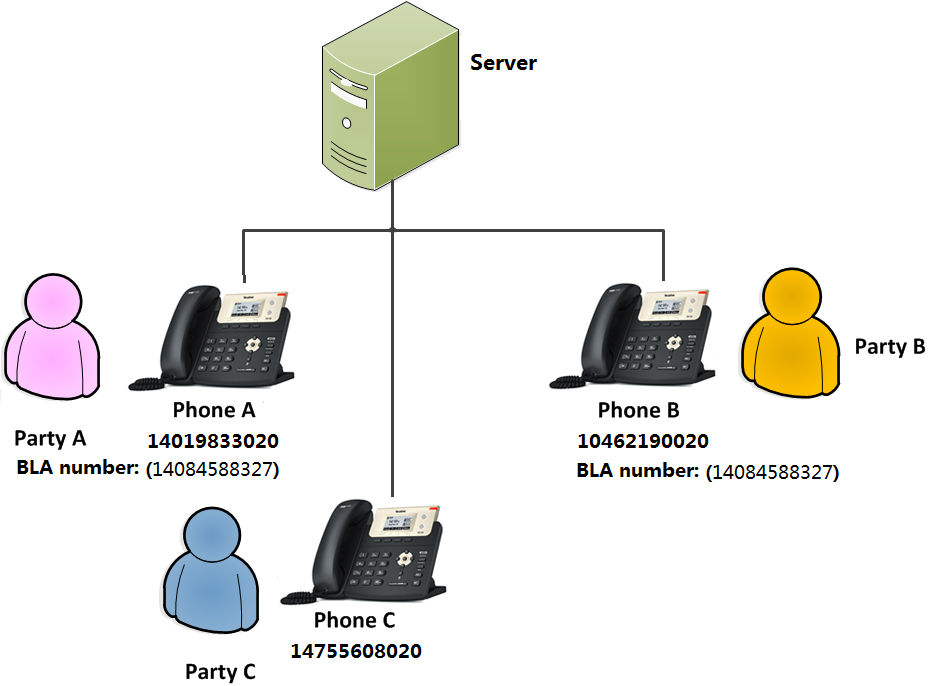
169
| Page 170 |
User Guide for the SIP-T21(P) E2 IP Phone

To register an account and configure BLA feature on phone A via web user interface:
1.
Register the account 14019833020.
2.
Click on Advanced, and then select Draft BLA from the pull-down list of Shared Line.
3.
Enter the desired number in the BLA Number field.
4.
Click Confirm to accept the change.
170
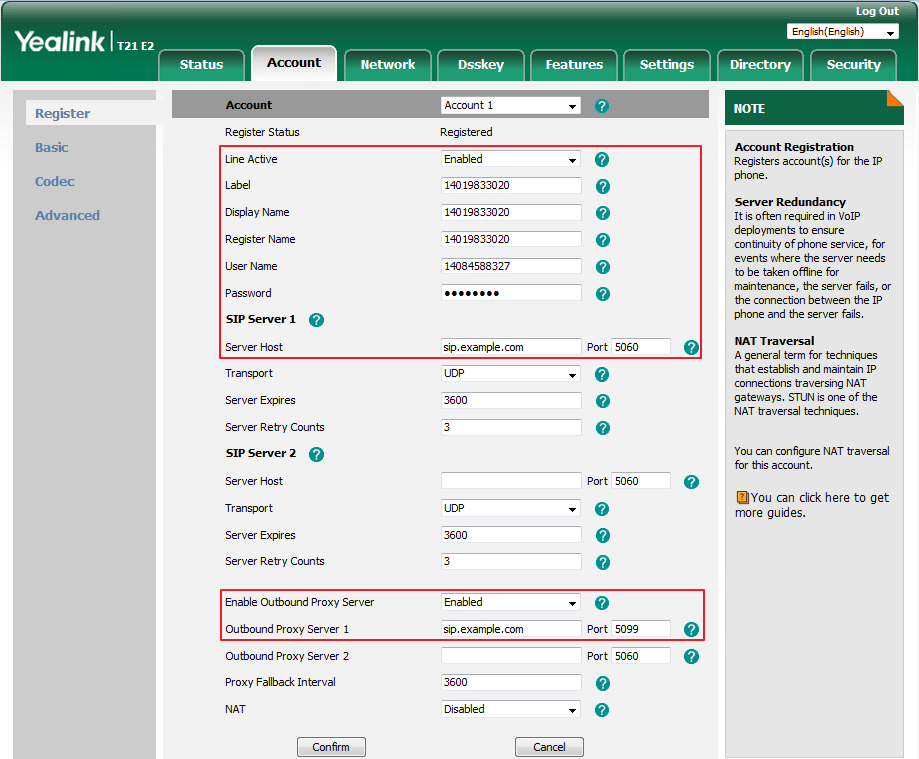

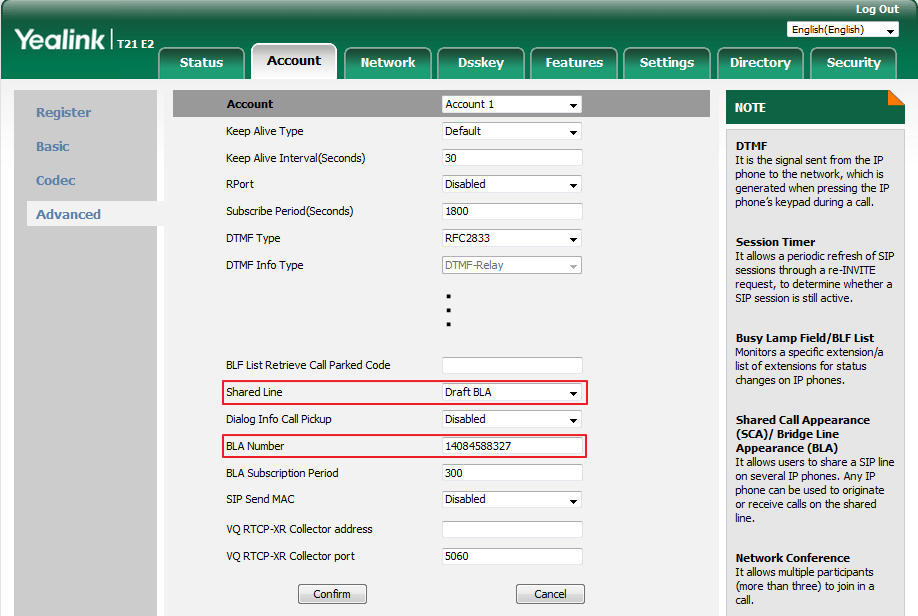

| Page 171 |
Advanced Phone Features

To register an account and configure BLA feature on phone B via web user interface:
1.
Register the account 10462190020.
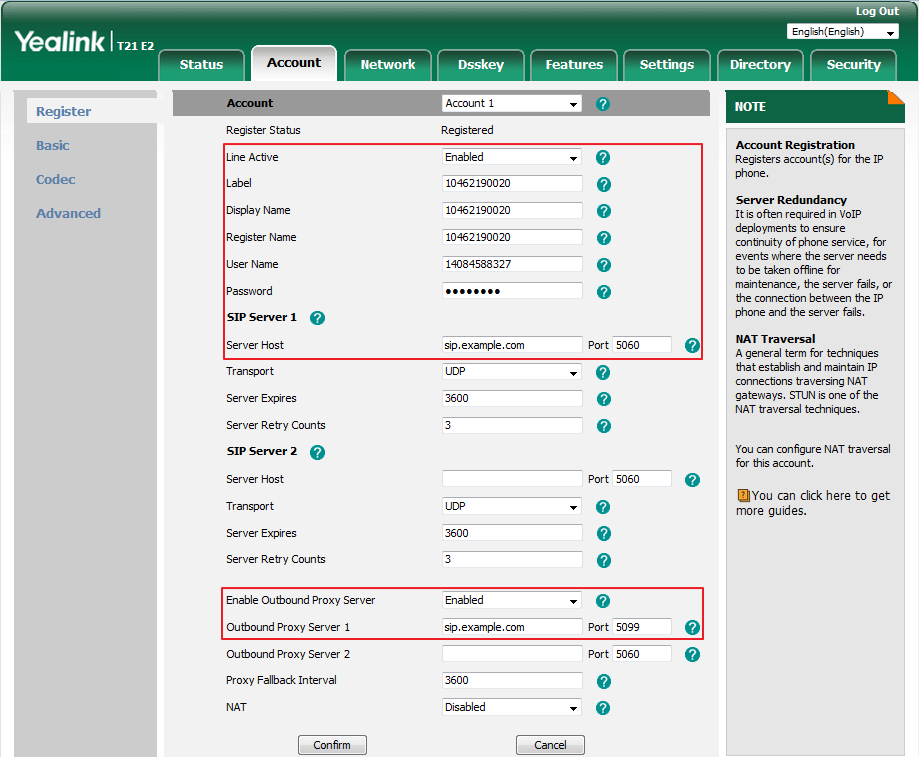

2.
Click on Advanced, and then select Draft BLA from the pull-down list of Shared Line.
3.
Enter the desired number in the BLA Number field.


4.
Click Confirm to accept the change.
171
| Page 172 |
User Guide for the SIP-T21(P) E2 IP Phone

Using BLA Feature on the IP Phone
This section provides you with detailed information on using the SIP-T21(P) E2 IP phone in a BLA
scenario. In a BLA scenario, the status of the line key LED which associates with a bridged line
will change. For more information on line key LED indicators, refer to LED Instructions on page
17.
You can do the following using the IP phone in a BLA scenario:
Placing calls
Answering
calls
Place a call on hold
Retrieving a held call
Placing Calls
You can have one call or multiple calls on the bridged line.
To place a call on the bridged line:
Do one of following:
-
Enter the desired number using the keypad when the phone is idle.


Press , , or the Send soft key.
The phone will dial the entered number.
-
Press the line key when the phone is idle to enter the dialing screen.


Enter the desired number using the keypad and then press , , or the Send soft
key.
The phone will dial the entered number.
To place multiple calls on the bridged line:
You can have more than one call on the bridged line. To place a new call when there is an active
call on phone A, do one of the following on the phone A:
-
Press the Hold soft key. The original call is placed on hold.
Press the NewCall soft key to enter the dialing screen.
Enter the desired number using the keypad.


Press , , or the Send soft key.
Phone A will dial the entered number.
-
Press the line key. The original call is placed on hold.
Enter the desired number using the keypad.

Press , , or the Send soft key.

Phone A will dial the entered number.
172
| Page 173 |
Advanced Phone Features

Answering Calls
When the phone C dials the BLA number “14084588327”, an incoming call will arrive on the
bridged line. The phone A and phone B ring simultaneously and the LED indicators of the line
key on both phone A and phone B will flash green. You can answer the incoming call on either
phone A or phone B but not both.
Do one of the following on phone A or phone B:

-
Press , or the Answer soft key on phone A.

Phone B stops ringing. The LED indicator of the line key on the phone A will illuminate solid
green. At the meanwhile, the LED indicator of the line key on the phone B will illuminate
solid red indicating that there is an active call on the phone A.

-
Press , or the Answer soft key on phone B.

Phone A stops ringing. The LED indicator of the line key on the phone B will illuminate solid
green. At the meanwhile, the LED indicator of the line key on the phone A will illuminate
solid red indicating that there is an active call on the phone B.
Placing a Call on Hold
To place a call on hold:
1.
Press the Hold soft key on phone A when party A and party C are talking.
The line key LEDs on phone A slowly flash green and phone B slowly flash red when the
bridged line call is placed on hold.
Retrieving a Held Call
If there is a held call between phone A and phone C, you can retrieve a held call on either phone
A or phone B.
To retrieve the held call on phone A:
1.
Press the line key with the slow-flashing green LED indicator or the Resume soft key on
phone A.
The conversation between phone A and phone C is retrieved.
To retrieve the held call on phone B:
1.
Press the line key with the slow-flashing red LED indicator on phone B.
The conversation is established between phone B and phone C, phone A disconnects the
call.
173
| Page 174 |
User Guide for the SIP
Messages
Short Message Service (SMS)

Note
Note
Note
174
-T21(P) E2 IP Phone
You can send and receive text messages using the SIP-T21(P) E2 IP phone. New text messages
can be indicated both acoustically and visually. When receiving a new text message, the phone
will play a warning tone. The power indicator LED will slowly flash red, and the LCD screen will
prompt “n New Text Message(s)” (“n” indicates the number of unread text messages. e.g., 1 New
Text Message(s)) and a flashing icon .



When the phone receives a text message, the text message
prompt window
will pop up by

default. If you want to disable this feature, contact your system administrator for more
information.

You can store text messages in your phone’s Inbox, Sentbox, Outbox or Draftbox. Each of the
boxes can store up to 100 text messages. If the number of the text messages in one box is more
than 100, the phone will directly delete the oldest text message in the box.
SMS is not available on all servers. Contact your system administrator for more information.


To read a text message:
1.
Press Menu->Message->Text Message->Inbox.


2.
Select the desired message and then press the View soft key.
If the phone prompts receiving new text messages, you can also press the View soft key to read


the new messages directly.
| Page 175 |
Advanced Phone Features

To send a text message:
1.
Press Menu->Message->Text Message->New Message.
2.
Compose the new text message. You can press the abc soft key to change the input mode.


3.
Press the Send soft key after completing the content.

4.
(Optional.) Press or , or the Switch soft key to select the desired account from

the From field.
5.
Enter the number you want to send the message to in the To field.
6.
Press the Send soft key to send the message or the Back soft key to cancel.
Sending a text message is configurable via web user interface at the path Features->SMS.
To reply a text message:
1.
Press Menu->Message->Text Message->Inbox.
2.
Select the desired message and then press the Reply soft key.
3.
Compose the new text message. You can press the abc soft key to change the input mode.


4.
Press the Send soft key after completing the content.
5.
Check the From and To fields, and then press the Send soft key.
To delete a text message:
1.
Press Menu->Message->Text Message->Inbox (Sentbox, Outbox or Draftbox).
2.
Select the desired message and then press the Delete soft key.


3.
Select Delete to delete the desired message, then press the OK soft key.
175
| Page 176 |
User Guide for the SIP
Voice Mail

Note
Note
176
-T21(P) E2 IP Phone
The LCD screen prompts “Delete the selected message?”.


4.
Press the OK soft key to delete this message or the Cancel soft key to cancel.
You can also delete all text messages by pressing the Delete soft key and then select Delete All.
For more information, refer to the above steps.
You can also delete a specific message by pressing the Delete soft key after viewing.


You can leave voice mails for someone else using the SIP-T21(P) E2 IP phone. You can also listen
to voice mails that are stored in a voice mailbox. This feature is set up on the server side. It is not
available on all servers.
When receiving a new voice mail, the phone will play a warning tone. The power indicator LED
will slowly flash red, and the LCD screen will prompt “n New Voice Mail(s)” (“n” indicates the
number of unread voice messages, e.g., 27 New Voice Mail(s)) and a flashing icon .



If the voice mail pop-up message box disappears, it won't pop up again unless the user receives
a new voice mail or the user re-registers the account that has unread voice mail(s).
You can configure the phone not to display the pop-up prompt, contact your system

administrator for more information.

To leave a voice mail:
You can leave a voice mail for someone else when he/she is busy or inconvenient to answer the
call. Follow the voice prompt from the system server to leave a voice mail, and then hang up.
To configure voice mail access codes via phone user interface:
1.
Press Menu->Message->Voice Mail->Set Voice Mail Code.
2.
Press the navigation keys to highlight the account which you want to set.
| Page 177 |
Advanced Phone Features

3.
Press the 123 soft key to select the proper input mode and then enter the voice mail
access code (e.g., *97).


4.
Press the Save soft key to accept the change or the Back soft key to cancel.
Note
Voice mail access codes must be predefined on the system server. Contact your system

administrator for the more information.

To listen to voice mails:

1.
When the LCD screen prompts that the phone receives a new voice mail and the power

indicator LED slowly flashes red, you can press or the Connect soft key to dial out
the voice mail access code.
2.
Follow the voice prompt to listen to your voice mails.
Note
Before listening to voice mails, make sure the voice mail access code has been configured.

When all new voice mails are retrieved, the power indicator LED will go out.

To view the voice mail via phone user interface:
1.
Press Menu->Message->Voice Mail->View Voice Mail.
The LCD screen displays the amount of new and old voice mails.


2.
Select an account and then press the Connect soft key to listen to voice mails.
Message Waiting Indicator (MWI)
The SIP-T21(P) E2 IP phone supports MWI when receiving a new voice message. If someone
leaves you a voice mail, you will receive a message waiting indicator. MWI will be indicated in
three ways: a warning tone, an indicator message (including a voice mail icon) on the LCD screen,
and the power indicator LED slowly flashes red. This will be cleared when you retrieve all voice
177
| Page 178 |
User Guide for the SIP

Note
Note
178
-T21(P) E2 IP Phone
mails or delete them.
The MWI service is unsolicited for some servers, so the SIP-T21(P) E2 IP phone only handles the
MWI messages sent from the server. But for other servers, the MWI service is solicited, so the
SIP-T21(P) E2 IP phone must enable subscription for MWI.
MWI service is not available on all servers. Contact your system administrator for more

information.

The MWI subscription parameters you need to know:

Options
Description


Subscribe for MWI
Enable or disable a subscription for MWI service.


MWI Subscription Period
Period of MWI subscription.
SUBSCRIBE request before initial SUBSCRIBE expiration.
The IP phone sends a refresh


Enable or disable a subscription to the voice mail number for


Subscribe MWI To Voice
MWI service.


Mail
To use this feature, you should also configure the voice mail


number.

The phone will send SUBSCRIBE messages for the MWI service to the account or the voice

number MWI service depending on the server. Contact your system administrator for more

information.

To configure subscribe for MWI via web user interface:

1.
Click on Account->Advanced.

2.
Select the desired account from the pull-down list of Account.

3.
Select Enabled from the pull-down list of Subscribe for MWI field.





























| Page 179 |
Advanced Phone Features

4.
Enter the period time in the MWI Subscription Period(Seconds) field.
5.
Click Confirm to accept the change.
The IP phone will subscribe to the account number for MWI service by default.
To enable subscribe MWI to voice mail via web user interface:
1. Click on Account->Advanced.
2. Select the desired account from the pull-down list of Account.
3. Select Enabled from the pull-down list of Subscribe for MWI.
4. Select Enabled from the pull-down list of Subscribe MWI To Voice Mail.
5. Enter the desired voice mail number in the Voice Mail field.
6. Click Confirm to accept the change.
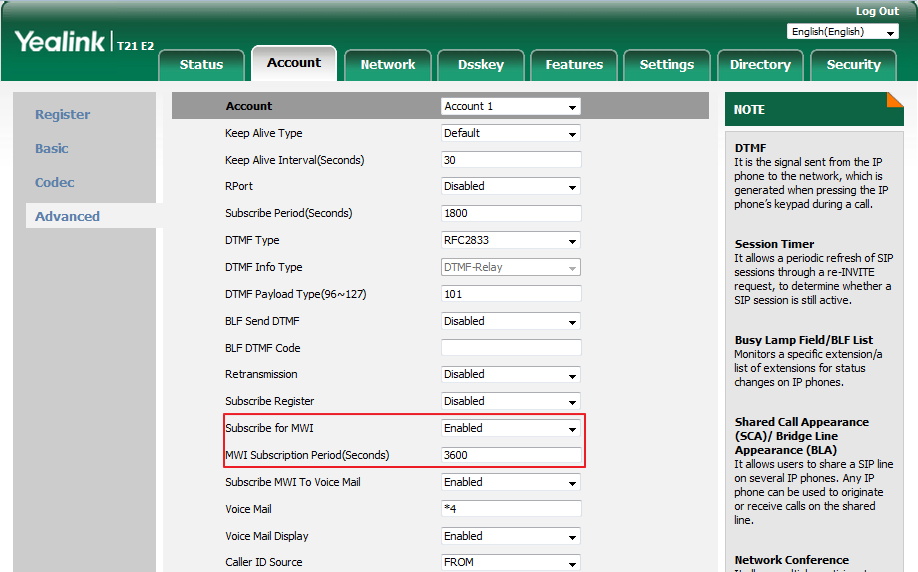

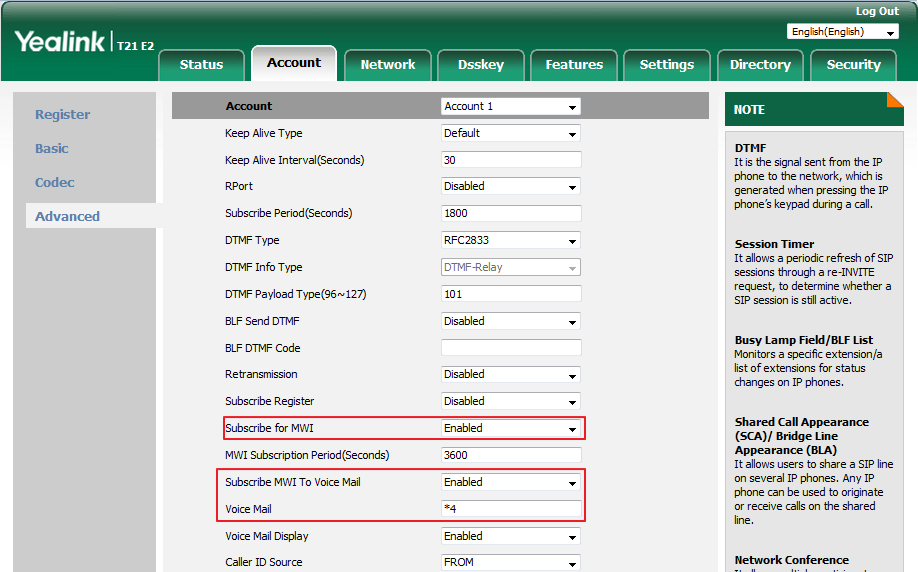

179
| Page 180 |
User Guide for the SIP-T21(P) E2 IP Phone

The IP phone will subscribe to the voice mail number for MWI service using Subscribe MWI
To Voice Mail.
Note
MWI subscription is configurable via web user interface only.


180
| Page 181 |
Appendix
Appendix A
Time Zones


–
Time Zone


-11


-10

-9:30

-9

-8

-7

-6

-5

-4:30

-4

-3:30

-3

-2:30

-2

-1

0

+1

+2

+3

+3:30

+4

+4:30

+5

+5:30

+5:45

+6

+6:30

+7

+8

+8:45

+9
Appendix
Time Zone Name


Samoa


United States-Hawaii-Aleutian, United States-Alaska-Aleutian


French Polynesia


United States-Alaska Time

Canada(Vancouver,Whitehorse), Mexico(Tijuana,Mexicali), United

States-Pacific Time

Canada(Edmonton,Calgary), Mexico(Mazatlan,Chihuahua), United

States-MST no DST, United States-Mountain Time

Canada-Manitoba(Winnipeg), Chile(Easter Islands), Mexico(Mexico

City,Acapulco), United States-Central Time

Bahamas(Nassau), Canada(Montreal,Ottawa,Quebec), Cuba(Havana),

United States-Eastern Time

Venezuela(Caracas)

Canada(Halifax,Saint John), Chile(Santiago), Paraguay(Asuncion),

United Kingdom-Bermuda(Bermuda), United Kingdom(Falkland

Islands), Trinidad&Tobago

Canada-New Foundland(St.Johns)

Argentina(Buenos Aires), Brazil(DST), Brazil(no DST),

Denmark-Greenland(Nuuk)

Newfoundland and Labrador

Brazil(no DST)

Portugal(Azores)

Denmark-Faroe Islands(Torshavn), GMT, Greenland, Ireland(Dublin),

Morocco, Portugal(Lisboa,Porto,Funchal), Spain-Canary Islands(Las

Palmas), United Kingdom(London)

Albania(Tirane), Austria(Vienna), Belgium(Brussels),

Caicos, Chad, Croatia(Zagreb), Czech Republic(Prague),

Denmark(Kopenhagen), France(Paris), Germany(Berlin),

Hungary(Budapest), Italy(Rome), Luxembourg(Luxembourg),

Macedonia(Skopje), Namibia(Windhoek), Netherlands(Amsterdam),

Spain(Madrid)

Estonia(Tallinn), Finland(Helsinki), Gaza Strip(Gaza), Greece(Athens),

Israel(Tel Aviv), Jordan(Amman), Latvia(Riga), Lebanon(Beirut),

Moldova(Kishinev), Romania(Bucharest), Russia(Kaliningrad),

Syria(Damascus), Turkey(Ankara), Ukraine(Kyiv, Odessa)

East Africa Time, Iraq(Baghdad), Russia(Moscow)

Iran(Teheran)

Armenia(Yerevan), Azerbaijan(Baku), Georgia(Tbilisi),

Kazakhstan(Aktau), Russia(Samara)

Afghanistan(Kabul)

Kazakhstan(Aqtobe), Kyrgyzstan(Bishkek), Pakistan(Islamabad),

Russia(Chelyabinsk)

India(Calcutta)

Nepal(Katmandu)

Kazakhstan(Astana, Almaty), Russia(Novosibirsk,Omsk)

Myanmar(Naypyitaw)

Russia(Krasnoyarsk), Thailand(Bangkok)

Australia(Perth), China(Beijing), Russia(Irkutsk, Ulan-Ude),

Singapore(Singapore)

Eucla

Japan(Tokyo), Korea(Seoul), Russia(Yakutsk,Chita)























































































































































































181
| Page 182 |
User Guide for the SIP
T21(P) E2 IP Phone

182
-
Time Zone


+9:30


+10

+10:30

+11

+11:30

+12

+12:45

+13

+13:30

+14
Time Zone Name


Australia(Adelaide), Australia(Darwin)


Australia(Brisbane), Australia(Hobart),


Australia(Sydney,Melboume,Canberra), Russia(Vladivostok)


Australia(Lord Howe Islands)

New Caledonia(Noumea), Russia(Srednekolymsk Time)

Norfolk Island

New Zealand(Wellington,Auckland), Russia(Kamchatka Time)

New Zealand(Chatham Islands)

Tonga(Nukualofa)

Chatham Islands

Kiribati












































































| Page 183 |

Appendix B – Menu Structure
Appendix
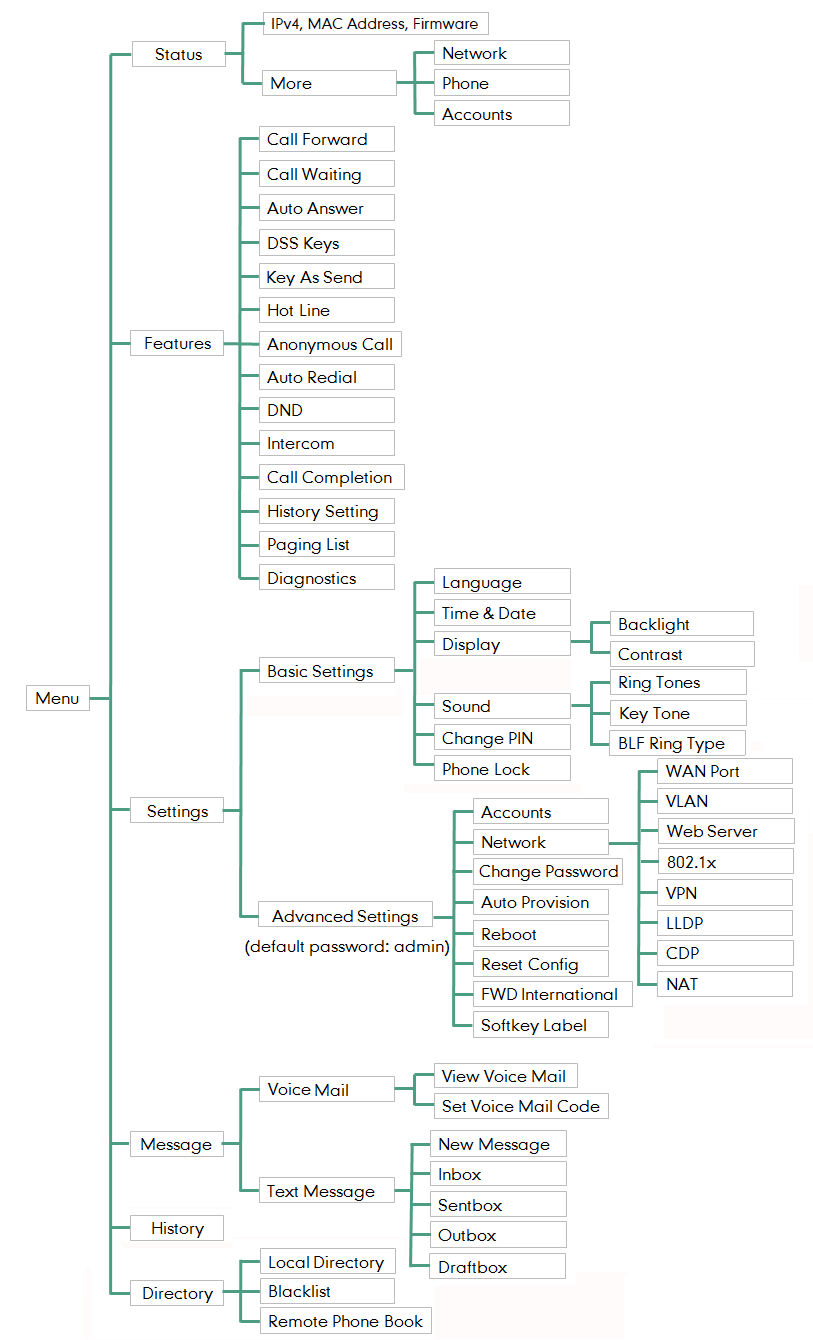
183
| Page 184 |
User Guide for the SIP-T21(P) E2 IP Phone

184
| Page 185 |

Index
A
About This Guide v
Accessing the Remote Phone Book 62
Account Management 79
Account Registration 79
Adding a Contact to the Local
Directory/Blacklist 64
Adding Contacts 53
Adding Groups 51
Administrator password 42
Advanced Phone Features 131
Anonymous Call 129
Anonymous Call Rejection 130
Answering Calls 92
Appendix A – Time Zones 181
Area Code 84
Attended Transfer 115
Attaching Stand 25
Audio Settings 46
Auto Answer 93
Auto Redial 96
Automatic Call Distribution (ACD) 154
B
Backlight 38
Basic Call Features 89
Basic Network Settings 30
Blacklist 59
Blind Transfer 113
BLF List 138
Block Out 85
Bridged Line Appearance (BLA) 169
Busy Lamp Field (BLF) 131
C
Call Completion 97
Call Forward 104
Call History Management 63
Call Hold/Resume 99
Call Mute 98
Call Park/Retrieve 120
Call Pickup 120
Call Recording 140
Call Transfer 112
Call Waiting 116
Conference 117
Configuring a Record Key 140
Configuring a URL Record Key 141
Configuring an Access URL 61
Configuring an Intercom Key 144
Index

Configuring BLA Feature on the IP Phone 169
Configuring SCA Feature on the IP Phone
156
Configuring the Intercom Features on the IP
Phone 144
Contact Management 49
Contrast 38
Customizing Your Phone 35
D
Deleting Contacts 56
Deleting Groups 53
Deleting History Records 64
Dial Now 83
Dial Plan 80
Directory 50
Disabling History Record 65
Do Not Disturb (DND) 100
Documentations 22
DSS Keys 69
Dual Headset 69
Dynamic Forwarding 112
E
Editing Contacts 55
Editing Groups 52
Emergency Number 86
Ending Calls 93
Entering Data and Editing Fields 32
F
Features Status Icons 15
G
General Settings 35
Getting Started 23
H
Hardware Component Instructions 13
Headset Mode Activation/Deactivation 67
Headset Prior 68
Headset Use 67
Hot Desking 142
Hotline 87
I
Icon Instructions 15
Idle Screen 32
185
| Page 186 |
User Guide for the SIP-T21(P) E2 IP Phone

Importing/Exporting Contact lists 58
In This Guide v
Incoming Intercom Calls 144
Intercom 143
K
Key As Send 42
Key Tone 49
L
Language 39
LED Instructions 17
Line Keys 69
Line Key Icons 15
Live Dialpad 87
Local Conference 117
Local Directory 51
Logo Customization 66
M
Messages 174
Message Waiting Indicator 177
Multicast Paging 147
Music on Hold (MoH) 153
N
Network Conference 118
O
Optional Accessories 24
Other Icons 16
Overview 13
P
Packaging Contents 23
Phone Initialization 28
Phone Installation 25
Phone Lock 43
Phone Status 28
Phone User Interface 19
Picking up an Incoming Call of the Target
Extension 146
Placing a Call from History Records 63
Picking up an Incoming Call of the Target
Extension 146
Placing Calls 89
Placing Calls to Contacts 57
Power Saving 35
Programable Keys 77
R
Recall 98
Receiving RTP Stream 150
186
Recent Call In Dialing 94
Recording a Call 141
Redialing Numbers 94
Registration 31
Remote Phone Book 61
Replace Rule 81
Ring Tones 47
S
Search Source List in Dialing 65
Searching for Contacts 57
Semi-attended Transfer 115
Sending RTP Stream 147
Shared Call Appearance (SCA) 156
Short Message Service (SMS) 174
Static Forwarding 105
Summary of Changes v
System Customizations 66
T
Table of Contents ix
Time and Date 40
U
User Interfaces 19
Using BLA Features on the IP Phone 172
Using Intercom 146
Using Multicast Paging 152
Using SCA Features on the IP Phone 162
V
Viewing History Records 63
Voice Mail 176
Volume 46
W
Warranty ii
Web User Interface 19